June 2024


DRAFT
We respectfully acknowledge that the urban forest is located on the unceded lands of SnPink’tn, a Syilx (Okanagan) community.
Context on the land acknowledgement
The City of Penticton has prepared this Urban Forest Management Plan to address current and projected challenges for trees and natural forests in the City. The Plan is written from a perspective that promotes recognition of the “asset” or “service” value of trees and problematizes issues for prioritization by short-term management. This perspective can be at odds with Syilx perspectives on the urban forest, which emphasize the nature of trees as part of tmix w – all living things and our relations. The 20-year horizon of the Urban Forest Management Plan is not a replacement for a multi-generational understanding of the innate value of trees and forest ecosystems in this landscape. Consultation with Penticton i ndian Band representatives raised this difference in worldviews as an important preface for contextualizing the Plan.
i City of Penticton | Urban Forest Management Plan (DRAFT - JUNE 2024)
Acknowledgements
We want to thank everyone who contributed to the Urban Forest Management Plan through online and in-person public engagement opportunities, reaching out to City and project staff, and advocating for public perspectives on the City’s urban forest to inform the Plan recommendations. There would be no Urban Forest Management Plan without your participation.
Report Credits
Prepared by the City of Penticton with the support of Diamond Head Consulting Ltd.
Consultants:
Matthew Shields, R.P.F., iSA Certified Arborist®
Amelia Needoba, P.M.P., iSA Certified Arborist®
Vlad Romanescu
Nguyet-Anh Nguyen
Marco Sanelli
Gerlissa Chan
Cindy Cheng
ii City of Penticton | Urban Forest Management Plan (DRAFT - JUNE 2024)
Glossary
Abiotic disturbance A discrete physical event in the environment, like a windstorm, heatwave, or wildfire, that directly damages trees and vegetation leading to a loss of plant biomass.
Agricultural/rural trees Trees located on agricultural and rural property where landscapes are maintained, including orchard trees, shade trees, and windrows.
Asset class In asset management, a group of similar objects provided with the same service levels for management activities.
Biodiversity The variety of lifeforms and their interactions within an area, or on Earth.
Biogeoclimatic ecosystem classification
The “BEC” system of zones divides the province of BC into areas of similar vegetation potential based on climate and regional factors. It is a tool for categorizing the province’s natural vegetation communities, two of which are historically found in Penticton: the Bunchgrass and Ponderosa Pine zones.
Biomass The quantity of organisms in any area or volume.
Biotic disturbance The effects of biological agents such as insects, fungi, or humans, occurring such that they can reasonably be considered a discrete event, that directly damage trees and vegetation leading to a loss of plant biomass.
Canopy cover The area of the ground that is obscured by tree stems, branches and foliage, when viewed from above. Canopy cover is frequently expressed as a percent of an overall area, e.g., 100% canopy cover means that trees cover all of a particular portion of ground.
cikilax wm Cultural fire management as practiced by the Syilx (Okanagan) people.
Diameter at breast height (dbh)
The diameter through the centre of a tree’s stem, measured at 1.3 m along the stem above the high side of the tree’s connection to the ground.
Evapotranspiration The process by which water is transferred from the land to the atmosphere by evaporation from soil and surfaces and by transpiration from plants.
Genus The taxonomic level directly above species; a closely related group of species sharing a common ancestor, e.g., Acer (Maple), Pinus (Pine), or Populus (Poplar). Species scientific names are the combination of genus and a unique species identifier, e.g., Acer platanoides (Norway maple).
Greenfield development Urban development that converts natural or rural landscapes and land uses into urban ones.
iii City of Penticton | Urban Forest Management Plan (DRAFT - JUNE 2024)
Green infrastructure Any natural assets as well as designed or engineered elements created to mimic natural functions and processes that provide service value in relation to human interests.
Hardscape A landscape dominated by impermeable surfaces. Most urban landscapes have characteristics of hardscape.
Impermeable or impervious surface A surface that does not allow water or gas exchange between the environment and underlying soils, like concrete or asphalt.
LiDAR Light Detection and Ranging (LiDAR), an aerial or satellite survey technology that uses invisible signals of light to remotely measure surface height and area.
Natural asset A component of the natural environment that is of demonstrated value to society.
Natural forests Unmaintained landscapes where indigenous tree species form a dominant vegetation cover, or forested areas specifically managed to promote natural ecosystem characteristics.
nsyilxcәn The language of the Syilx (Okanagan) people.
Service level In asset management, a description of a management activity for an asset class and when or how frequently the activity occurs.
SnPink’tn The preferred nsyilxcәn name of members of the Penticton Indian Band; the origin of the City of Penticton’s modern name.
tmix w (Timixw) The community of all living things, as known to Syilx (Okanagan) people.
Tree equity When every person living in the city has access to the urban forest ecosystem services they need.
Tree inventory A record of trees within a specific area.
Urban forest Every tree within the municipal boundary of Penticton.
Urban forest program A collective description of the policies, procedures, resources used for urban forest management activities and the City staff undertaking those activities in the City.
Urban heat island The physical effect by which highly paved areas in cities trap heat, leading to higher ambient temperatures than in surrounding rural lands.
Urban trees Trees located in streets, yards, landscaped parks, and other urban developed property outside agricultural areas.
i V City of Penticton | Urban Forest Management Plan (DRAFT - JUNE 2024)
V City of Penticton | Urban Forest Management Plan (DRAFT - JUNE 2024) Contents GLOSSARY III PLAN IN BRIEF VI INTRODUCTION 1 1.1 Why is the Plan needed? .............................................. 3 BACKGROUND AND CONTEXT 4 2.1 Urban forest benefits ................................................... 5 2.2 Why manage the urban forest? .................................. 7 2.3 Forest fundamentals: geography and climate ........ 8 2.4 A brief history of the urban forest ........................... 12 STATUS AND TRENDS 17 3.1 Urban forest extent .................................................... 18 3.2 Urban forest structure ................................................ 24 3.3 Land use and the urban forest ................................. 28 3.4 Tree equity.................................................................... 32 3.5 Who manages the urban forest ................................ 34 PENTICTON’S URBAN FOREST PROGRAM 36 4.1 Tree asset classes ........................................................ 37 4.2 Policies .......................................................................... 38 4.3 Budget and resources ................................................ 40 4.4 Program report card ................................................... 41 WHAT THE FUTURE HOLDS 43 5.1 Our challenges ............................................................. 44 5.2 Reconciliation with Indigenous People .................. 54 VISION FOR THE FUTURE 56 6.1 What we heard ............................................................. 57 6.2 Vision statement ......................................................... 62 6.3 Scenario planning ....................................................... 63 ACTION PLAN 67 7.1 Goals and strategies .............................................. 68 7.2 Implementation table ........................................... 69 7.3 Monitoring .............................................................. 84 REFERENCES 86
Plan in Brief
Penticton’s urban forest includes every tree within the municipal boundary, encompassing trees in natural forests, agricultural areas, and urban neighbourhoods. The urban forest is part of our cultural landscape and provides benefits to the community called ecosystem services, including shade and cooling, soil stabilization, clean air and water, carbon sequestration and storage, nourishing food, and peaceful places to visit and recreate.
However, trees in Penticton face challenges from changing climate to development-related tree loss to the cumulative impacts of a busy events calendar on City parks and gardens. This document, the City’s first Urban Forest Management Plan, sets a direction for conserving and building our urban forest for the next 20 years and beyond.
Two phases of public engagement, conversations with interested parties, and consultation with Penticton i ndian Band representatives informed the Urban Forest Management Plan. Themes that emerged through engagement included concern about tree loss impacting quality of life, need for the City to lead by example in tree retention and management, and the potential for urban forestry to strengthen relationships between the City and the Penticton i ndian Band and Syilx (Okanagan) people more broadly.
The Vision:
Our urban forest vision is to keep our community healthy, beautiful, and green. Our urban forest is growing because of the care we give and the value we place on it. Our actions today are building a resilient future for the urban forest that we can be proud of across cultures and generations.
i n 2020, 17% of the city’s land area was covered by tree canopy. Penticton’s urban forest is unevenly distributed, with natural areas contributing 70% of the total urban forest cover, while urban neighbourhoods have canopy cover of just 12%. Low canopy cover in Penticton’s urban areas is problematic because it means few residents have adequate access to the ecosystem service value of trees. While
Penticton’s semi-arid ecosystems naturally have fewer trees than coastal British Columbia, they still support the city’s urban forest. Penticton’s natural forests face challenges likely to reduce future canopy cover, including shifting climate and soil moisture, the threat of wildfire, and some development. The City will need to increase the tree canopy in urban areas to improve the urban forest where people live while sustaining the city-wide supply of urban forest ecosystem services by enhancing stewardship of natural forests.
The Urban Forest Management Plan presents three scenarios compared to the status quo (Scenario 1). Although the rate of tree loss city-wide is not currently known, estimates for City property show that under the status quo policies and resources, the rate of tree planting is estimated to be less than the rate of tree removal, resulting in a decrease of Penticton’s urban forest canopy from 17% to 16% by 2045.
100 Scenario 1: Status Quo
i n Scenario 1, policies and resourcing for urban forest management remain similar to recent years.
City-wide canopy in 2045: 16% (-1%)
Three alternative scenarios are proposed:
100 Scenario 2: No Net Loss
i n Scenario 2, the City improves planting and extends the lifespan of trees on public property to offset ongoing losses from private property.
City-wide canopy in 2045: 17% (=)
100 Scenario 3: Urban Forest Expansion
i n Scenario 3, new tree protections on private property help reduce the rate of tree loss while rates of tree planting are increased on public and private property.
City-wide canopy in 2045: 18% (+1%)
100 Scenario 4: Green Future
i n Scenario 4, tree canopy and planting targets are incorporated into development regulations to spur new tree planting additional to programs in scenario 3, which could double tree canopy in urban areas towards the end of the century.
City-wide canopy in 2045: 18% (+1%)
Canopy in urban land uses by 2085: 25% (+13%)
V i City of Penticton | Urban Forest Management Plan (DRAFT - JUNE 2024)
Recommendation:
The Urban Forest Management Plan recommends Scenario 4: Green Future to achieve the vision statement. This recommendation reflects what we heard through the first phase of public engagement and best responds to the desire to preserve and increase the urban forest throughout Penticton.
The path to Scenario 4: Green Future is laid out in the Urban Forest Management Plan. The Action Plan (Chapter 7) provides 4 Goals, 13 Strategies, and 92 Actions to implement, coded by scenario, departmental leadership, approximate cost, and implementation priority. Complementing the goals, strategies, and actions are other components of the Plan’s strategic framework: the vision statement, principles for management, and targets and performance measures intended for monitoring implementation. The Action Plan and strategic framework are grounded in factfinding and the results of community engagement.
Goals for Penticton’s Urban Forest
The four goals of the Urban Forest Management Plan are:
1. Plan, protect, and plant to expand the urban forest.
2. Manage for tree health and longevity.
3. Enhance partnerships and public outreach to increase awareness and capacity for urban forest management.
4. Monitor progress and adapt management to changing circumstances.
Strategies under each goal group interrelated Actions. The Goals, Strategies, and Actions map out a detailed path toward Scenario 4: Green Future, but the Action Plan can also be used to achieve any alternative scenario.
Supporting Implementation
Each of the alternative scenarios presented by the Urban Forest Management Plan carries significant implications for resourcing and staff time. Financial estimates supported the development of the Urban Forest Management Plan and showed that an increase of two to four times current resourcing for urban forest management is needed to fully implement any of the alternative scenarios. The growth in costs reflects underinvestment in the urban forest relative to other asset classes in the city. Cost recovery and external funding sources can help implement the Urban Forest Management Plan in a fiscally prudent manner.
Urban Forest Management Plan
Setting the Stage Emerging Directions
SCENARIOS
PRINCIPLES
GOALS
STRATEGIES ACTIONS
TARGETS + MEASURES
V ii City of Penticton | Urban Forest Management Plan (DRAFT - JUNE 2024)
WHAT WE HEARD CURRENT
VISION
CONTEXT MAPPING + ANALYSIS
Green
Status Quo
Future
Implementation
Action Plan
BIG MOVES TO IMPLEMENT THE VISION
The Urban Forest Management Plan recommends Scenario 4: Green Future be advanced in the City by adopting a 20year canopy cover target of 18% City-wide and long-term target of 25% in urban areas. The Action Plan (Chapter 7) provides 4 Goals, 13 Strategies, and 92 Actions to implement, coded by scenario, departmental leadership, approximate cost, and implementation priority. The following nine Big Moves summarize the Action Plan’s most significant recommendations.
Scenario Pathway
1 Develop a Tree Protection Bylaw to apply throughout the City.
Tree protection is needed to reduce rates of loss and regulate replacement planting.
2 Update City standards and bylaws to create more suitable planting environments and ensure at least 1:1 replacement of trees removed from City property.
The City will demonstrate its commitment to urban forestry through prioritizing replacement planting when tree removal must occur.
3 Integrate targets for tree canopy and new planting with development regulations.
New tree planting on private property is needed to reach a long-term target of 25% canopy cover (on average) in urban areas.
4 Create tree planting programs for public property that can deliver at least 125 (Scenario 2) or 175 (Scenarios 3 and 4) new (nonreplacement) trees per year.
New tree planting on public property will help offset losses on private property.
5 Plant at least 200 (Scenario 2), 300 (Scenario 3), or 400 (Scenario 4) trees per year in natural restoration areas.
Expanding natural restoration efforts will help reduce the impact of invasive species, drought, and forest health issues in natural forests.
6 Offer a public tree sale to increase tree planting rates on private property.
Modelled after Kelowna’s NeighbourWoods program, a public tree sale can spur additional tree planting on private property and increase awareness of urban forestry.
7 Maintain up-to-date inventories of urban street and park trees and natural forests.
Updated inventory information is needed to help operational planning, budgeting, and monitoring.
8 Involve the community in urban forest management.
Community champions are crucial for implementation of planting, monitoring, and building support for urban forest management on public and private lands. 100 100 100
9 Add staff capacity in the Parks department to lead implementation. Up to 3 additional FTE will be needed to fully implement new and expanded programs recommended in the Urban Forest Management Plan.
V iii City of Penticton | Urban Forest Management Plan (DRAFT - JUNE 2024)
100 100
100 100 100
100
100 100 100
100 100 100
100 100
100
100
100 100
100 100
100 2: No Net Loss 100 3: Urban Forest Expansion 100 4: Green Future
100

CHAPTER 1. INTRODUCTION
Welcome to Penticton’s first Urban Forest Management Plan. Urban forest management is the practice of planning, planting, protecting, and maintaining trees in communities for the benefits they provide to society and the environment. Trees require space above and below the ground to meet their needs for sunlight, water, sugars, and mineral nutrients. As they grow, their larger structure and size enables them to deliver an increasing stream of benefits called ecosystem services. Unlike other features of the urban landscape, trees increase in value over time because of their ability to grow and heal, taking what they need from the environment. This means urban forest management is also concerned with the environment surrounding trees in addition to the trees themselves.
Penticton’s urban forest includes every tree within the municipal boundary. Trees on City property in parks and streets are part of the urban forest, as are trees in yards, parking lots, and landscaping on private property. Penticton’s urban forest includes many trees that may not seem urban at all, such as those growing in natural areas and on rural property, including orchard trees. All trees within the municipal boundary contribute to the overall value the urban forest provides to the community (Figure 1).
The overarching purpose of the Urban Forest Management Plan is to chart a course for Penticton’s urban forest toward a resilient future. The urban forest is a living system that reaches its highest potential when its needs for soil, water, nutrients, and air are met. The other key ingredients for the urban forest are having the time and space it needs to grow. Meeting these needs in urban areas can be challenging in a growing city, especially when systemic threats like climate change are considered.
The Plan is science-based and builds on best practices and extensive community engagement to support its recommendations. With a 20-year horizon, the Plan provides a strategic framework for the sustainable growth and maintenance of Penticton’s urban forest. However, it recognizes the dynamic nature of urban forestry and the need for adaptability. As environmental conditions and community needs evolve, the Plan will require periodic reviews to ensure it remains responsive to both positive developments and emerging challenges, ensuring the urban forest continues to thrive and deliver benefits to the community.
2 City of Penticton | Urban Forest Management Plan (DRAFT - JUNE 2024)
Downtown Residential Natural Areas Skaha
Commercial and Industrial Okanagan
Park Trees Street Trees Forested Natural Areas Green Infrastructure Ornamental
Landscaping
Yard Trees
Lakeshore
Lakeshore
&
Trees
Shoreline and Riparian Trees
Components of Penticton’s Urban Forest
Figure 1. Components of Penticton’s urban forest. Every tree in the municipal boundary is part of the urban forest.
1.1 WHY IS THE PLAN NEEDED?
The City’s urban forest management today occurs without the guidance of a strategic plan or community vision, a critical gap the Urban Forest Management Plan seeks to fill. Drivers of the Urban Forest Management Plan include:
• Public expectations for the urban forest have increased, but the resources dedicated to urban forestry by the City have not grown with those expectations, or in alignment with the Penticton’s growth.
• Trees on private property make up over half of the trees in the City and an even larger share of trees in urban neighbourhoods where most people live. Current policies and bylaws offer little guidance to property owners on how to preserve their trees or identify trees of high value.
• Climate change is altering the weather and conditions faced by trees and forest ecosystems in the city, leading to impacts such as increased wildfire risk, loss of habitat, and the spread of invasive species including rapidly establishing invasive tree species.
• Urban development and growth policies address trees but rarely require that new development preserve the urban forest or create environments in which trees can thrive.
City policies have led to the development of the Urban Forest Management Plan. Penticton’s Official Community Plan includes the following policy statement that directly supports the Urban Forest Management Plan:
“Create and implement an Urban Forest Strategy to identify and monitor the percentage of vegetation and canopy cover, and to develop direction on strategies to maintain and increase canopy cover and vegetation densities, as well as to regulate the removal of existing trees.”1 (Policy Statement 4.4.2.5, Official Community Plan Bylaw 2019-08)
The Official Community Plan makes several connections relevant to the Urban Forest Management Plan, such as supporting street tree planting in active transportation corridors, recognition of urban forest ecosystem services, protecting significant trees, and providing shade trees and natural areas in parks. The Urban Forest Management
Plan is one of several policy initiatives advanced by the Official Community Plan to support the community’s vision, including the Community Climate Action Plan, Transportation Master Plan, and updates to development bylaws. The Community Climate Action Plan (2021) proposes tracking urban tree canopy as an indicator for climate adaptation, information that is a key component of the Urban Forest Management Plan and recommendations.
Finally, how the urban forest is managed has significance for the City’s reconciliation journey, as it also impacts the interests of i ndigenous SnPink’tn people, represented by the Penticton i ndian Band.
3 City of Penticton | Urban Forest Management Plan (DRAFT - JUNE 2024)
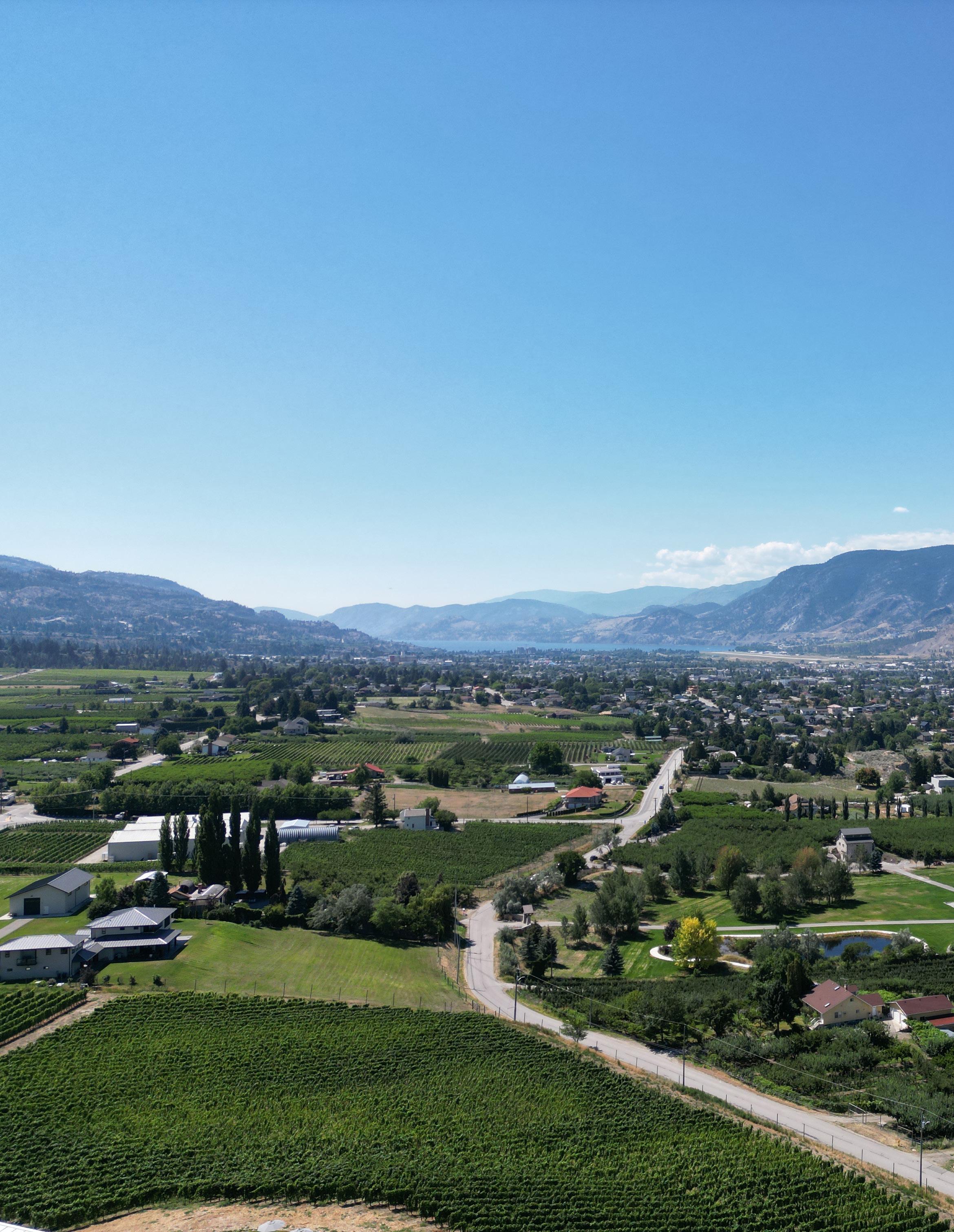
CHAPTER 2. BACKGROUND AND CONTEXT
2.1 URBAN FOREST BENEFITS
Trees are living things rooted in place. Often perceived as stable features of the environment background to family photos, scenery for walks and hikes, shade for backyard barbecues, and colour for downtown streets trees play a much more active role, breathing the same air we do and extending the tips of their branches and roots further into space to capture rainwater, locate soil nutrients, and produce the next generation of the urban forest. Trees encourage environmental complexity, supporting a wide array of life forms, from plants and fungi to animals and bacteria.
Over time, trees change the environment in which they grow: they shade streams so fish can live in them; they capture rainwater and keep soil from washing away; they filter air pollution from cars and factories; they store carbon from the atmosphere safely in wood and soils; and their fruits and seeds feed families and whole ecosystems. These functions, known as ecosystem services, deliver significant benefits to humans and the natural world.
Figure 2 illustrates some of the ecosystem services provided by the urban forest, with numerical estimates for some services derived from software called i-Tree Canopy2. This analysis includes a monetary evaluation of certain services. For example, the urban forest is estimated to provide a benefit of over $1.8 million in annual benefits from carbon sequestration, stormwater management, and air pollution filtration. The carbon stored by trees in Penticton is valued at over $16.5 million, and annually, the urban forest sequesters an amount of carbon dioxide equivalent to the emissions from 1,530 gas-engine passenger cars.
5 City of Penticton | Urban Forest Management Plan (DRAFT - JUNE 2024) Connections to nature Shade + cooling Social strengthening + recreation Rainfall interception Building energy savings + avoided greenhouse gas emissions Beautification + sense of place Evapotranspiration Water storage 100 million litres of stormwater runo avoided each year 742 hectares of tree canopy for wildlife habitat 59 tonnes of air pollution ltered each year 7,000 tonnes of carbon dioxide (GHG emissions) sequestered each year
Figure 2. Examples of ecosystem services provided by Penticton’s urban forest.
THREE KEY URBAN FOREST BENEFITS
Cooling the City
Penticton’s urban forest is like a natural air conditioner for the City. Climate change is making Penticton’s summers even hotter. Urban areas can experience even more extreme summer temperatures because of the urban heat island effect, when paved areas absorb and trap heat and become hotter than the surrounding countryside. The urban forest cools in two ways: firstly, trees directly shade pavement, which reduces heat absorption by concrete and asphalt3. Secondly, trees cool the air through evapotranspiration, the process by which they release water vapour into the air 4. The combined effect of the urban forest’s cooling potential in cities can be several degrees Celsius. i n Penticton, the surface temperature difference between paved commercial or industrial areas with few trees and forested rural land can be well over 10 degrees Celsius on a summer’s day (Figure 3).
Providing homes and pathways for biodiversity
The urban forest connects natural features and ecosystems surrounding the City. Historically, valley bottom development in the Okanagan has severed links between habitats by creating barriers in the landscape to the flow of animals, plants, and other forms of life. These barriers can be busy roads and highways, channelized rivers, parking lots, cement and brick buildings, or fenced in yards and orchards. But trees in natural areas, as well as urban trees, can help reconnect habitats for some species. By bridging the gaps between suitable habitats, the urban forest helps preserve Penticton’s native biodiversity. Biodiversity itself underpins many more ecosystem services than the urban forest alone, giving its conservation a particular importance.
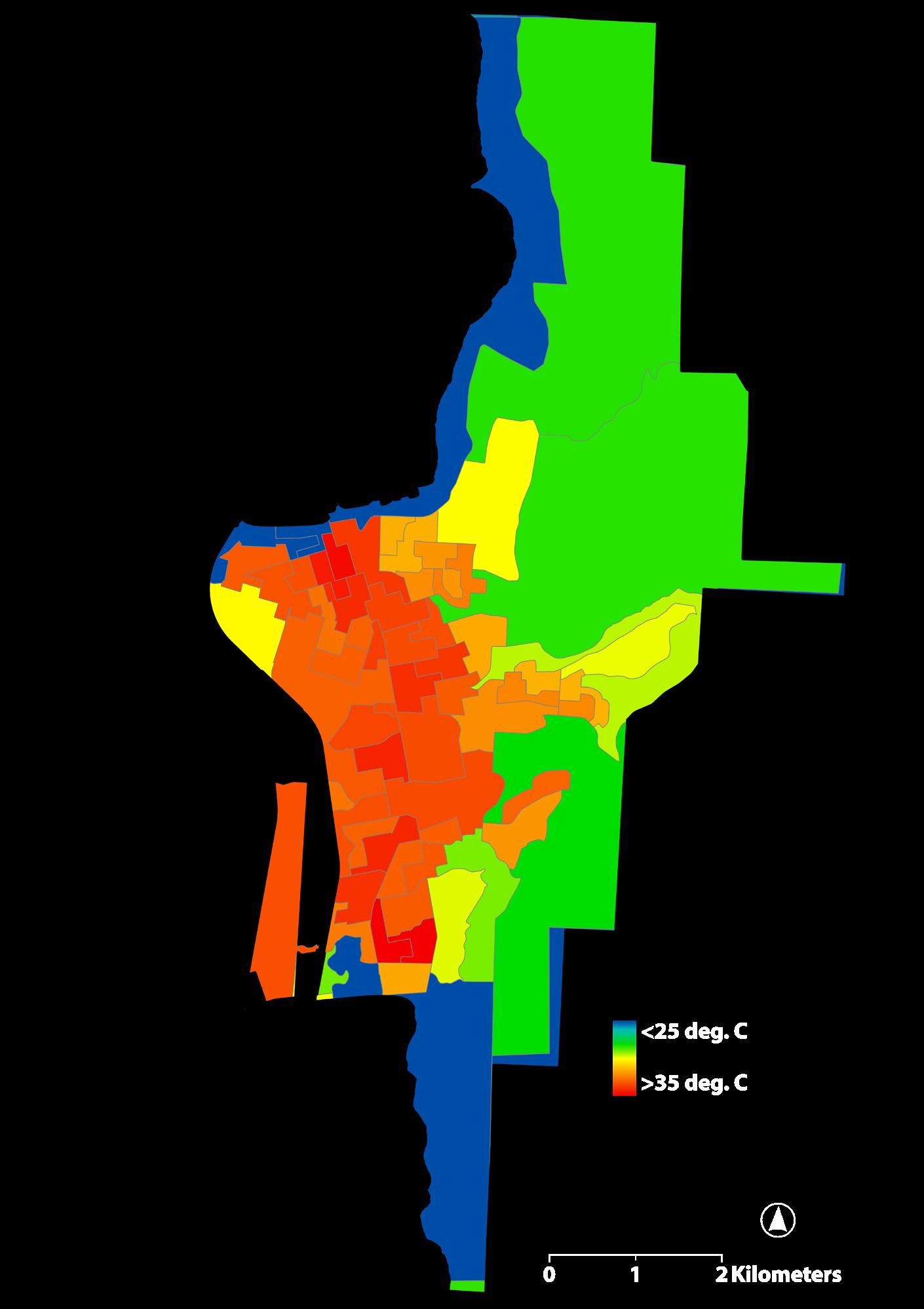
Land Surface Temperature by Census Dissemination Block
Detected June 16 2021 (7pm)
3. Land surface temperatures detected on June 16, 2021.
Healthier people, healthier city
Many studies have shown the benefits of the urban forest for public health. Benefits like urban cooling relate directly to reduced human mortality during heat waves, as British Columbia discovered in June 20215. Tree canopies promote physical fitness by providing comfortable places for walking, cycling, and exercise6. On the side of mental health, neighbourhood greenery has been found to decrease social isolation among seniors by encouraging outdoor activities7, and frequent “doses” of nature can reduce anxiety8. People recovering in hospitals with a simple view of trees have been found to heal faster than patients without these views9.
6 City of Penticton | Urban Forest Management Plan
Figure
2.2 WHY MANAGE THE URBAN FOREST?
The ability of the urban forest to provide ecosystem services is directly related to its extent and condition. The more urban forest there is and the better its health, the greater the ecosystem services it provides. However, there are many competing demands on space in cities as well as rural areas, including the need to build homes, workplaces, schools, and amenities. Trees in cities can also create risks, such as the potential for a tree falling and hurting someone, or for vegetation to act as a fuel in a wildfire. Urban
forest management requires money and resources. Staff responsible for urban forestry seek to manage the urban forest in such a way that the costs of management over a tree’s lifecycle are outweighed by the benefits it produces for society. This is consistent with a perspective on urban forestry informed by asset management, the practice of planning and implementing the care of service-producing infrastructure based on estimated costs and benefits to generate the highest return.







4. Conceptual representation of the magnitude of tree benefits and costs at stages of tree life cycle.
7 City of Penticton | Urban Forest Management Plan (DRAFT - JUNE 2024)
Maximize time at maturity for best return on investment Magnitude of Bene ts Magnitude of Costs Mature Stressed Declining Dead Newly Planted Young SemiMature Urban Tree Life Stages Cost exceeds bene t
Figure
To do this, urban foresters apply best practices that support overall urban forest health, stability, and longevity:
1. Plant the largest tree suitable for the site. Largestature trees provide many times more benefits than small-stature trees.
2. Retain healthy trees whenever possible. Healthy mature trees deliver the most benefits for the least cost.
3. Support diversity. Diversity reduces the risk of largescale tree canopy loss from impacts like pests, disease, and drought.
4. Plant the right tree in the right place. Planting the right species in the right location will maximize
potential benefits and help avoid conflicts with infrastructure or other issues that increase the lifetime cost of urban forest management.
Chapters 5-7 of the Urban Forest Management Plan return to these concepts to develop principles for management to support the Vision and Action Plan.
This view of urban forestry as supporting asset management is a useful one for the City, but it is just one way of looking at the urban forest in all its complexity. As living things, trees have intrinsic value. The perspective of SnPink’tn people is that all trees are of tmix w, part of the community of living things to which humans also belong.
2.3 FOREST FUNDAMENTALS: GEOGRAPHY AND CLIMATE
i f Penticton’s urban forest is rooted in place, what is the nature of that place? Understanding key features of the environment is essential for urban forest management. Penticton’s municipal boundary includes diverse landscapes and landforms, existing in a semi-arid climate unique in Canada.
2.3.1 GEOGRAPHY AND SO i LS
Penticton and the urban forest sit in the Okanagan Valley between Okanagan and Skaha Lakes. Glacial ice and the flow of meltwater carved most of the landforms in Penticton.
An ancestral lake much higher than today’s Okanagan and Skaha Lakes formed deposits of sediment that were later cut down by the Okanagan River and its tributaries, leaving the slopes and terraces that form the sides of today’s valley10. Widespread sandy and silt soils are the legacy of meltwater, which has carried away much of the finer clays. The remaining soils are droughty and fast-draining, although with irrigation they can furnish productive orchards and vineyards. i n some places, glacial ice scraped away most of the soil leaving outcrops of bedrock like Skaha bluffs, or left piles of mineral debris called moraines that make many of the valley sides. Trees would have re-entered the landscape from glacial refuges, mainly from the south. At first, coldhardy species of pine and spruce were likely the most common trees11
2.3.2 RECENT CL i MATE
Climate has varied since the retreat of the glaciers, influencing the forest species now common here. Penticton’s climate in the past few thousand years has been “semi-arid”, meaning annual precipitation is somewhat less than the potential loss of water from evapotranspiration. This limits the amount of water naturally available for vegetation, which favours drought-adapted plants and ecosystems. Between 1980 and 2010, the City averaged just 346 mm of precipitation annually12; about one-quarter of the average total in Vancouver. Precipitation is usually less than 30 mm each month except in May and June, when it averages 40-45 mm. While temperatures in winter are generally mild, winter cold fronts can force temperatures as low as -20°C for short periods of time. Summer temperatures are some of the hottest in Canada, with average daily highs of 25°C or more in June, July, and August. The hottest temperature ever recorded in Penticton was 46.0°C during the June 2021 heatwave. Plant hardiness zones are sometimes used as a shorthand for the climate influences faced by vegetation in an area. Since the 1961-1990 reference period used by Natural Resources Canada, Penticton’s plant hardiness zone has shifted from 6a to 7a (and is likely still shifting). This reflects the trend towards warmer winter temperatures with fewer frost days.
8 City of Penticton | Urban Forest Management Plan (DRAFT - JUNE 2024)
2.3.3 EFFECTS ON ECOSYSTEMS
Penticton’s relatively warm, dry climate acts as a control on the forest landscape. For thousands of years the warm valley has hosted fire-dependent forests of ponderosa pine and juniper, bunchgrass meadows, meandering creeks shaded by stately cottonwoods, and slopes leading up through forests of pine, Douglas-fir, larch, aspen, birch, and spruce. The City falls within two biogeoclimatic ecosystem classification zones (BEC zones) – a system used by the Provincial government to characterize the natural potential vegetation of any site in BC.
The Bunchgrass Zone characterizes the driest climates at low elevations in the rainshadow of the Coast and Cascade Mountains. Here, soil moisture during the growing season is insufficient to widely support forests. Arid-adapted herbaceous and shrub species dominate most ecological communities situated away from sources of water like creeks and ravines. Forest cover is limited to riparian areas and springs. Wildfires occur frequently in the landscape.
The Ponderosa Pine Zone is the driest and warmest forest ecosystem in British Columbia, generally found above the Bunchgrass Zone in the South Okanagan and filling the bottom of smaller side valleys. The Ponderosa Pine Zone represents the northernmost extension of a semi-arid forest ecosystem found widely in the western United States. Ponderosa pine co-evolved with wildfire, and trees have adaptations like thick corky bark that help mature pines survive frequent low-intensity fires that burn through the flammable underbrush created by grasses and the long, thin needles of the pine trees. The understorey beneath the pines shares many species with the neighbouring Bunchgrass Zone, helping create forests that looked like parkland to early European settlers.
i n fact, many of these forests and neighbouring grasslands were maintained ecosystems, with fires intentionally lit and managed by Okanagan people in addition to occasional fires ignited by lightning. The nsyilxcәn word for these cultural fires is cikilax wm. Cikilax wm serves many purposes related to habitat management, resource provision, and landscape health as part of a spiritual connection to tmix w. The Okanagan Nation Alliance is reasserting the role of i ndigenous people in fire management throughout the region, with recent projects to reintroduce low-severity fire as a vital element in ecosystembased management.
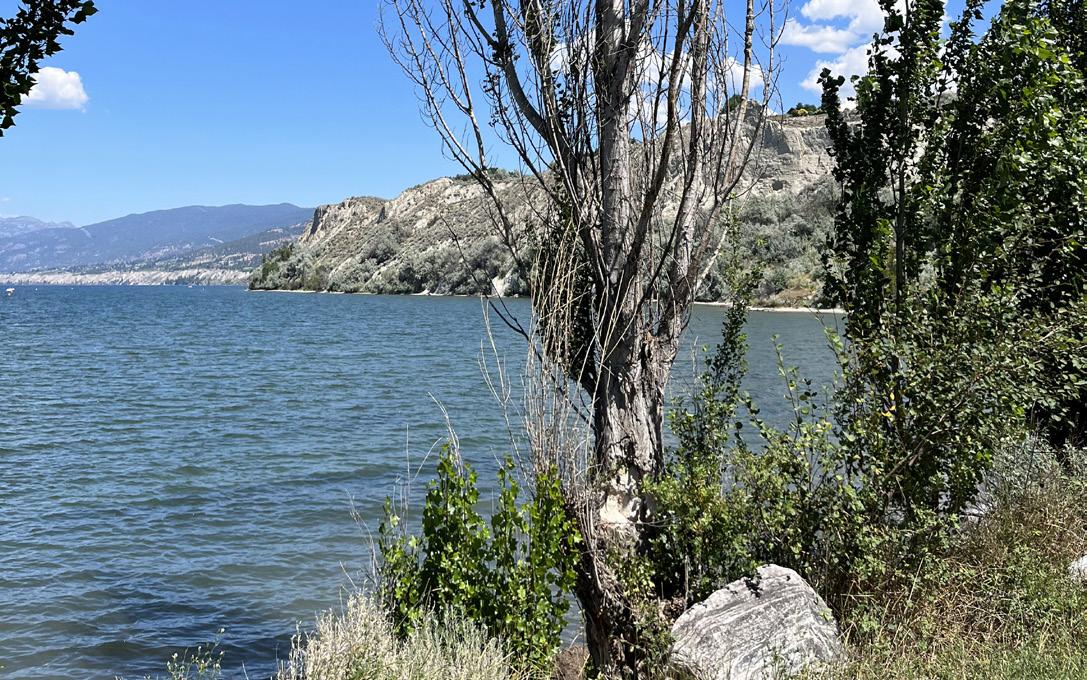


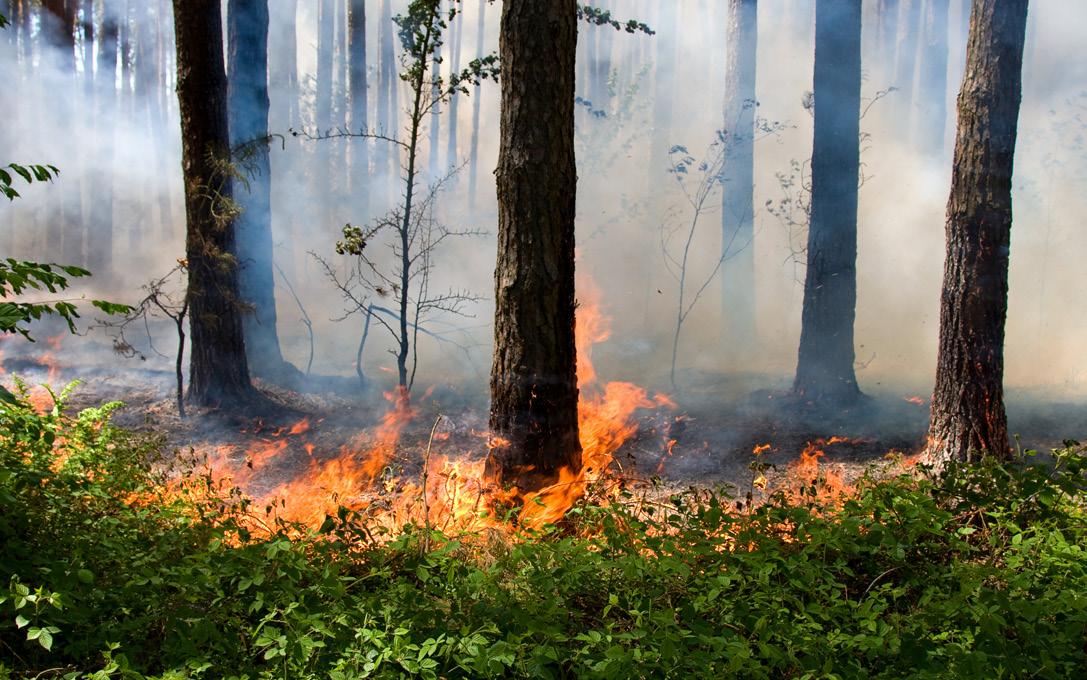
9 City of Penticton | Urban Forest Management Plan (DRAFT - JUNE 2024)
Although fire is historically the most important natural disturbance in Penticton’s urban forest, it is not the only climate-related event that regularly affects trees here. Firstly, it is important to distinguish between low-severity (e.g., cikilax wm) fires and the much larger, more damaging wildfires that burn the crowns of mature trees and can destroy forests over large areas. These high severity fires were present in the pre-settler landscape but there is evidence they are becoming more common because of climate warming, fire suppression leading to a build-up of forest fuels, and a variety of insect and forest disease outbreaks.
2.3.4 CL i MATE CHANGE
Climate change is shifting the conditions for the urban forest, with consequences for natural forest landscapes as well as trees in urban areas. Penticton’s climate is projected to become hotter year-round, with much longer summers and a shift in seasons13. Valley bottoms can expect almost triple the number of days with temperatures of at least 30°C as in the past12. Summer heat will become more extreme, with potentially significant impacts on human and ecosystem health12. Cold winter temperatures which historically limited the spread of some invasive species will rise, making the urban forest more vulnerable to new pests and diseases12. Climate shifts also drive changes in the relationships between organisms within native ecosystems, supporting previously unproblematic insects and forest damage agents to become significant agents of damage and ecological transition14
Other climate-driven disturbance events include freezethaw cycles that crack tree stems and damage roots and shoots, windstorms that funnel through the valley between the lakes uprooting trees and shearing treetops, and heavy rainfalls that erode sandy slopes and cause flooding in ravines and riparian areas. Events that at first seem to be driven by weather alone are often part of more complex relationships between these abiotic disturbances and biotic disturbance factors like forest disease and human-caused environmental change.
Although growing seasons will lengthen, temperature increases in spring and fall are expected to outpace any increase in precipitation12. Rainfall in summer is expected to become rarer. Overall, evapotranspiration will likely increase aridity in the landscape, with drought conditions occurring earlier in spring and lasting later in fall15. Conditions supportive of wildfire will become more common, extending the fire season through more of the year16. Projected changes will push past the tolerance of many trees and forests currently here, meaning urban forest management needs to adapt to these shifting baseline conditions as well as plan for disturbances that may accelerate ecological change. i f sustained, the urban forest is a valuable adaptation tool for the City, helping to reduce the impacts of extreme heat, flooding, and other climate-driven events.
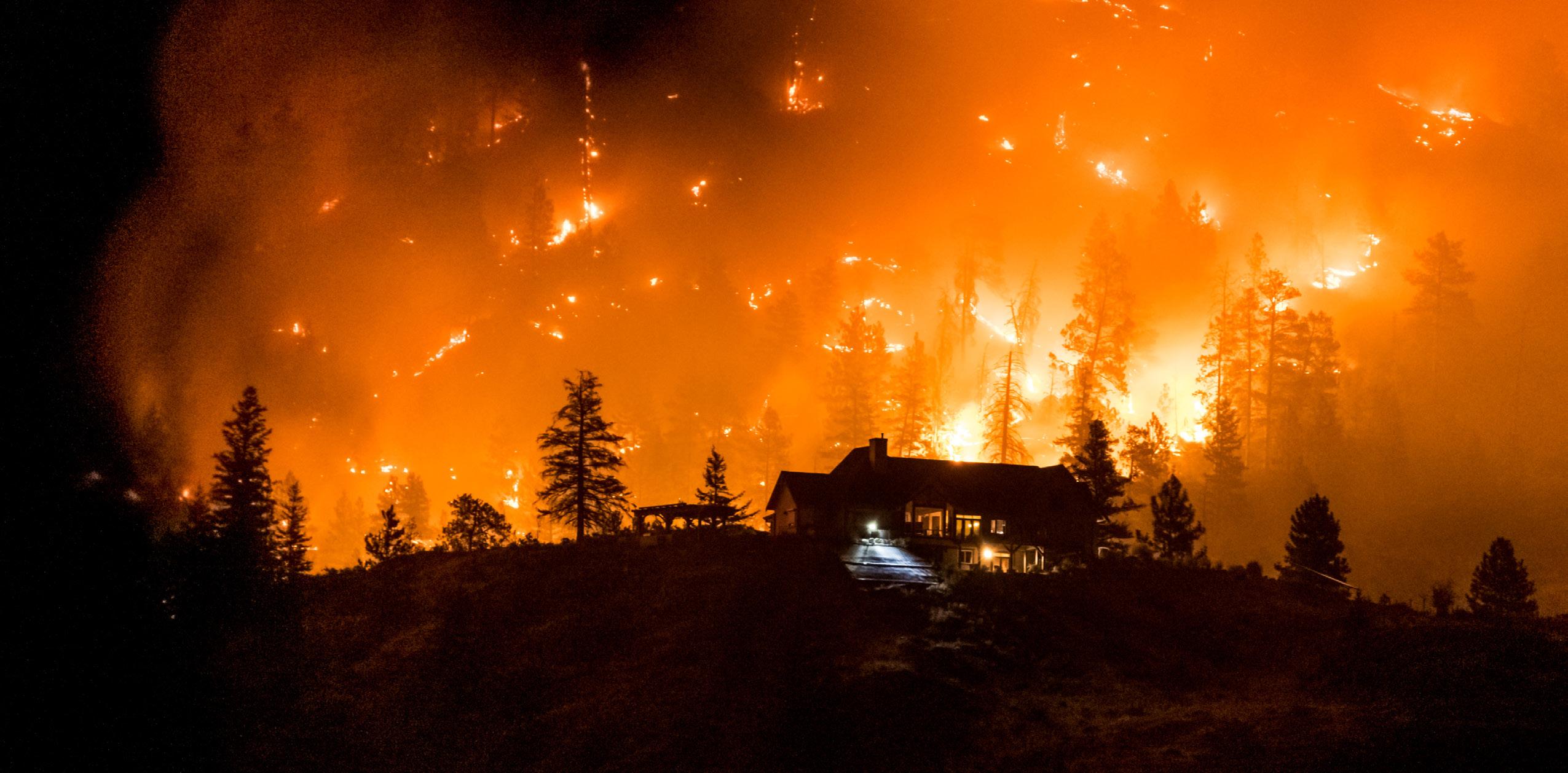
10 City of Penticton | Urban Forest Management Plan (DRAFT - JUNE 2024)
Photo: Douglas Drouin.
BY THE 2050s, PROJECTED CHANGES* TO:
TEMPERATURES
Warmer temperatures year round, with three times as many days over 30 ˚C.
EVAPOTRANSPIRATION
Increased rates of evaporation and transpiration from waterbodies, soil and plants.
PRECIPITATION
More rain throughout year, except in summer. Longer summer dry spells.
GROWING SEASONS
Longer and warmer growing season, lasting over 200 days per year.
VARIABILITY
More frequent and unseasonal extreme weather
*Projected changes are adapted from the source document: Climate Projections for the Okanagan Region (February 2020)12
WILL LIKELY CAUSE
SPECIES DISTRIBUTION SHIFTS
Forest species may shift northward and upslope as heat and moisture conditions exceed their tolerance.
LESS MOISTURE AVAILABILITY
Evapotranspiration rates will increase relative to precipitation, resulting in drier soils and vegetation.
LONGER FIRE SEASONS AND LARGER FIRES
Fires may occur more often and burn larger areas. Fire risk is expected to increase based on warmer, drier summers.
MORE PESTS AND INVASIVE SPECIES
Pests may reproduce more rapidly and more often. Trees and ecosystems may be more vulnerable to attack and invasion.
LONGER, WARMER GROWING SEASONS
Longer growing seasons may support more growth, species diversity and potentially more carbon sequestration.
MORE EXTREME WEATHER EVENTS
Heat, extreme precipitation, freezing rain, heavy wet snow, flooding, landslides, windstorms and other events may happen more often leading to more tree damage.
11 City of Penticton | Urban Forest Management Plan (DRAFT - JUNE 2024)
CO 2
Figure 5. Projected climate drivers and likely impacts to Penticton’s urban forest by the 2050s.
2.4 A BRIEF HISTORY OF THE URBAN FOREST
Understanding climate and geography is only half of the story of Penticton’s urban forest. While climate and geography explain much of forest’s composition in natural areas, recent human influence and landscape changes caused by urbanization are what make the urban forest
distinct. i n this regard, the history of the urban forest is intertwined with the history of colonialism in the Okanagan.
HOW PENTICTON GOT ITS NAME
Syilx (Okanagan) people have lived in these lands for thousands of years. The place between the lakes where Penticton is now is called SnPink’tn in nsyilxcәn, the i nterior Salish language spoken by Syilx people. SnPink’tn means “the place where people live year-round”. The location was favourable because of its abundant freshwater, as
the mixed forests reaching up to the subalpine. i n addition to managing landscape health using cikilax wm (cultural fire), Syilx people maintain relationships with many forest plants, including cottonwood, which is used to carve dugout canoes, build cradles and treat ailments, and ponderosa pine, whose pitch was used to waterproof moccasins and other


12 City of Penticton | Urban Forest Management Plan (DRAFT - JUNE 2024)
Photo: Penticton Museum and Archives (PMA0154: “Oxbows 1909”). Artwork by Gerlissa Chan.
2.4.1 NATURAL
FORESTS
The term “natural forests” as used in the Urban Forest Management Plan refers to any tree-dominated ecosystem that has a significant population of indigenous trees and plants, whether largely unmaintained or deliberately managed to promote a natural structure or other natural characteristics. This definition is flexible to reflect the many contexts where natural forests can be found and their continuing value despite modification by invasive tree species and other management issues.
Natural forests in Penticton are the legacy of the City’s climate and geography as well as land-based practices of the Syilx people and ancestors over millennia, yet they
Species spotlight: Ponderosa Pine
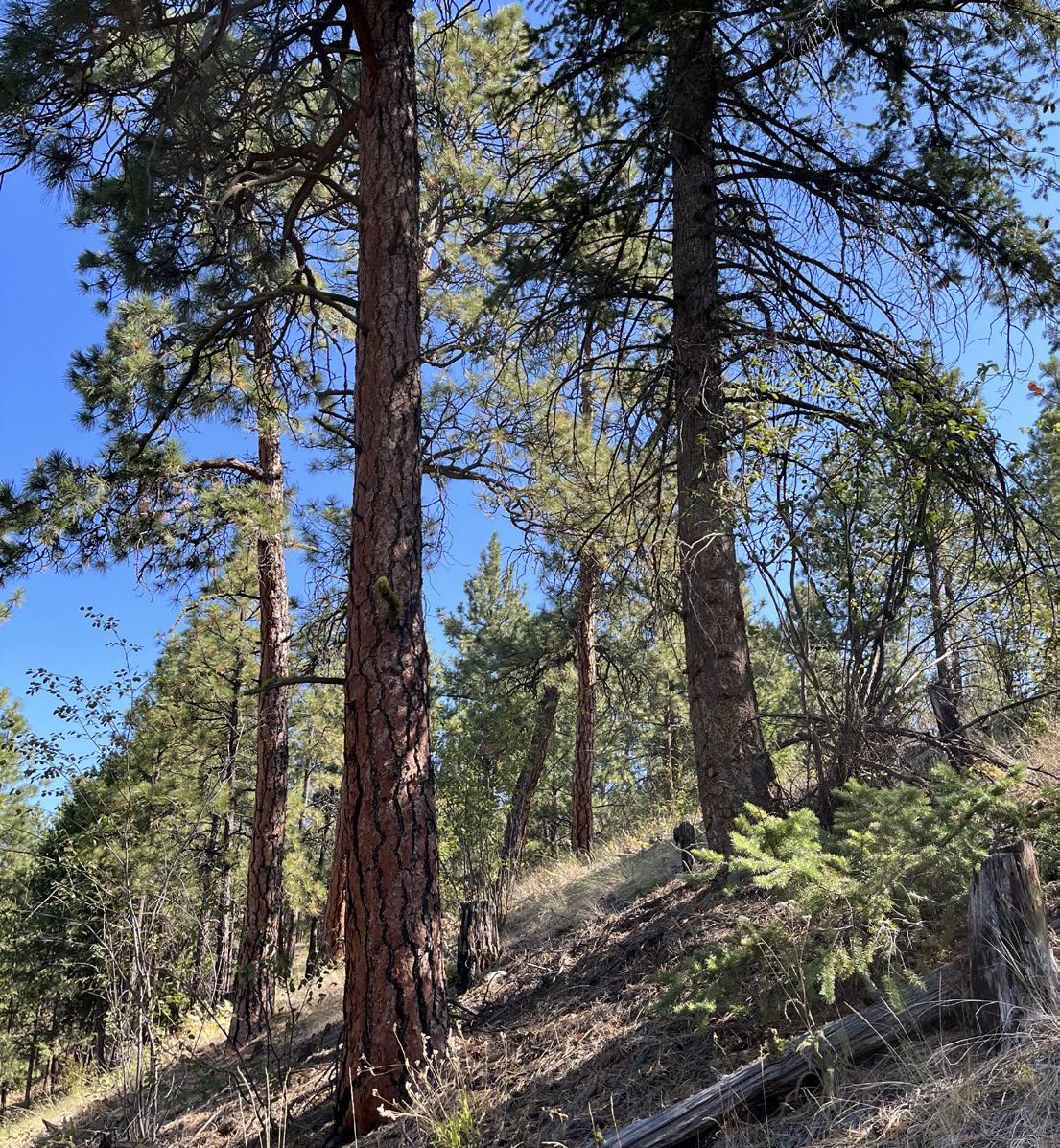
Ponderosa pine (Pinus ponderosa) is the most common native tree species in Penticton, found in almost every natural area and many urban yards. This large coniferous tree develops a bullet-shaped crown of long slender needles in groups of three, supported by a trunk and branches with “puzzle-piece” bark in hues from rose pink to bright orange. i ts cones are large and heavy, littering the ground on beds of old needles. The reason for Ponderosa’s success? i t is the native tree most tolerant of drought, and makes the best use of our landscape’s limited water. i ts shedding habit helps create the fuel for the frequent wildfires with which it co-evolved.
have been further imprinted by forest harvesting, wildfire suppression, and urbanization. Major alterations, such as the transformation of the Okanagan River into Penticton Channel, alongside other earthworks around Penticton Creek and Ellis Creek, the diversion and containment of many smaller creeks and draws, and the removal of forest to accommodate urban development and agriculture, have all been significant changes impacting natural forests in the City. Smaller scale changes are common throughout natural forests, where illegal dumping, the spread of invasive species, soil compaction, fire exclusion, and recreational development alter natural ecosystems in sometimes subtle ways.
Species spotlight: Black Cottonwood

Black cottonwood (Populus balsamifera ssp. trichocarpa) is the most common native tree found in riparian areas. This fast-growing deciduous tree appears wherever groundwater is ample, colonizing gravel river bars, streambanks, and old farmland with its thousands of white, fluffy seeds –Penticton’s June snowfall. Some of the largest trees in the City are the black cottonwoods in Lakawanna Park. Look for single-pointed oval or arrow-shaped leaves with luscious green tops and silvery undersides, as well as deep furrowed grey bark on older trees. i n spring, large, sticky and highly aromatic buds open to release new leaves and strings of small flowers called catkins.
13 City of Penticton | Urban Forest Management Plan (DRAFT - JUNE 2024)
2.4.2 AGR i CULTURAL TREES
European settlement altered where indigenous trees grow in the City and introduced non-native tree species. The first settled industry in the area was cattle ranching, which re-purposed the area’s grasslands, open pine forests, and freshwater while harvesting native trees for fence posts, building materials, and firewood. i t is possible that nonnative tree planting started during this era with seeded garden trees like apples, cherries, and hawthorns. By the end of the 1890s, investors started to see the potential of the region’s climate and soils for orcharding. i mprovement of lake transportation and the coming of the Kettle Valley Railway in the 1910s opened the doors to the development of the fruit crop industry, which steadily encroached into woodlands and grasslands of the lower valley. Today, a portion of Penticton’s urban forest still consists of cultivated fruit trees in orderly rows. Species like weeping willow and Lombardy poplar were introduced to act as windrows and yard shade.
2.4.3 URBAN TREES
Urban growth followed incorporation, as Penticton became the commercial and service centre for the South Okanagan. Urbanization brought changes like the construction of roads and highways, homes on smaller urban lots, and new civic buildings. European ideas of beautification introduced willows, London planes, oaks, elms, and honey locusts to parks, yards, and gardens. Lakeshore Drive, Gyro Park and Lakawanna Park, with their grand trees, were established in the first half of the 20th century as Penticton developed its reputation for tourism.
By the City’s re-incorporation in 1948, urban development had begun encroaching on natural forests. Many native trees were already incorporated into urban parks and yards. i n the late 1940s, City Council passed a motion to preserve “Pine Tree Park” (Skaha Lake Park), eventually transforming the ponderosa pine forest into a formal civic park where the trees are set amid manicured lawns.
As Penticton’s population grew, the landscape became more urbanized. The process of urbanization can be thought of as “hardening” the landscape by replacing soils and open water with paved roads, driveways, foundations, and constructed drainage. i mpermeable or impervious surfaces make daily life in the City easier, but at the cost of fragmenting the urban forest into smaller and smaller islands. Fragmented ecosystems in urban areas are more vulnerable to invasive species establishment and the loss of biodiversity.
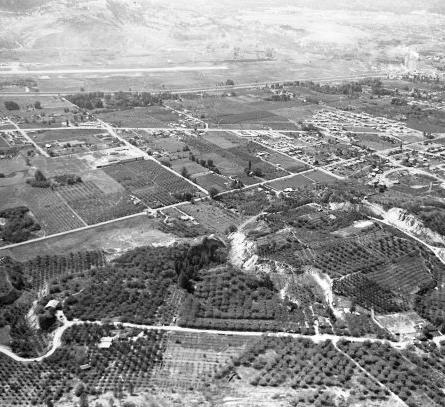

London Plane (Platanus x. acerifolia) is an introduced species in Penticton that has been planted for 100 years in parks and yards. The oldest trees in the City are now towering specimens with broad green- to sandy-coloured trunks that support globe-shaped crowns with dappled shade. The leaves of London Plane look like maple leaves, with several pointed lobes spreading from a light green palm. London Plane is an urban forest original, a genetic cross that emerged in European gardens and was then widely planted in cities because of its tolerance for light, heat, and pollution.
14 City of Penticton | Urban Forest Management Plan (DRAFT - JUNE 2024)
Species Spotlight: London Plane
Photo: Penticton Museum and Archives (“1968 South Main Skaha Lake Rd”).
Urbanization and development can also lead to new treed landscapes. Re-investment in downtown and commercial areas is adding trees to City streets, parks, and parking lots.
Trees in urbanized areas face significant challenges such as hotter temperatures due to the urban heat island effect, rapid changes in soil moisture (including inundation and effective drought) because of engineered drainage and poor soil quality, impacts from vehicles and machinery, vandalism, and conflicts with utilities. i n Penticton, a busy summer events calendar and ever more popular parks are teaching visitors, residents, and City staff alike about impacts like soil compaction faced by some of the most treasured urban trees.
Hardscapes and the urban forest
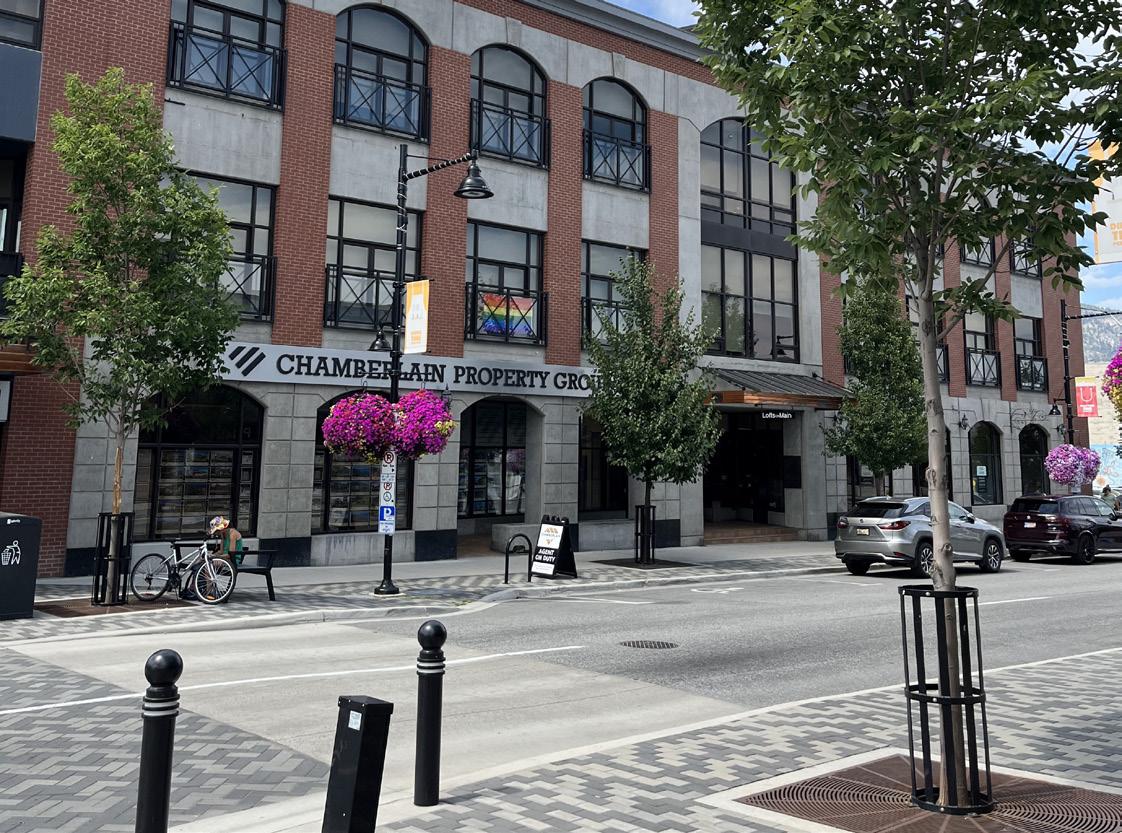
Hardscapes are areas where impermeable surfaces have substantially changed the growing environment available to trees and forests by fragmenting soil volumes into smaller areas and redirecting precipitation runoff through constructed drainage. Think of a hardscape as a 3-dimensional environment – concrete buildings or blank walls, asphalt roadways, and the compacted mineral base underneath most modern construction all segment the potential growing environment for trees. New construction and design standards can make the urban environment more hospitable for trees, helping to stitch the urban forest back together.

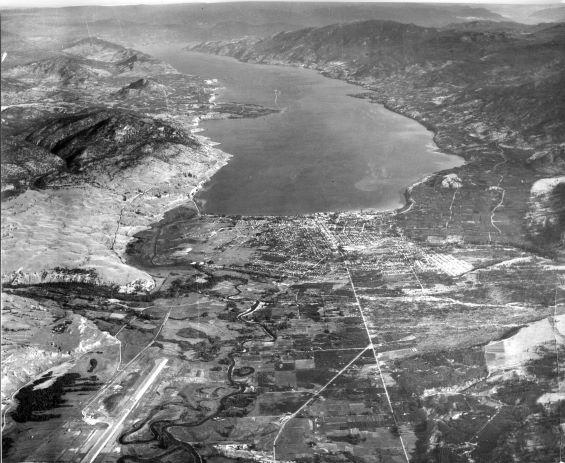
15 City of Penticton | Urban Forest Management Plan (DRAFT - JUNE 2024)
Photo: Penticton Museum and Archives (PMA1564: “Lakeshore Drive ca. 1910-1920”).
Photo: Penticton Museum and Archives (“1950 AP #8 Looking North”).
UPDATES IN HOUSING POLICY: PROVINCIAL LEGISLATION AND LOCAL PROGRESS
i n late 2023, the provincial government introduced legislation to promote the construction of housing throughout the province. Bill 44: Housing Statutes (Residential Development) Amendment Act made it illegal for municipalities of 5,000 people or more to use zoning bylaws to limit the development of missing middle housing forms, including granny flats, townhomes, duplexes, and small apartments. Bill 46: Housing Statutes (Development Financing) Amendment Act aims to increase transparency around development costs and procedures while expediting Official Community Plan-conforming projects. Bill 47: Housing Statutes (Transit-Oriented Areas) Amendment Act increases the minimum allowable density within 400 metres from all Transit-Oriented Areas designated by regulation.
Council has previously directed the provision of attainable, accessible housing as a priority for the City. The Task Force on Housing reviewed housing policies in Penticton’s Official Community Plan and made 18 recommendations in December 2023 to meet the demand for housing. The project team for the Urban Forest Management Plan presented to the Task Force on Housing about potential interactions between the urban forest and housing policy. Penticton’s Official Community Plan and Zoning Bylaw are currently being updated to respond to the recommendations of the Task Force on Housing and new provincial rules. The direction is toward land use intensification in existing urbanized areas.
Shifting from extensive sprawl to intensive infill development can present challenges for tree retention but also benefits the urban forest. Land use intensification conserves much greater areas of natural forest on the outskirts of the city, while redevelopment in urban areas provides the opportunity to amend development standards to promote tree planting and reclaim paved landscapes. The Urban Forest Management Plan seeks to leverage growth, recognizing that planning and thoughtful design are solutions for sustaining Penticton’s trees amid a growing community.
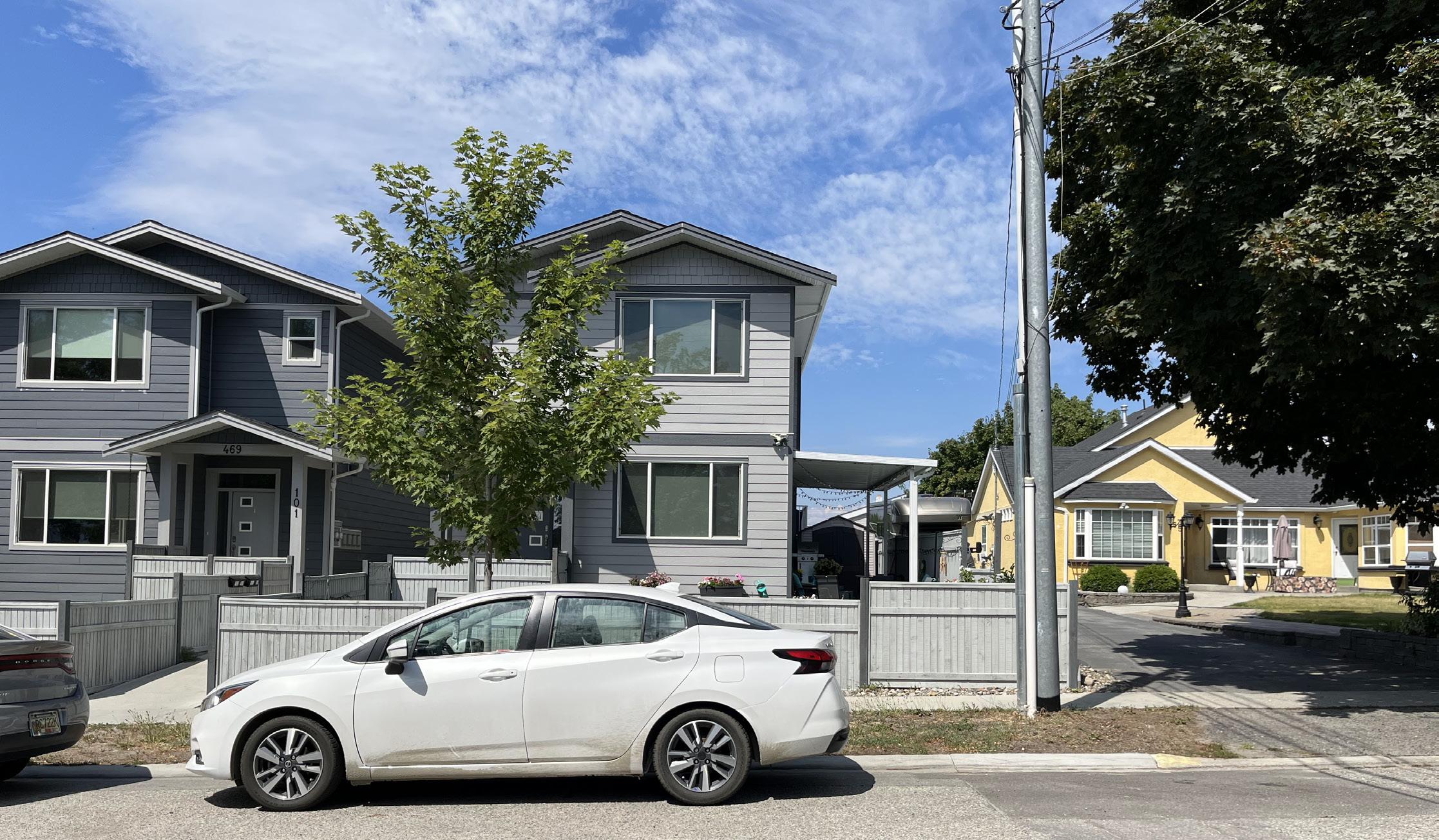
16 City of Penticton | Urban Forest Management Plan
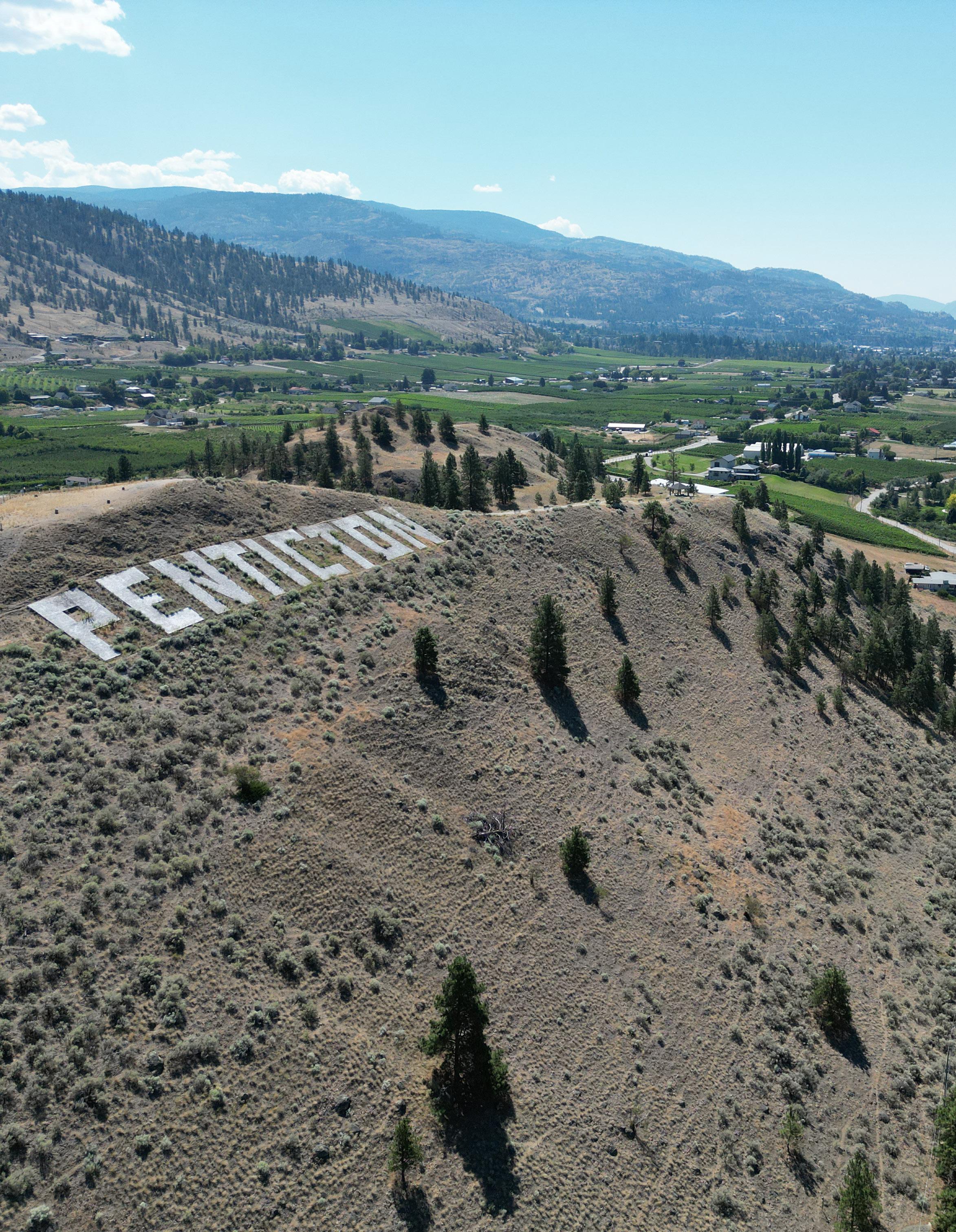
CHAPTER 3.
STATUS AND TRENDS
This chapter of the Urban Forest Management Plan shares what we know about our urban forest today. The facts and figures in this chapter are based on three primary sources: mapping of canopy cover based on a City-owned LiDAR dataset (2017) corrected using a City-owned (2020) orthophoto; the City’s partial inventory of about 8000 trees
3.1 URBAN FOREST EXTENT
To understand the extent of Penticton’s urban forest, the Urban Forest Management Plan describes its canopy cover. Canopy cover is a measure of the area obscured by trees when viewed from above. i t can be expressed as an absolute measurement or as a percentage in relation to a defined boundary. Canopy cover is a useful benchmark for the urban forest because it can be stated for any land use or ownership, be compared with results from other municipalities or regions, and has clear links to the ability of the urban forest to provide ecosystem services.
in urban areas; and field observations made by a professional Forester in July 2023. This chapter seeks to answer essential questions like how much urban forest exists in Penticton, what we know about the size and species of trees, where trees grow in the City, and who is responsible for urban forest management.


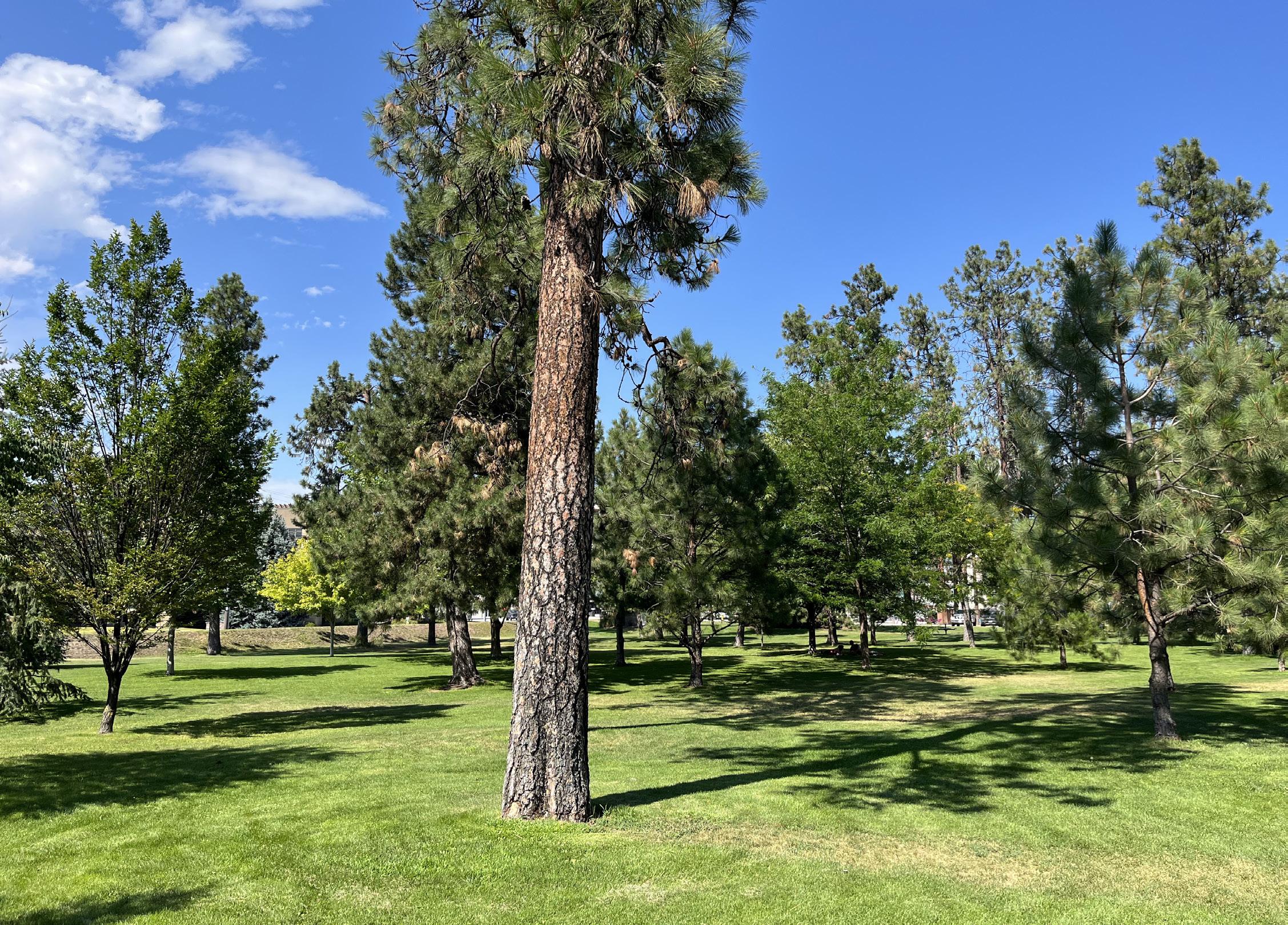
18 City of Penticton | Urban Forest Management Plan (DRAFT - JUNE 2024)
Figure 6. Canopy cover is the 2D area occupied by trees when viewed from above.
3.1.1 C i TY-W i DE CANOPY COVER
Penticton’s canopy cover is 17% within the City boundary. Trees cover 742 hectares within the City’s 4,300-hectare land boundary. There are approximately 243,000 trees in the City, an estimate based on the analysis of LiDAR data and orthophotography. This tree count is likely an underestimate because the canopy assessment distinguishes between high and low vegetation using a height cutoff of 2 meters. Forest trees under the main level of the tree canopy can also be missed if they are completely obscured by larger overstorey trees.
Canopy cover in Penticton is believed to be declining over time, driven by interrelated climate change and forest health issues, construction-related tree loss, tree removal on private property, and insufficient tree planting on public property. This assumption can be confirmed by future monitoring of the urban forest canopy.

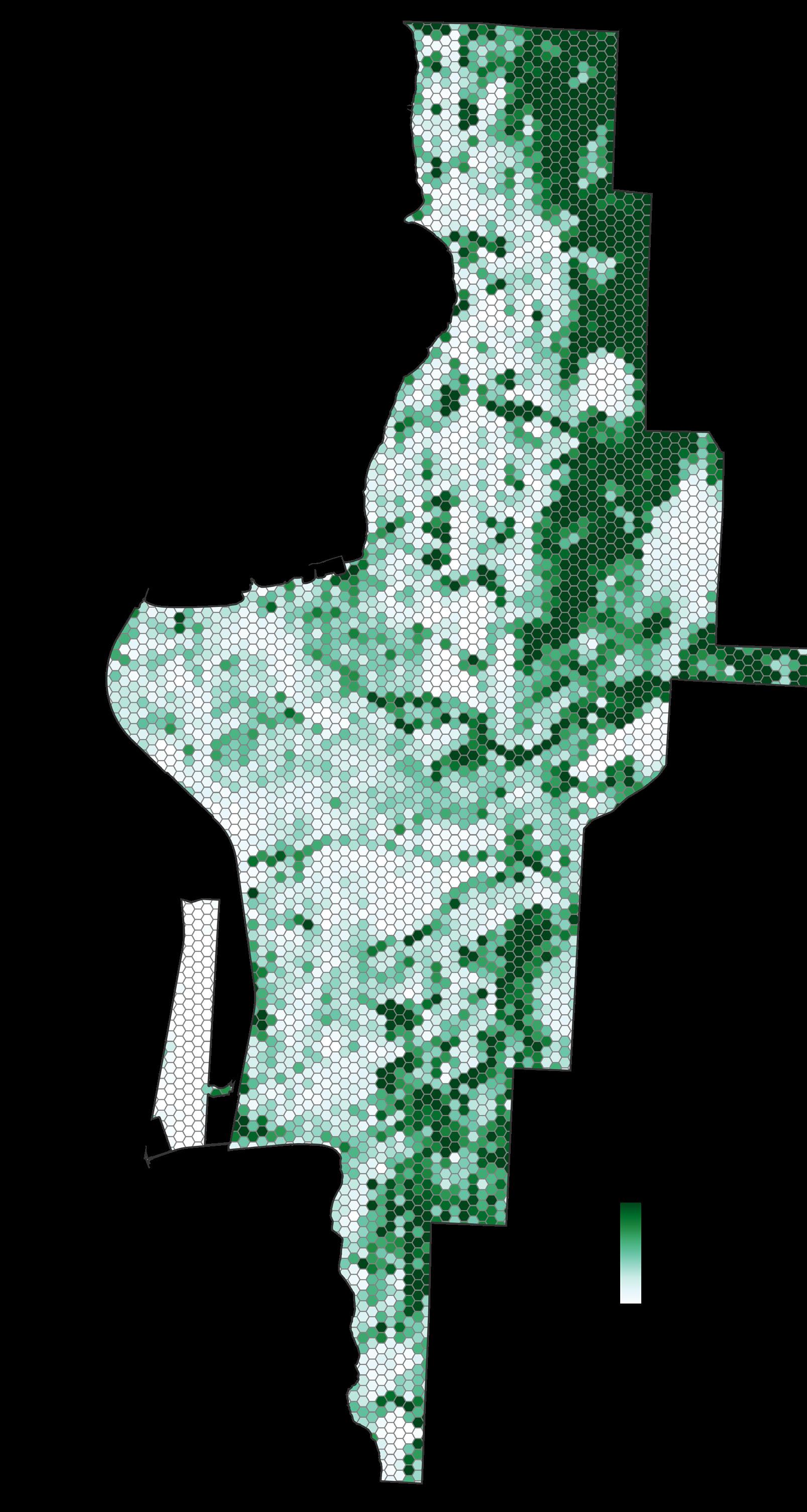
19 City of Penticton | Urban Forest Management Plan (DRAFT - JUNE 2024)
Figure 7. Tree canopy cover.
Canopy Cover
COMPARING CANOPY COVER
canopy cover
Canopy cover in urban areas
! Excludes ALR *Core Area Growth Strategy District
City-wide canopy cover is influenced by all the factors that affect trees in the City’s landscape, including climate, geography, land use, and forest health. Penticton’s 17% canopy cover is in the middle of cities that share similar context and land use patterns. Kelowna’s 2024 Urban Forest Strategy found 22% canopy cover city-wide, excluding the Agricultural Land Reserve, while Kamloops’ 2016 Urban Forest Management Strategy estimated 12% canopy cover city-wide. These southern i nterior cities occupy semi-arid valleys with a legacy of lower tree cover. For contrast, the District of Saanich (Vancouver island) is an example of a municipality in a primarily forested biome and has 43% canopy cover. Globally, cities in grassland biomes have been found to have 19% canopy cover on average, while forest biome cities have 31%31
Canopy cover in urban areas is often lower than city-wide. Of the comparison cities, only Kamloops had similar canopy cover in urban settings and city-wide. Notably, its canopy cover is the lowest (12%) of the comparisons. Penticton’s urban areas have 12% canopy cover, as in Kamloops. Kelowna’s Urban Forest Strategy does not report on canopy cover across all urban areas but uses designations called
Growth Strategy Districts to summarize its urban forest. The Core Area Growth Strategy District represents urban neighbourhoods with a mixture of housing densities, and has canopy cover of 15%. The Suburban Growth Strategy District (not shown in Figure 8) represents low density residential neighbourhoods and has canopy cover of 20%. This suggests canopy in Penticton’s urban areas could be increased. Saanich’s high urban canopy cover of 31% likely reflects the legacy of its forest ecosystems as well as a more favourable climate for tree growth.
20 City of Penticton | Urban Forest Management Plan
Kamloops
Saanich
Penticton
43% 22%! 12% 17% 12% 15%* 12% 31%
Kelowna
(2023)
(2016)
(2021)
(2020)
City-wide
Figure 8. Comparison of Penticton’s canopy cover with selected BC cities.
3.1.2 BU i LD i NG BLOCKS OF THE URBAN FOREST
Three types of trees form the building blocks of Penticton’s urban forest: natural forests, trees in rural/agricultural areas, and urban trees (see Section 2.3 for descriptions). Estimates of the contribution of each building block to the urban forest were made by separating the city-wide canopy map using Penticton’s existing natural areas and land use mapping, then refined following review in the field.
Urban trees are located in streets, yards, landscaped parks, and other urban developed property outside agricultural areas. They can include native species that have been preserved into new urban landscapes, such as the ponderosa pines at Skaha Lake Park. Urban trees generally lack an understory of native plants, continuity with natural forests, or both. Approximately 51,000 (21%) of trees in the urban forest are Urban Trees. Urban Trees provide 139 ha of canopy, or 19% of the total 742 ha of tree canopy in the City.
Natural forests are places where indigenous tree species and ecosystems form a dominant vegetation cover in areas that are either unmaintained landscapes or specifically managed to promote natural ecosystem characteristics. This includes pockets of forest in urban areas, such as along Ellis Creek, the oxbows, and steep slopes, as well as the broader forest landscape beyond Penticton’s urban and agricultural areas. Natural forests contain approximately 151,000 (62%) of Penticton’s trees and provide 518 ha (70%) of its canopy cover.
Agricultural/rural trees are located on agricultural and rural property. They include orchard trees as well as shade trees, windrows, and landscape trees whether they are self-seeded or planted by property owners. Agricultural/rural trees number approximately 40,000 (16%) of Penticton’s total tree population and provide 85 ha (11%) of the total 742 ha of tree canopy in the City.
Key trend: Each of Penticton’s urban forest building blocks faces challenges. Natural forests contribute more than two-thirds of the City’s urban forest canopy but are being impacted by climate change, invasive species establishment, fire exclusion and changes in the natural disturbance regime, and tree removal for greenfield development. Agricultural trees are slowly being lost from orchard conversion to viticulture. i n urban areas, development activity and the aging out of mature trees are the biggest threats. Combined, these issues could result in losses of several dozen hectares of canopy cover during the next 20 years.
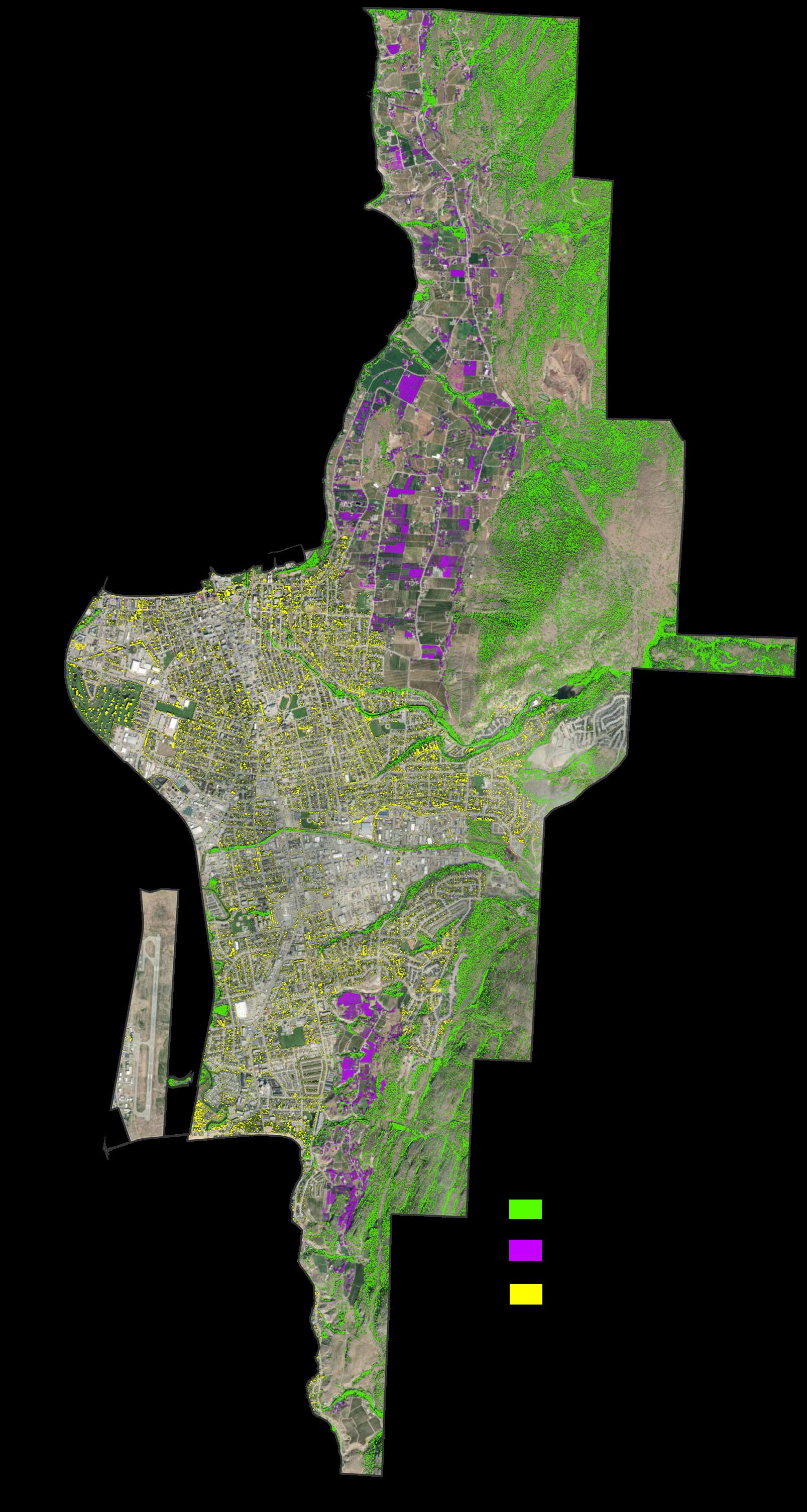
21 City of Penticton | Urban Forest Management Plan (DRAFT - JUNE 2024)
Figure 9. Canopy distribution of natural, urban and agricultural trees.
Natural forest trees
Agricultural trees
Urban trees
FOREST CORRIDORS
The Urban Forest Management Plan identifies Forest Corridors to support planning of natural restoration initiatives. Forest Corridors are linkages between natural forest canopy patches in the urban area, where they provide reserves of native biodiversity or potential pathways for the movement of native species between habitats on either side of the Okanagan valley. The urban area of the City of Penticton is a barrier to the natural movement of wildlife in the Okanagan valley, as it occurs at a critical point between Okanagan and Skaha Lakes where cross valley travel of wildlife would otherwise occur freely. This importance for wildlife movement is part of the reason SnPink’tn was “a place inhabited year-round” by Syilx people prior to colonization. Supporting natural forest cover around Penticton Creek, Ellis Creek, and other natural features that bridge the urban area can help reconnect habitats and preserve regional biodiversity. At the same time, supporting native biodiversity in remnant natural forests within the urban area provides ecosystem services, including cultural services of importance to i ndigenous peoples, that urban residents may not otherwise be able to easily access. Penticton’s Forest Corridors are a significant component of building tree equity and access to the therapeutic benefits of nature in the City.
Forest Corridors (existing)

Urban Connections (future)
Natural forest trees
Agricultural trees
Urban trees
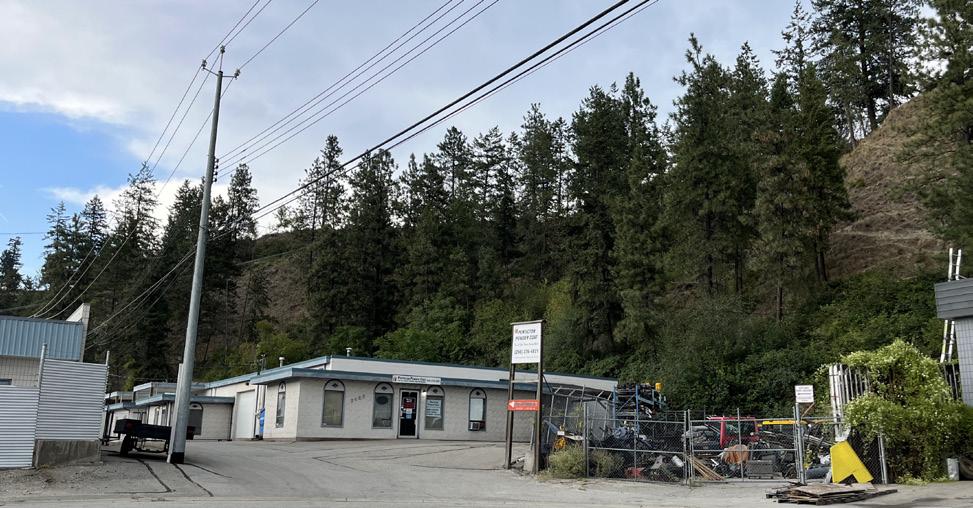
3 4 5
1


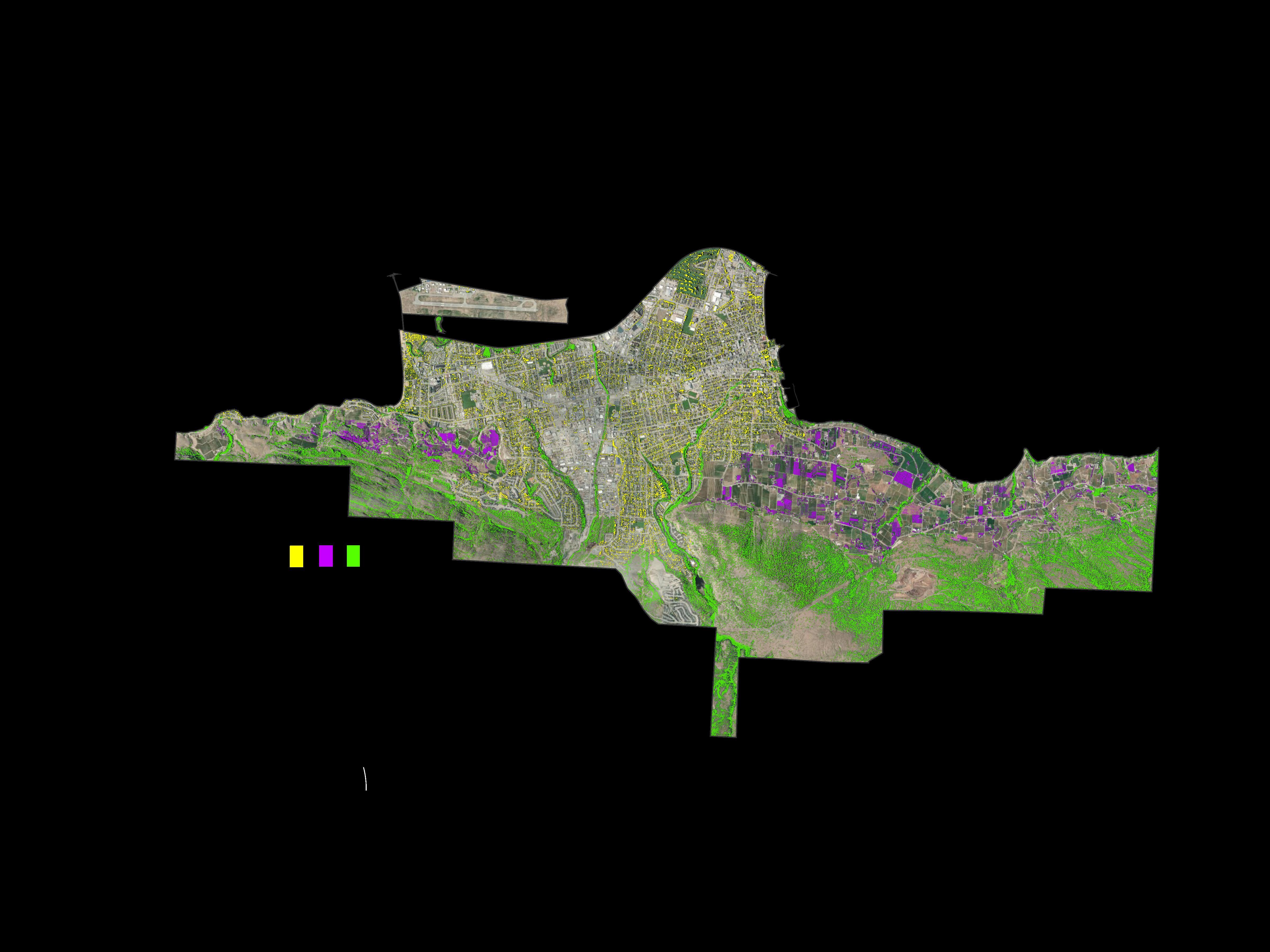 Figure 10. Penticton’s conceptual forest corridors.
Figure 10. Penticton’s conceptual forest corridors.
Ellis Creek Corridor
Penticton Creek Corridor
Skaha Lakefront Corridor
Channel-Oxbows Corridor
Wiltse Bench Corridor
Okanagan Lakefront Corridor
Urban Connections
i n the future, Penticton can enhance the role of Forest Corridors by improving the quality and connectivity of the urban forest. These Urban Connections are conceptual but reflect existing concentrations of urban tree canopy or planting opportunities that help bridge the gap between remaining natural forest areas. Both Forest Corridors and Urban Connections have many opportunities for enhancement through ecological restoration and tree planting. Creating additional connections between forest corridors is likely to require significant investments in improving planting sites in City streets as well as some new planting in parks or other urban settings. The location of urban connections can be refined through site assessments.

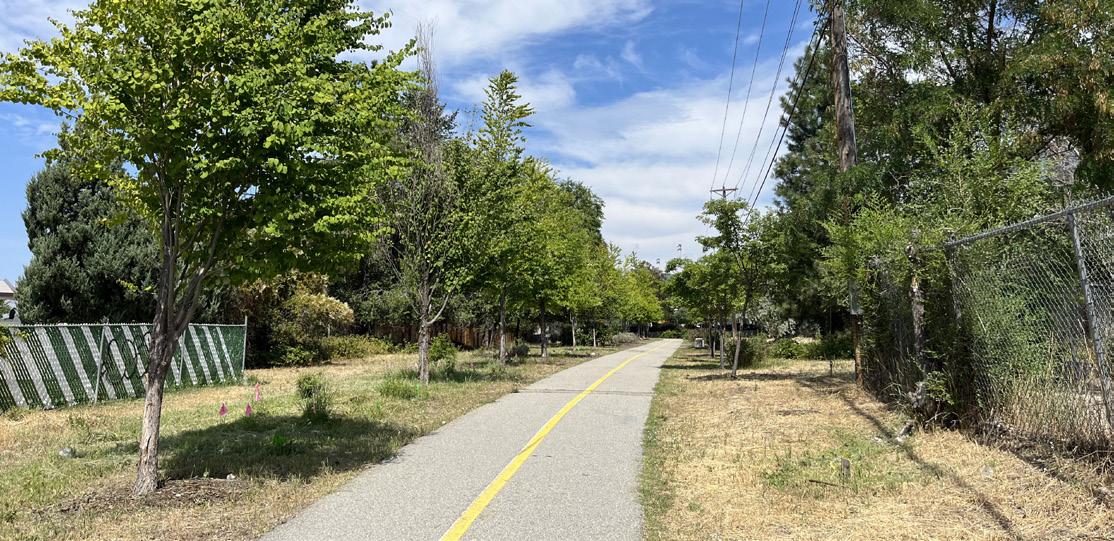
2 6
1 2 3 4 5 6
3.2 URBAN FOREST STRUCTURE
Urban forest structure refers to the size, age, and diversity of trees. Size can be used to broadly infer the age of the urban forest, as all trees start their lives as small saplings and only some grow to become large.
The Large Tree Argument
tree
$75 Bene ts/year
$30
Small tree
$17 Bene ts/year
$20 Costs/year
30 years life expectancy
11. Benefits and costs from a large tree and a small tree over their lifetimes.
The large tree argument recognizes that increasing tree size multiplies the potential provision of ecosystem services32 i t takes four trees with a canopy 5 m across to replace one tree with a canopy 10 m across. Large trees also provide
ecosystem services, particularly for habitat and biodiversity, that small trees cannot. Large trees are an essential piece of the urban forest that deserve planning and protection because they provide better value for management.
3.2.1 RESULTS FROM CANOPY MAPP i NG
Penticton’s urban forest is dominated by trees that are small in height and canopy area (Figure 12). Trees of 2 to 5 m in height represent 35% of all the trees in the City. A full 58% of trees in the City are less than 10 m in height. Just 9% of trees are 20 m in height or more. Trees of 20 m or more in height in Penticton represent large trees that are many decades if
not over one hundred years old. Despite their small number, these large trees provide 20% of the City’s 742 ha tree canopy. Trees 10 – 20 metres in height represent one-third of the City’s total trees but provide half of its total canopy. Trees less than 10 m tall provide less than one-third of the City’s canopy despite their considerable number.
Key trend: Large trees are difficult to replace. Tree protection can help delay the loss of the largest mature trees and preserve medium-sized trees with the potential to replace them.
24 City of Penticton | Urban Forest Management Plan (DRAFT - JUNE 2024)
Large
Large trees provide up to 100 times the community service value over typical service life as compared to small trees.
Costs/year 100
life expectancy
years
Figure
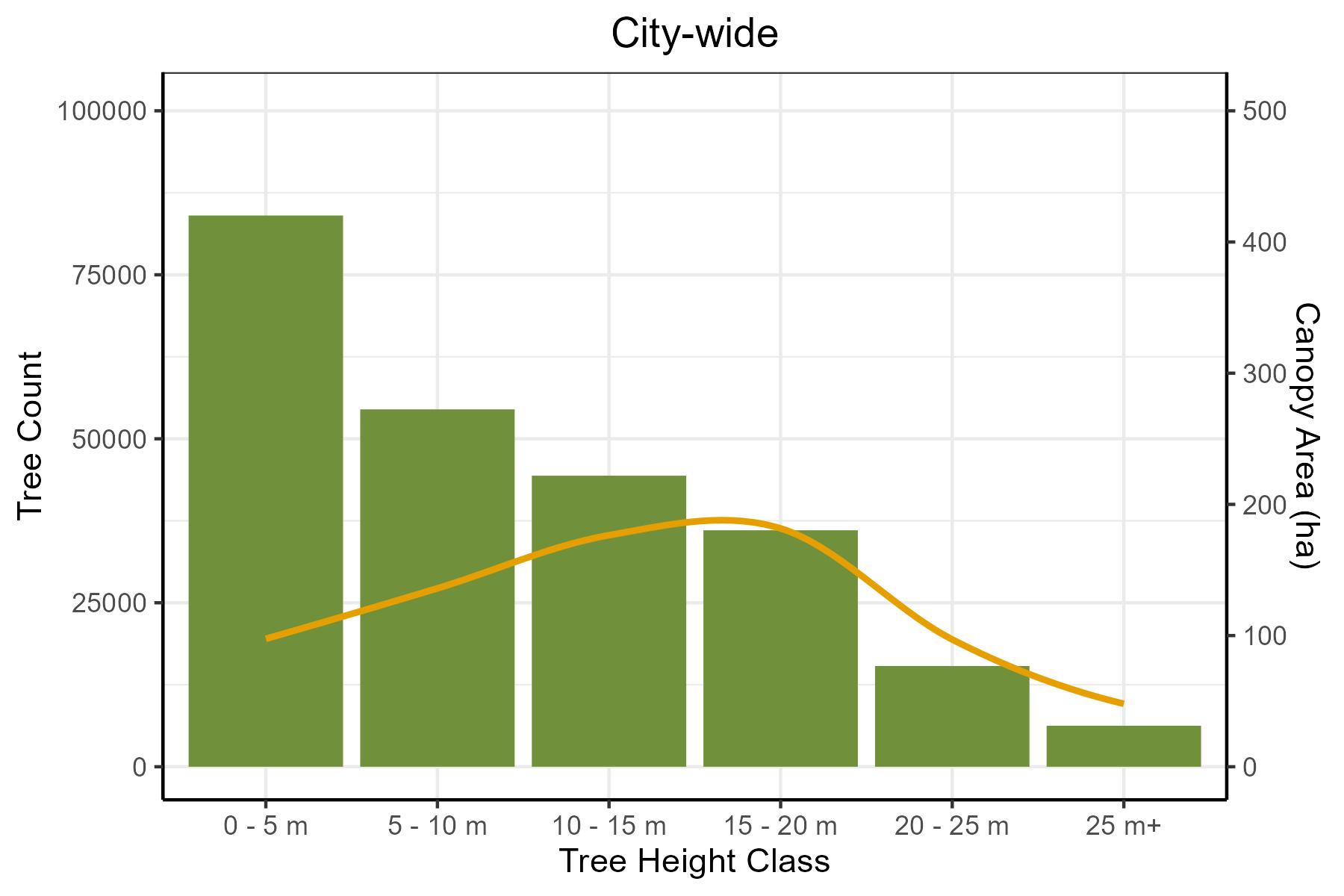
12. City-wide tree count (bars) and canopy area (line) by height class. Small trees (left) outnumber large trees, but provide far less canopy area.

<< This Ponderosa pine in the Penticton Creek watershed was measured to have a height of nearly 40 m.
13. LiDAR-detected heights of all trees in Penticton’s urban forest.
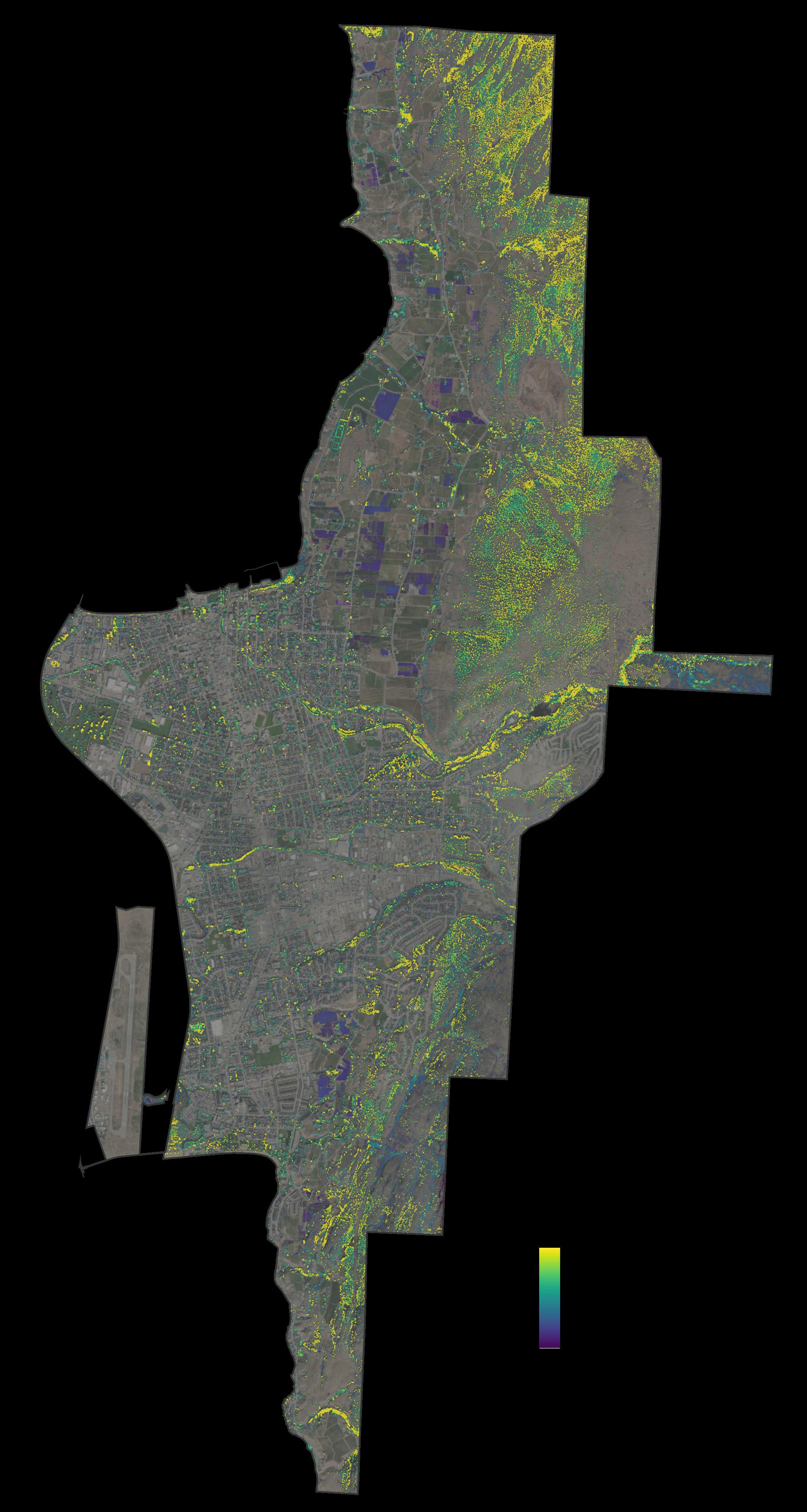
Tree height (m)
m
25 City of Penticton | Urban Forest Management Plan (DRAFT - JUNE 2024)
Figure
Figure
2
PENTICTON’S BIGGEST TREES
Penticton’s biggest trees are scattered widely. The City’s tallest trees are generally in natural areas, and reach heights of about 30 metres. Ponderosa pine and cottonwoods growing in riparian areas tend to be the tallest trees. Capable of rapid growth and living for centuries, the slight moisture advantage found around creeks and channels can be enough to propel them upward over their peers. The City’s older deciduous trees tend to have the largest canopy spreads. Trees with 110 m2 of canopy area or more are quite large, having an equivalent branch-tip to branch-tip spread of 12 m. Standout trees include cottonwoods in Lakawanna Park, a London plane on private property near downtown, and the silver maple on the lawn of the Provincial Courthouse. With a canopy area of about 450 m2 and a maximum height of 20 m, the courthouse maple might qualify as Penticton’s largest tree.
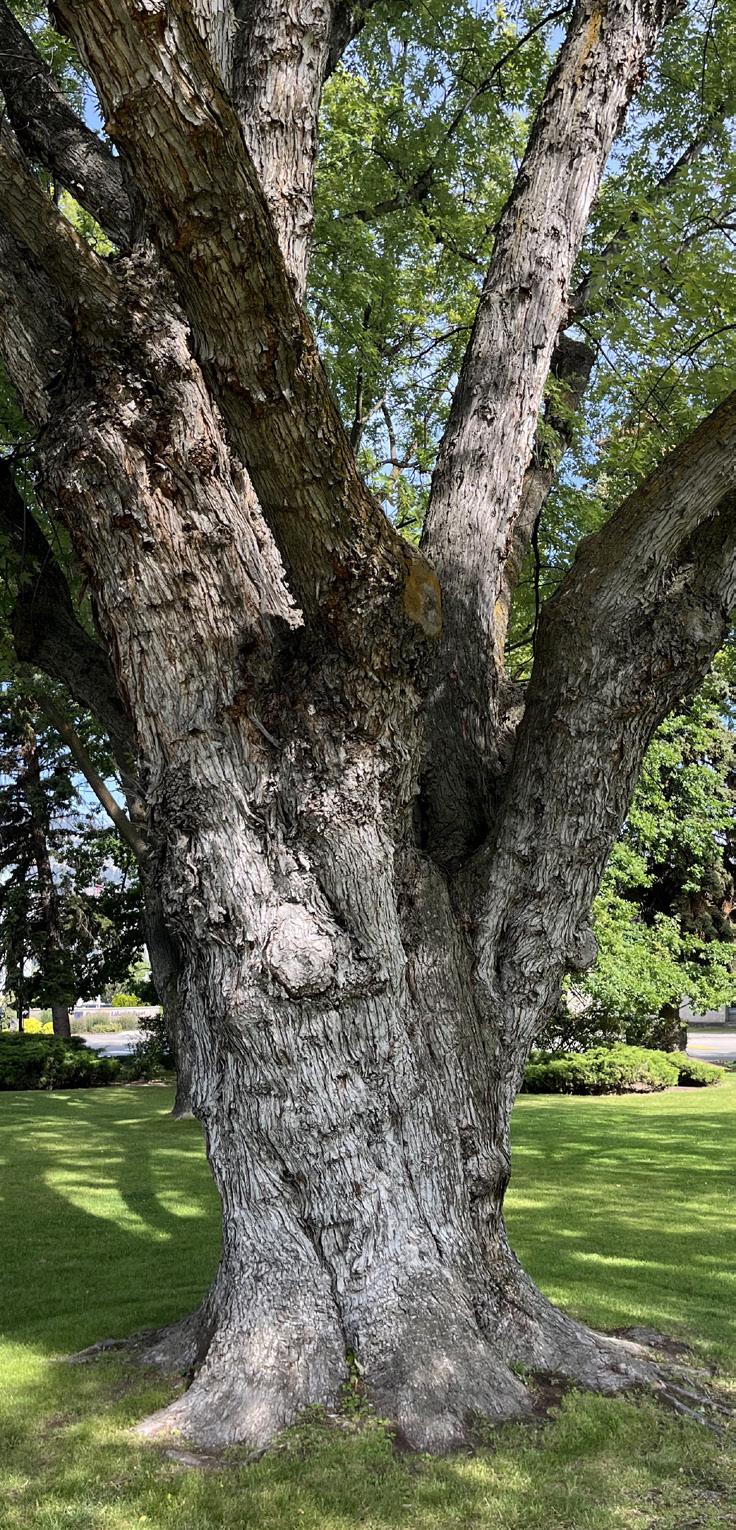
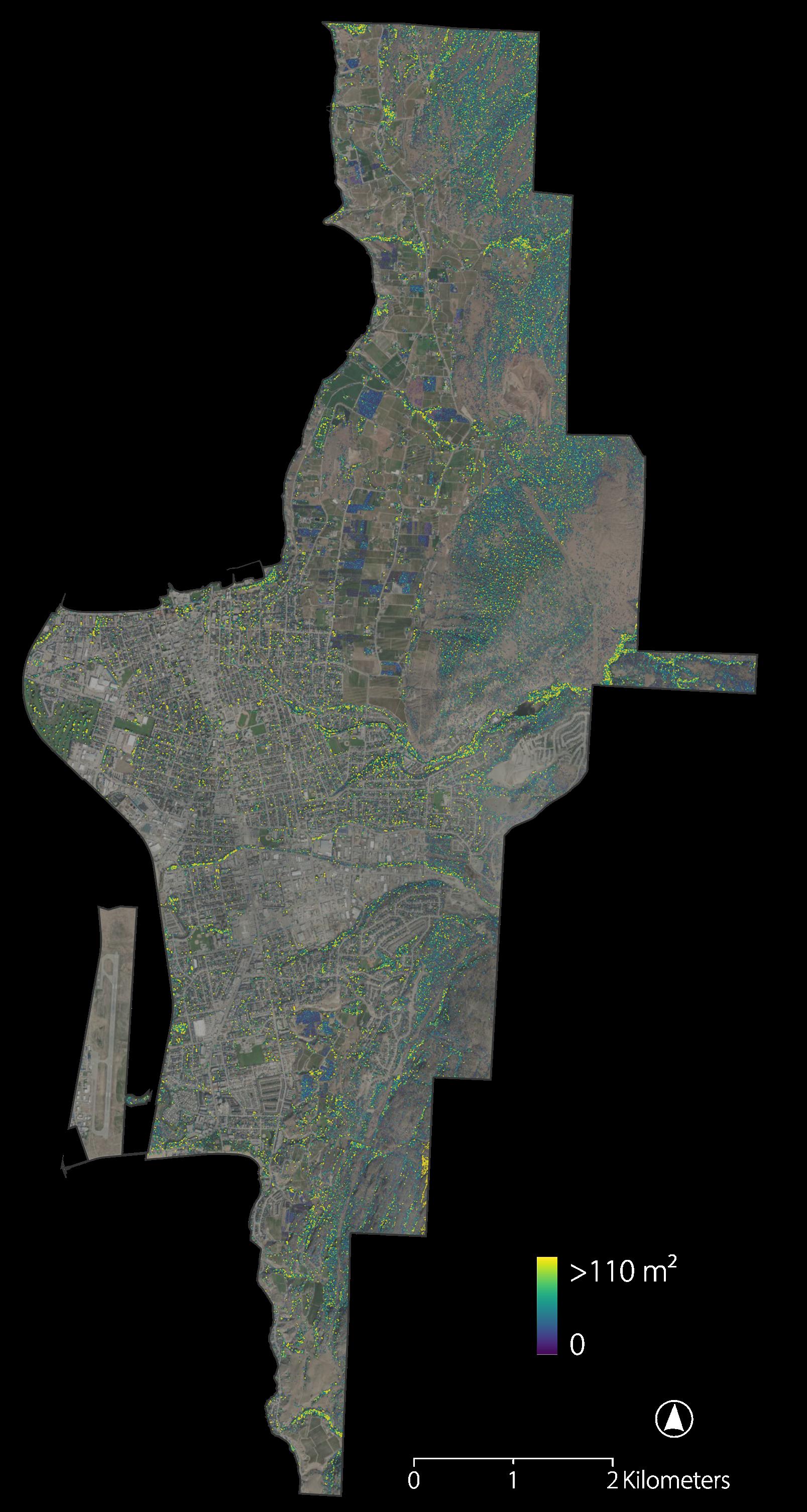
26 City of Penticton | Urban Forest Management Plan
Figure 14. LiDAR-detected canopy size in Penticton’s urban forest. Tree canopy size (m2)
3.2.2 D i VERS i TY i N THE C i TY’S TREE i NVENTORY
Genus (plural: genera) information recorded in the City’s inventory helps summarize diversity in the urban forest. Genera are closely related groups of trees, for example, the Maple genus contains all of the different species of maple. 50 genera belonging to 27 families are present in the tree inventory. The most common genus is Maple (Acer), representing 23% of the inventory, followed by Pine (Pinus), with 11% of the inventory. Honey Locust (Gleditsia), Ash (Fraxinus), and Elm (Ulmus) contribute about 5% each to the inventory.
A common rule of thumb for managing diversity in the urban forest is the “10-20-30 Rule”17, which states that no more than 10% of the urban forest should belong to any one species, no more than 20% should belong to any one genus, and no more than 30% should belong to any one family. Except for Maple (Acer), Penticton’s tree inventory meets this guidance at the genus level. All 27 families in the tree inventory meet the 30% guideline (Sapindaceae, to which maples belong, leads with 26%). Species-level information is not recorded consistently enough to assess whether the rule is met. Diversity rules are inapplicable to natural forests, where only a few native tree species are appropriate for planting.
Key trend: Although the urban forest has increased in diversity over time, some genera/species dominate in urban areas. 10 genera make up two-thirds of the tree inventory. This is because some trees, including Acer rubrum (red maple) and Gleditsia triacanthos (honey locust), are relatively common in source nurseries and have a demonstrated tolerance for urban conditions. The City’s preferred tree species list notes only Gleditsia as over-represented in the City and should be updated to reflect overplanting of maple. Diversity is a hedge against mounting challenges because many mortality factors are family-, genus-, or species-specific.
Ginkgo
PENTICTON’S TREE INVENTORY
The City has a digital record of just under 8,400 trees on public and private property. This record is called a tree inventory. The tree inventory serves the Parks Department and Electrical Department. Trees in the inventory found on private property were previously pruned by the Electrical Utility. i nventoried trees on public property are mainly park and street trees maintained by the Parks Department. Attributes recorded for each tree in the inventory vary based on the purpose of including the tree and who completed the field assessment. Most entries identify the tree’s genus, height and diameter at breast height (dbh). Some records also indicate the tree’s species and other notes.
i n total, 6,881 trees in the inventory are on City property or are City-managed. This includes 2,085 trees in public rights-of-way, 4,796 trees in City parks, gardens, and other properties. Another 820 trees in the inventory are on public land not managed by the City, like school district property or provincial land, and 683 are on private property. The tree inventory can be explored via the City’s open data website.
27 City of Penticton | Urban Forest Management Plan (DRAFT - JUNE 2024)
23% 11% 5% 5% 5% 4% 4% 3% 3% 3% 3% 3% 3% 2% 2% 2% 2% 1% 1% 1% 1% 1% 1% 1% 1% 1% 1% 1% 1% 1% 1% 0% 5% 10% 15% 20% 25% Acer Pinus Gleditsia Fraxinus Ulmus Crataegus Tilia Cedrus Picea Platanus Carpinus Populus Quercus Syringa Juniperus Koelreuteria Pyrus Abies Fagus
Robinia Salix Malus Aesculus
Amelanchier Prunus
Betula Sorbus Phellodendron Morus Thuja
Top 10 genera
Figure 15. Genus distribution of trees in Penticton.
3.3 LAND USE AND THE URBAN FOREST
Understanding how the urban forest relates to land uses in the City informs our predictions of future trends like the rate of tree loss and replanting with development. i t also points toward where there are major opportunities for tree planting and policy amendments that can help sustain the urban forest for the long-term. Future land use is defined by the Official Community Plan (OCP), which sets a high-level direction for the kinds of economic activities that can occur in different parts of Penticton, and the Zoning Bylaw, which details the permitted land use on specific properties.
3.3.1 CANOPY COVER BY THE OCP FUTURE LAND USE
i n the OCP, Future Land Use is mapped to show where and what type of development will be supported in Penticton. Future Land Use designations in the OCP were updated in 2024 in response to the recommendations of Council’s Housing Task Force. Future Land Use may align with the existing form of development in a neighbourhood where only modest change is planned, but it can also indicate where changes in the form and character of an area are planned. Land uses that take up a larger area in the City will have a greater influence on the overall urban forest.
While canopy cover city-wide averages 17%, it varies widely by land use. i n highly urbanized land uses like Downtown Mixed Use, Commercial, i ndustrial, and general Mixed Use, canopy cover averages less than 5%. Canopy cover over roadways is just 6%, though this includes long distances of rural roadway where tree planting would be of limited benefit to most residents. The average canopy cover across all urban land uses is 12%, with only Low Density Residential land use having canopy cover higher than this – at 17%. Natural and Conservation Areas, Parks, and First Nations land have the highest average canopy cover at 28-29%. Cover on Rural Residential property is also high at 25%. Agricultural land has 13% canopy cover. Because of right-to-farm legislation, the City has limited influence over the urban forest on agricultural property.

28 City of Penticton | Urban Forest Management Plan (DRAFT - JUNE 2024)
Figure 16. Future land uses in Penticton’s Official Community Plan.
Key trend: Greenfield development where future residential land uses are currently occupied by natural forests could result in the net loss of 17 hectares of tree canopy during the next 20 years, with additional net loss of up to 29 ha occurring on other land uses (even with tree planting required under current zoning rules). Estimated canopy losses depend on factors the City can influence, like tree protection and development rules, as well as factors mostly beyond its control like climate-driven events, forest health issues, and conversion of orchards to vineyards. To avoid or offset the potential loss of trees over 20 years, the City will need to consider both new tree planting efforts and opportunities to slow canopy loss through enhanced tree protection.
How land use bylaws shape the urban forest
The OCP and Zoning Bylaw provisions complement each other, with policies in the Official Community Plan providing targets and guidelines general to all development or development within defined map areas and the Zoning Bylaw providing enforceable standards. Both sources of information can guide landscaping or tree cover. For example, Penticton’s North Gateway Plan (a sub-plan of the OCP) contains a target to retain
and double tree canopy in the area
the Zoning Bylaw contains a requirement to plant trees on single-family and duplex properties. Landscaping provisions in the Zoning Bylaw are powerful tools for urban forestry because landowners are compelled to meet the Zoning Bylaw standards, sometimes taking precedence over other bylaws or City policies. A third bylaw, the Subdivision and Development Bylaw, controls the creation of the public realm in the City by enabling engineering standards for streets, utilities, and tree planting on public property.
29 City of Penticton | Urban Forest Management Plan (DRAFT - JUNE 2024)
existing City
development,
trees
through
while
LAND USE LAND AND CANOPY AREA (HA) 896 112 110 0 20 13 0 3 3 29 12 3 8 24 17 5 28 29 6 25 18 24 7 328 39 117 4 98 8 105 25 565 94 106 5 657 183 389 369 473 16 1 119 24 8 112 1 0 Airport Commercial Downtown Mixed Use First Nations High Density Residential Industrial Institutional and Civic Land ll and Land ll Bu er Low Density Residential Mixed Use Parks Rights-of-Way Rural Residential Tourist Commercial Land area Canopy area Natural and Conservation Areas CANOPY COVER (%) Agriculture
Figure 17. Land area, canopy area, and canopy cover in each Future Land Use (2024 OCP update).
3.3.2 i MPERV i OUS SURFACES AND PLANTABLE S i TES
The Zoning Bylaw regulates requirements like lot line setbacks and total site coverage by buildings. Maximum lot coverages by zone are good indicators of where trees face the most limiting environments. Maximum lot coverage in the City ranges from 10% in conservation lands to 100% (allowing wall-to-wall construction) in downtown areas. i ndustrial areas have no maximum lot coverage, reflecting the unique operation and delivery needs of these facilities. Where allowable lot coverage exceeds 50%, space for larger trees becomes limited. When lot coverage exceeds 80%, the City’s public realm (mainly streets and parks) becomes essential for providing tree canopy to neighbourhoods. Beyond lot coverage, landscape area for tree planting can be further limited by patios, driveways, parking, or other impermeable surfaces.
Lot coverage in the Zoning Bylaw represents what is allowed to be built on a property, but many properties are not currently built to their maximum lot coverage. To estimate the current availability of permeable landscape areas, an assessment was made using i-Tree Canopy software, which creates a statistical estimate of different land covers from user review of aerial photographs. The 2020 orthophotography supplied for the city’s canopy analysis was used for this review. These results indicate that within the municipal boundary, 28% of the land (1,200 ha) is covered by impervious surfaces. 38% (1,700 ha) of land is permeable surface that potentially could be planted, of which two-thirds (1,200 ha) are private property and one-third (500 ha) is public property. An additional 14% (600 ha) of land has permeable surfaces unsuitable for tree planting – these areas present clear land use conflicts that exclude trees, like the middle of playing fields, agricultural fields, and safety clearances at Penticton Airport. Although 38% of the city’s land base was assessed to be potentially suitable for planting, much of these places could be impractical (located in difficult to access places), ecologically unsuitable (e.g., grassland environments or moisture-limited pine forests), or could be ruled out by conflicts with infrastructure or land use on further investigation.
Key
trend:
i mpervious area in the
19. i-Tree canopy results of land cover by surface type.
City will trend upwards as development proceeds and land use intensification occurs. Zones with 50% maximum lot coverage or more already present challenges for finding tree planting sites, making regulating planting site requirements through landscape area standards for these sites important to preserve the urban forest on private property in the long-term. i n neighbourhoods where lot coverage on private property exceeds 80%, such as Downtown and most industrial areas, the public realm becomes essential for providing urban forest canopy. i n hardscapes, trees often need engineered soil and irrigation solutions to preserve planting site value.
30 City of Penticton | Urban Forest Management Plan (DRAFT - JUNE 2024)
OPTIMAL COMPROMISED
Unlimited, uncompacted soil volume
Impermeable surface
sub-grade
Permeable
surface
Compacted
Service conduits
Figure 18. i mpervious surfaces can impact tree longevity.
i mpervious Public Unsuitable Private Suitable Public Suitable
Figure



<< Zoning downtown allows wall-to-wall construction, limiting tree planting on private property. i n downtown, the urban forest is mainly street and park trees.
<< i ndustrial zones have no maximum lot coverage. Large aprons and driveways make street tree planting difficult.
<< Lower maximum lot coverages in Low Density Residential areas can help preserve room for trees on private property and in boulevards, but a legacy of low tree planting means these areas may not have many trees.
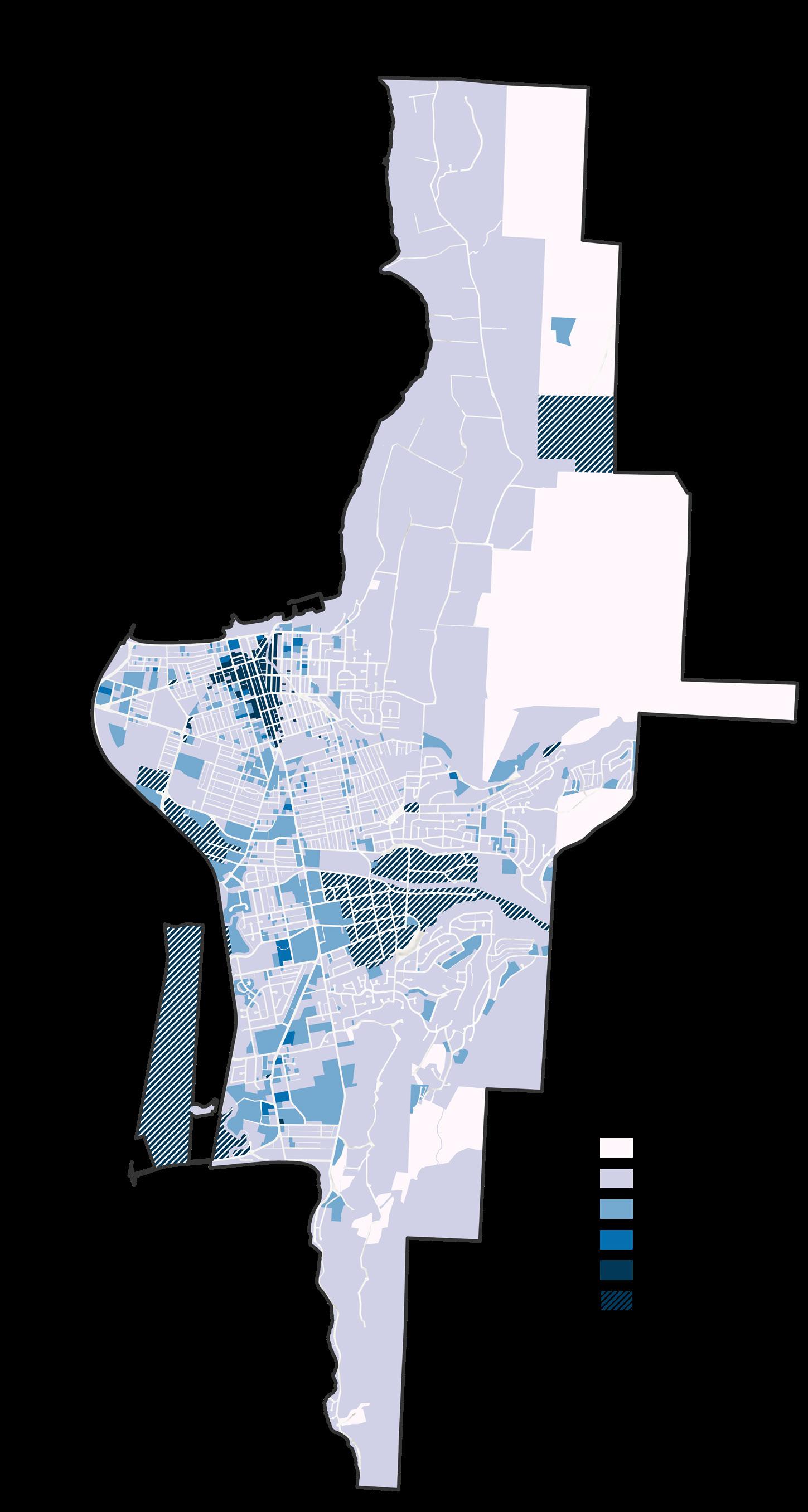
Maximum lot coverage (%)
31 City of Penticton | Urban Forest Management Plan (DRAFT - JUNE 2024)
Figure 20. Maximum lot coverage by impervious surfaces in Penticton’s zoning.
3.4 TREE EQUITY
Canopy cover in Penticton is not evenly distributed throughout the City. This uneven distribution impacts the health of our society and community, because it means people living in the City have different access to urban forest ecosystem services. The idea that every person deserves to have access to the benefits of trees is called tree equity. Several studies have shown that urban tree canopy tends to be higher in neighbourhoods with higher socioeconomic status and lower in areas with more socially disadvantaged people18,19,20,21 This is an important issue for urban forest management because environmental quality is a strong influence on people’s life outcomes. Younger children and older adults, for example, tend to be more vulnerable to extreme heat, and lower-income households may not be able to afford modern building cooling systems.
An American non-profit organization, American Forests, has developed a method for calculating the equity in the distribution of a community’s urban tree canopy The approach called the “Tree Equity Score (TES)” explores how closely tree canopy and surface temperatures align with socioeconomic factors. To apply to Penticton, American Forests’ method was adapted to use socioeconomic data available from the Canadian Census of Population. The adapted TES ranges from 0 to 100 and has been calculated for each census dissemination area in Penticton. A score of 100 indicates that tree equity has been achieved. Lower scores correspond to census dissemination areas where there is a combination of low canopy cover, high land surface temperature, and a high proportion of seniors and children, visible minorities, lowincome people, and unemployed people.
Table
Indicator Description
Climate Land surface temperature, as measured from remote sensing data
i ncome Percentage of people living on incomes below 200% of the federally designated poverty line (less than $40,000 per annum)
Age Seniors (age 65+) and children (0-14) as a proportion of working age adults (15-64).
Ethnicity Percentage of people who belong to visible minority groups, as defined by the Employment Equity Act and, if so, the visible minority group to which the person belongs.
Unemployment Percentage of unemployed people within the labour force.

City-wide average: 78
32 City of Penticton | Urban Forest Management Plan (DRAFT - JUNE 2024)
1. The five socio-economic indicators used in the priority index.
Figure 21. Tree Equity Score map by census dissemination area.
Tree Equity Scores in Penticton range from 53 to 100 (where 100 indicates tree equity is being achieved). The average TES across census dissemination areas is 78. Areas of below average TES are high priority locations for tree planting and tree retention to ensure residents have equitable access to urban forest benefits. Areas of low tree equity in Penticton are mainly found in valley-bottom residential areas, especially those where high temperatures coincide with higher numbers of seniors living on fixed incomes. Portions of the Wiltse neighbourhood also have low tree equity, driven by low existing canopy cover, high land surface temperature, and a relatively high proportion of visible minority population.
Key trend: Tree Equity Score mapping highlights neighbourhoods in Penticton where tree canopy is low relative to indicators of social vulnerability. These neighbourhoods tend to be older residential areas in the valley bottom, where the urban heat island is strongest, that overlap with high numbers of seniors. i ncreasing tree canopy in these areas can help reduce incidents of extreme heat-related illness, which disproportionately impacts seniors.

33 City of Penticton | Urban Forest Management Plan (DRAFT - JUNE 2024)
3.5 WHO MANAGES THE URBAN FOREST
Land ownership determines how trees are managed in the City. About one-quarter of the urban forest is owned or managed by the City, including approximately 43,000 trees in City parks and 8,400 trees in road rights-of-way. Another 43,000 trees are on other public land, i.e. crown land or property maintained by another government, including School District properties. Approximately 150,000 trees, or over half of the urban forest, are on private property.
On private property, the City’s influence over the urban forest is limited. Landowners make decisions about how to care for trees on their property. The City currently interacts with private landowners regarding their trees for the following purposes:
• The Electrical Utility requires tree maintenance to access or protect its infrastructure.
• The Good Neighbour Bylaw allows the City to issue an order compelling an owner to clear unsightly or nuisance vegetation.
• Development rules in some areas, such as the Hillside and Streamside Development Permit Areas, require a tree survey and arborist report be provided prior to the permitting of new construction.
• Zoning rules require one tree to be planted for every new primary unit of single-family and duplex housing.
• There is a request for the removal of trees that are shared property with the City.
• When construction activities are occurring near City trees or shared trees.
On City property, trees are protected by the Municipal Tree Protection Bylaw. Caring for trees on City property is the responsibility of the Parks Department, which undertakes care for urban forest asset classes as described in Chapter 4.
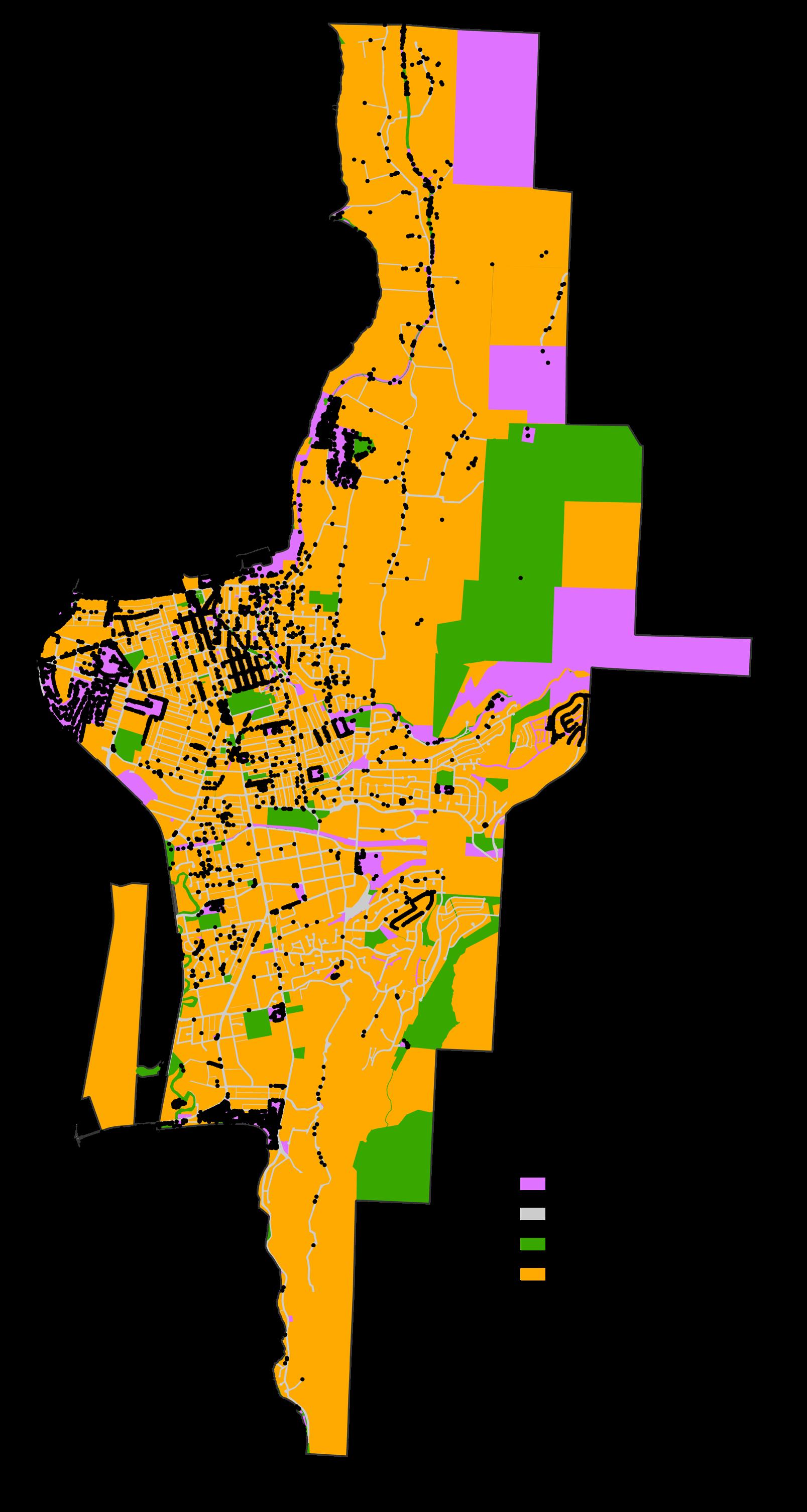

34 City of Penticton | Urban Forest Management Plan (DRAFT - JUNE 2024)
Figure 22. Generalized land ownership in Penticton.
OWNERSHIP
Key trend: Only trees on City property are regulated by a tree protection bylaw. On City property, current urban forestry resources and policies are insufficient to provide one replacement tree for each tree removed. i n 2022, 85 trees were removed from City property and only 30 replacement trees were planted. The number of trees lost from private property is not known, unless a development permit is required. Likewise, planting requirements in the Zoning Bylaw are not tracked following construction. Presently, trees planted under the Zoning Bylaw can be removed at any time by the landowner following development. For these reasons, staff expect that the current rate of tree canopy loss exceeds the rate of replacement.

35 City of Penticton | Urban Forest Management Plan (DRAFT - JUNE 2024)
LAND
(HA) SHARE OF THE CITY’S CANOPY (%) 633 154 21 4 20 56 147 414 29 379 901 2,820
Public
Public
Private
AND CANOPY AREA
City-owned parks and property
streets
(other)
Land area Canopy area
Figure 23. Land and tree canopy of each generalized ownership, with the share of the City’s urban forest represented.
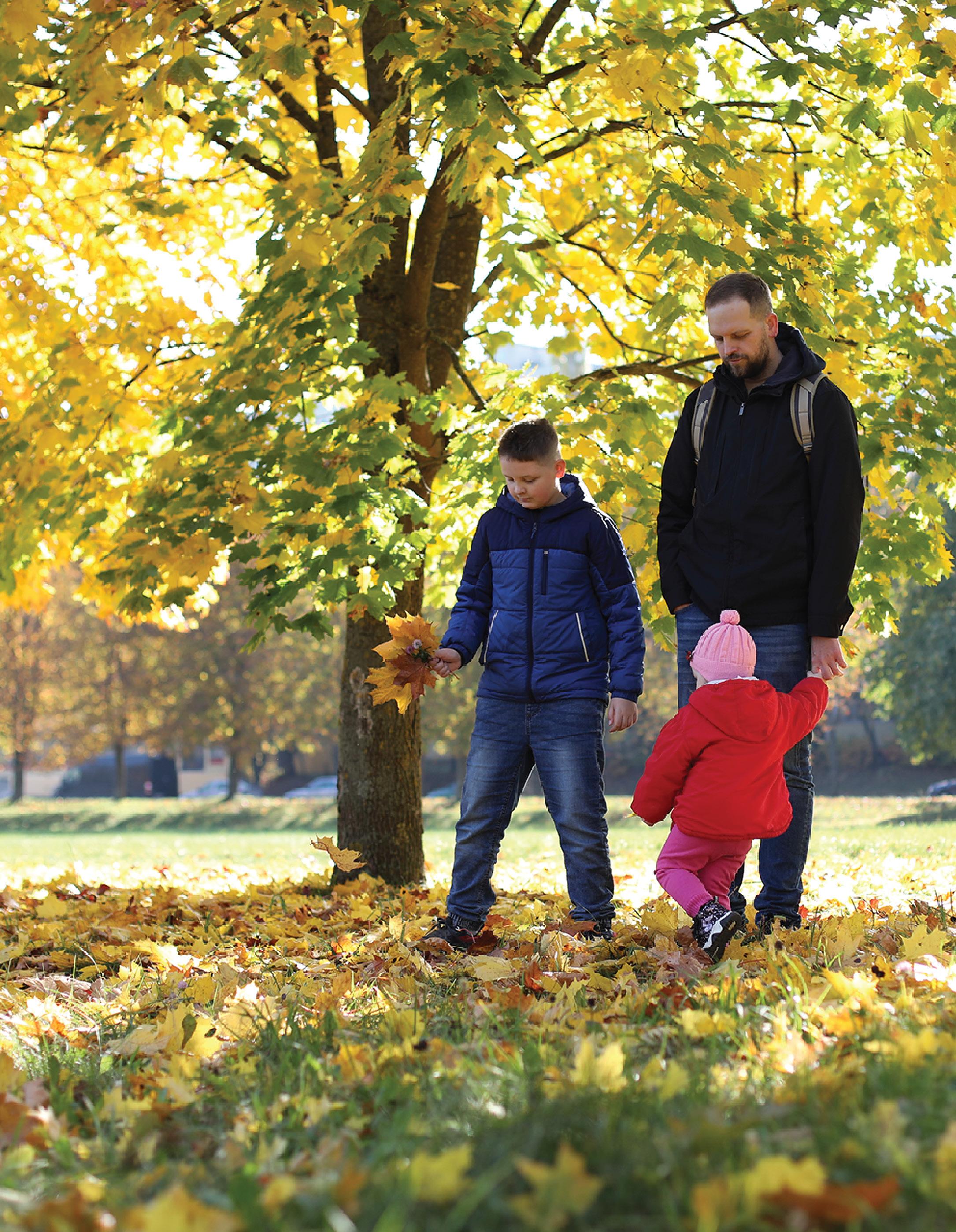
PENTICTON’S URBAN FOREST PROGRAM
CHAPTER 4.
Penticton’s urban forest program is the collection of policies, procedures, and resources used by City staff to manage trees and forests, as well as people involved in the City’s management activities (including staff, contractors, and volunteers). The Parks Department has the overall responsibility for the urban forest program, while other City divisions support by enforcing bylaws and permit regimes that influence urban forest outcomes.
4.1
TREE ASSET CLASSES
The urban forest building blocks can be further divided into asset classes that require similar management because of their location or condition. The asset classes in Table 2 shape tree management in the City.
Boulevard (street) trees
Trees in public rights-of-way are maintained by the City and some are represented in the City’s tree inventory. Boulevard trees not in the inventory may have been planted by neighbouring landowners in the public boulevard or self-seeded onto City property. Boulevard trees often require relatively high service levels for watering, pruning, and other management because they grow in soil-limited environments with many potential conflicts with buildings, traffic, or infrastructure. A small number of boulevard trees receive proactive, or scheduled, maintenance; however service levels are primarily driven by public complaints.
Ornamental and shade trees on public property
Trees in urban parks and on other City property are maintained by the City. Some are represented in the City’s tree inventory. These trees have generally been planted by the City or with its approval. These trees may occur in highuse areas where foot traffic, special events, or recreational activities can cause damage over time. While relatively high service levels are desirable for these trees, the services needed may differ from those required by boulevard trees or occur with different frequency. This asset class is further subdivided internally into Class A, B, and C parks and beaches, City-owned parking lots, undeveloped lots, and buildings/facilities.
Trees in forested parks and trails
Trees in natural or naturalized forests are inventoried as groups or stands, not individual trees. Trees in these areas have generally lower levels of service and do not receive watering or pruning. Trees in these areas are usually managed as groups or forest stands (forested areas of similar character subject to similar influences). i ndividual tree management sometimes occurs to address tree risk along trails and City-owned rights-of-way. Management is usually driven by complaints from the public.
Trees on private property
Trees on private property are managed and maintained by their owners. The City sometimes enforces tree pruning or maintenance on private property to ensure reliable and safe access to Electrical Utility infrastructure. Private trees that have been pruned or requires pruning by the Electrical Utility are included in the City’s tree inventory but are recorded with less information than City-owned trees.
37 City of Penticton | Urban Forest Management Plan (DRAFT - JUNE 2024)
Urban
Building Block Tree Asset Class Description
Trees
Natural Forests
Urban Trees Natural Forests Rural Trees
Table 2. Tree Asset Classes within Penticton’s urban forest.
4.2 POLICIES
Policies such as bylaws, Council policies, plans, and operational standards or guidelines created by the City of Penticton impact how the urban forest is managed. The City takes a leading role in shaping the urban forest through its mandates for trees, municipal services, and land use planning.
4.2.1 H i GHER GOVERNMENTS
Provincial legislation, primarily the Community Charter and Local Government Act, allows municipalities to regulate the protection and management of the natural environment and affords other powers which can relate to urban forest management. Legislation such as the federal Species at Risk Act, Migratory Birds Convention Act, Provincial Heritage Conservation Act, and Water Sustainability Act can affect urban forest and natural areas management. The City has no authority in reserve lands of the neighbouring Penticton i ndian Band, though maintains relations with the Penticton i ndian Band to discuss matters of mutual interest. The City seeks to respect, honour and promote expressions of Syilx (Okanagan) culture and heritage in Penticton. i n the future, this may influence the City’s urban forestry.
Tree Damage
Building Bulletin No. 16-10 (Protection of City Boulevards and Trees)
Expectations and Responsibilities for Tree Inspections and Maintenance Activities
Parks Tree List
Tree Pruning Procedure
Windstorm Emergency Response
Enabling Legislation
Sustainability Act [BC]
[BC]
Heritage Conservation Act [BC]
Species at Risk Act [Canada]
Migratory Birds Convention Act [Canada]
Building Bylaw
Development Procedures and Delegation Bylaw
Good Neighbour Bylaw
Municipal Properties Tree Bylaw
O cial Community Plan Bylaw and Development Permit Area Guidelines Park Regulation Bylaw
Subdivision and Development Bylaw Zoning Bylaw
Land Acquisition Policy
Parks Donation Policy
Management Investment Plan Riparian Areas
Reserve Policy
Parks and Recreation Master Plan
Community Climate Action Plan
Community Wild re Resiliency Plan
Housing Needs Assessment
Integrated Infrastructure Master Plan
Figure 24. Regulatory context for urban forest management in the City of Penticton.
38 City of Penticton | Urban Forest Management Plan (DRAFT - JUNE 2024)
Local
Procedures and Guidelines Bylaws and Council Policies Plans and Reports Urban Forest Management Plan
Government Act and Community Charter
Avoiding
Asset
Protection Act
Water
North
Plan Financial Plan
Gateway
4.2.2 MUN i C i PAL BYLAWS AND COUNC i L POL i C i ES
Penticton has several Bylaws and Council Policies that play key roles in shaping the urban forest. Some of the most significant are:
Tree protection & maintenance
The Municipal Properties Tree Bylaw is the primary bylaw through which the City protects trees on public property. The bylaw provides for the management, improvement, and operation of the urban forest of any property held by the City of Penticton. The bylaw also contains definitions relevant to the City’s urban forest planning and tree protection regimes. Although the bylaw establishes a list of heritage/significant trees in Penticton, significant trees are not given specific protection and can be removed without a permit from private property.
The Parks Regulation Bylaw regulates the use of City parks, prohibits the planting of certain tree species, and prohibits tree damage. The Parks Department also uses procedures documents that inform activities such as tree pruning, avoiding tree damage, protection of boulevard trees, expectations and responsibilities for tree inspections and maintenance activities, windstorm emergency works, and acceptable species to be planted in parks.
Council Policies provide direction on how Council and the City conduct its business and thus may affect the interactions between the public and the City of Penticton. The Land Acquisition Policy, Parks Donation Policy, and Reserve Policy allow the City to gain parcels of land, have trees donated to parks, and establish an Urban Forest Reserve Fund that is used to fund tree planting and receive cash-in-lieu of planting.
Planning, land use, and tree planting
The Official Community Plan Bylaw adopts Penticton’s Official Community Plan (OCP), a strategic document establishing a vision for planning and land use in the community until 2045. The OCP also establishes Development Permit Areas (DPAs), which are regulatory tools that allow the City to place additional requirements on development, including tree retention in environmentally sensitive areas.
The Subdivision and Development Bylaw defines minimum acceptable standards for the design and construction of municipal infrastructure, adopts the Master Municipal Construction Document, and includes specific requirements in certain DPAs. Boulevard trees are designated works and services under this Bylaw, meaning their installation can be a condition of development approval. The Bylaw also sets out what information requirements apply to applications.
The Zoning Bylaw regulates specific land use, building forms, and densities, as well as lot coverage and private property tree cover. Penticton’s bylaw was recently amended to include a new planting requirement for trees on newly constructed single-family and duplex properties.
39 City of Penticton | Urban Forest Management Plan (DRAFT - JUNE 2024)
4.3 BUDGET AND RESOURCES
Penticton’s urban forestry program had an operational budget of approximately $250,000 in 2023. Three core staff provide approximately 1.75 full time equivalent (FTE) hours, taking care of tree pruning and removals, maintenance, and stewardship. An additional $15,000 per year in contracted services supplement City staff, particularly for utility arborist work and tree removal around power lines. Several dozen trees on City property are trimmed by the Electrical Utility each year, which is paid for by the utility’s budget. The total cost of delivering urban forest management in Penticton includes costs absorbed by the broader Parks Department budget for referral, plan review and program administration. Some costs, like referrals with the public or other departments on tree issues, are not specifically funded. Other departments carry out activities that support the urban forest, which are accounted separately from the Parks budget.
Resources
• 3 core staff, 1.75 FTE for tree care, planting, City tree protection.
• Bucket truck with 40-ft reach
• Chipper
• One-ton truck (shared)
• 3-ton truck (shared)
• Misc. equipment (Saws, PPE, climbing gear)
• Gator bags (watering non-irrigated trees)
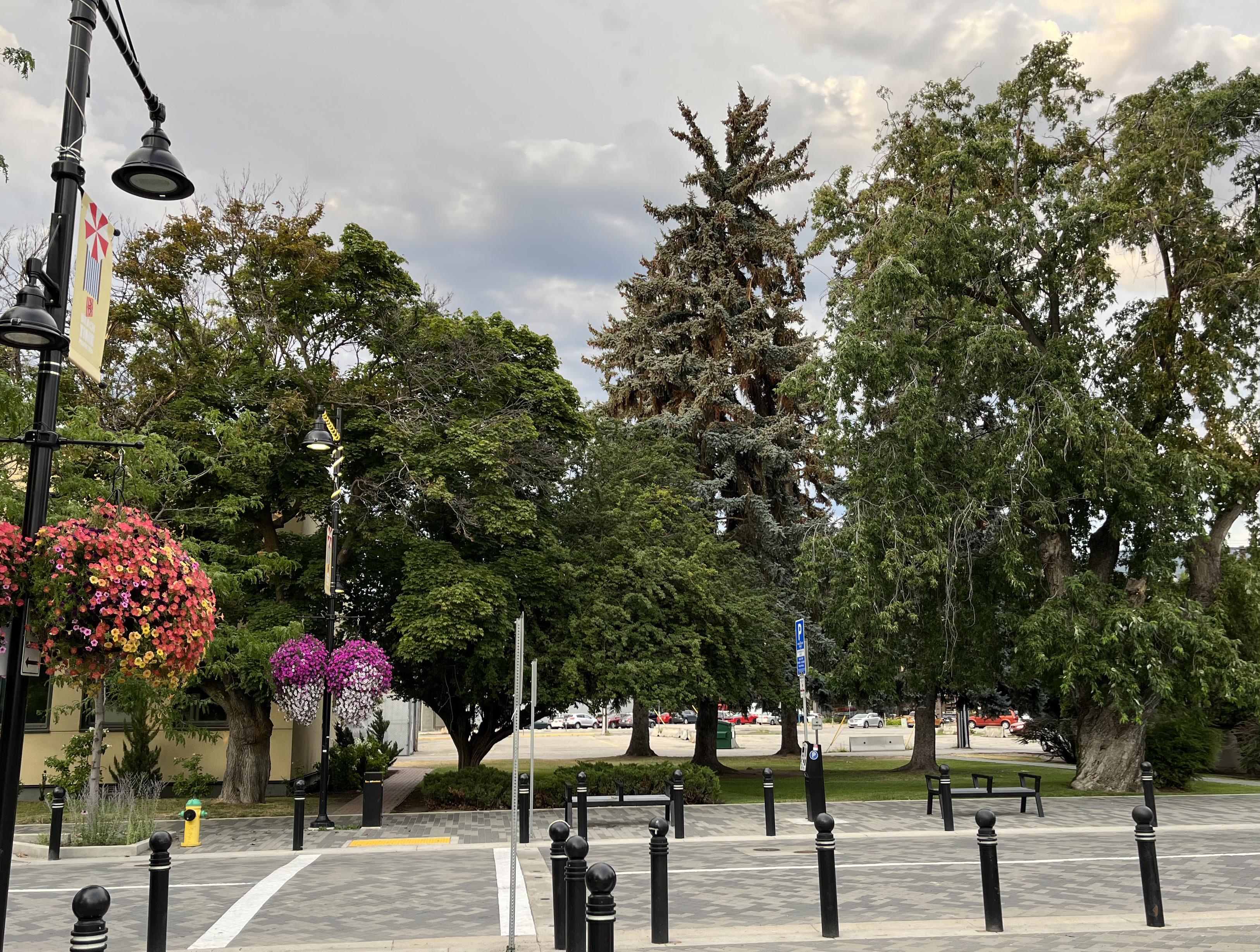
40 City of Penticton | Urban Forest Management Plan (DRAFT - JUNE 2024)
Table 3. Key resources for providing urban forestry services.
4.4 PROGRAM REPORT CARD
The urban forest report card uses a “criteria and indicators” method to evaluate the City’s urban forest program for 2023. The approach used is based on a framework for sustainable urban forest management prepared by the US Forest Service23 Criteria are areas of performance that appear in commonly used best practice guidelines or have been recommended by academic research in urban forestry.
Penticton’s performance is “fair” overall, which is typical for cities of similar size and levels of investment in urban forestry. Fair or poor ratings characterize the City’s performance on all five themes: Providing Care, Partnership, Planning, Planting, and Protection . The overall Fair rating reflects an urban forest program that has core components in place but lacks the resources and capacity to provide the service levels for urban forestry desired by the public.
POOR
CARE
PROVIDING CARE
Tree inventory
Knowledge of trees on private property
Natural areas inventory
Age diversity in the inventory (size class distribution)
Species diversity (public tree inventory)
Species suitability for local area
Publicly owned tree condition
Maintenance of public, high-visibility trees
Extreme weather response planning
Tree risk management
Pest and disease management
Waste biomass utilization
PARTNERSHIP
response planning management management utilization
PARTNERSHIP trees on private property inventory the inventory (size class distribution) (public tree inventory) for local area tree condition public, high-visibility trees
Citizen involvement and neighbourhood action
Involvement of large private and institutional landholders
Urban forest research
Regional collaboration 2023 URBAN FOREST REPORT CARD
41 City of Penticton | Urban Forest Management Plan (DRAFT - JUNE 2024)
POOR
GOOD OPTIMAL
2023 URBAN FOREST REPORT CARD
FAIR
FAIR GOOD OPTIMAL
PLANNING
General awareness in the community and across City departments of the value of the urban forest.
Cooperation between departments and agencies on Urban Forest management implementation
Clear and defensible goal for urban forest canopy cover
Tree canopy cover relative to established canopy targets
Municipality-wide urban forest management plan
Municipal green infrastructure asset management
Municipal-wide biodiversity or greenspace network strategy
Municipal urban forest management program capacity
Funding levels for relative to expected urban forest management outcomes
PLANTING
City tree planting program and planting targets
Development requirements to plant trees on private land
Streetscape speci cations and standards for planting trees
Equity in planting program delivery
Forest restoration and native vegetation planting
Stock selection and procurement in cooperation with nurseries
Ecosystem services targeted in tree planting projects and landscaping
PROTECTION
Regulating the protection and replacement of private and public trees
Regulating the conservation of sensitive ecosystems, soils or permeability
Internal protocols guide tree protection during City capital works
Standards of tree protection and tree care observed during development
Cooperation with utilities on protection of public trees
PROVIDING CARE
Tree inventory
Knowledge of trees Natural areas inventory
Age diversity in the Species diversity (public
Species suitability for Publicly owned tree
Maintenance of public, Extreme weather response
Tree risk management
Pest and disease management
Waste biomass utilization
PARTNERSHIP
Citizen involvement
Involvement of large
Urban forest research
Regional collaboration
42 City of Penticton | Urban Forest Management Plan (DRAFT - JUNE 2024)
Regional collaboration Poor
Good
Fair
Optimal

CHAPTER 5.
WHAT THE FUTURE HOLDS
5.1 OUR CHALLENGES
5.1.1 GROW i NG C i TY
Penticton is growing rapidly, and may add 20,000 new residents during the life of the Urban Forest Management Plan according to the July 2023 Housing Needs Assessment. Growth means that new housing is needed, which takes one of two forms: greenfield development (converting rural and agricultural land uses to urban land uses) and infill (densification of existing neighbourhoods). Both forms of growth will impact the urban forest. i n the case of greenfield development, currently approved OCP future land use has the potential to result in the loss of 17 hectares of natural forest cover that will need to be recouped through new tree planting and growth elsewhere in the City. Greenfield
development sites under current policies tend to use extensive land clearing and lot grading as site preparation, meaning canopy cover is lost at high rates and then replaced by street and yard trees which must be given time to grow. i nfill development results in sporadic tree removal, but can also be an opportunity for better streetscape planting and on-site landscaping, particularly in areas with low tree canopy. i n both types of development, increasing lot coverage of impervious surfaces beyond 50% limits the potential for conventional tree planting and increases the need for new designs with green infrastructure technologies to provide sufficient soil volume for trees.
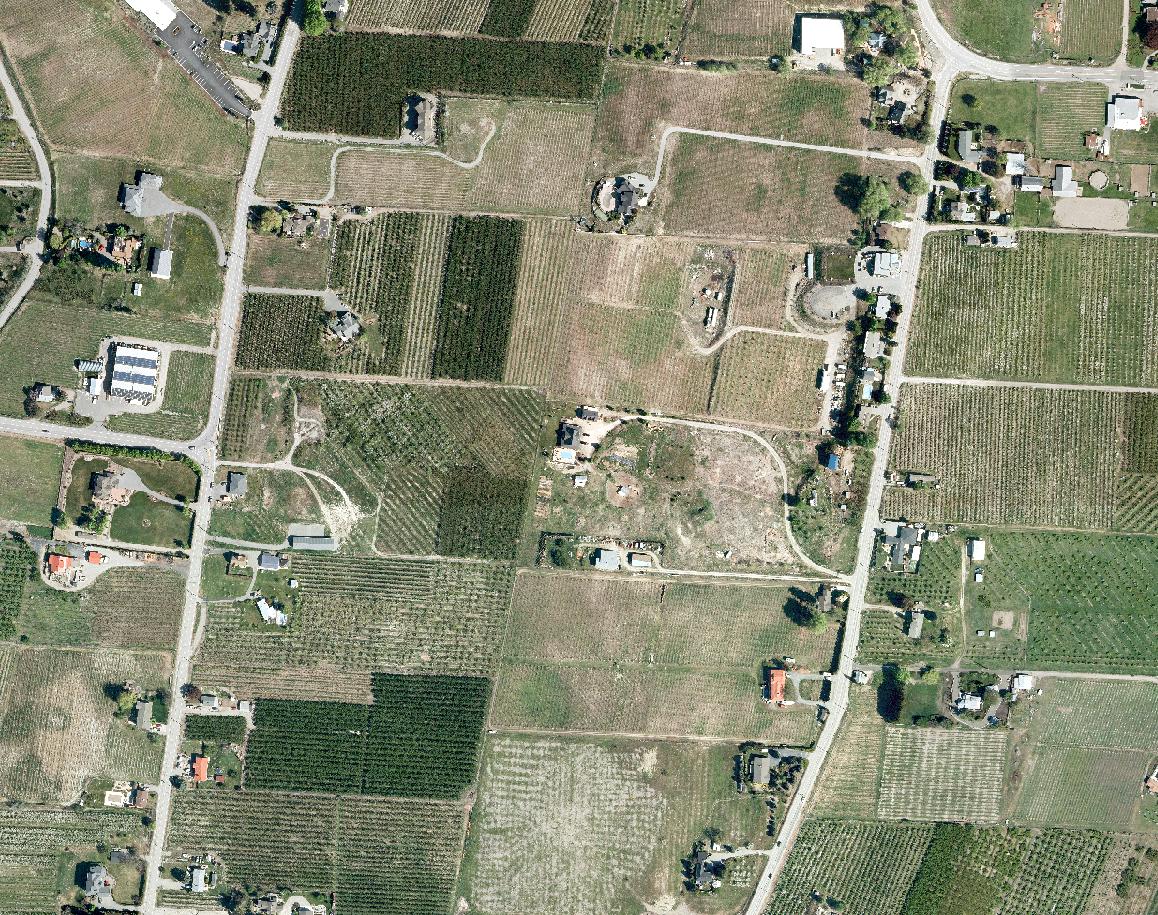






44 City of Penticton | Urban Forest Management Plan (DRAFT - JUNE 2024) Agriculture High Density Residential Industrial Parks Low Density Residential Natural & Conservation Areas Commercial
Figure 25. Examples of tree canopy across different land uses.
Development also requires the upgrading and installation of new and expanded utilities, which can have the effect of removing existing trees where they conflict with excavations for accessing and installing new underground water mains, electrical conduits, and other services. No replacement policy is in place, which makes it difficult for the City to plant at the pace of removals. i n recent years, between one-half and three-quarters of City-owned trees removed have been replaced with new trees.
Despite the substantial challenges posed by development and growth in the urban landscape for trees, growth can help pay for improvements. Development presents an opportunity to improve on current tree canopy cover through supportive landscaping standards and public realm design, particularly in areas with a legacy of little tree cover. i ncreasing tax base, the potential for development contributions, and capital investments to retrofit tree-friendly design features in the public realm are all positive outcomes of a growing city where urban forestry is prioritized.

5.1.2 PROTECT i NG TREES AND SO i L
Penticton’s bylaws require permission to remove Cityowned trees as well as trees in environmentally sensitive development permit areas. Tree removal and replacement are not regulated on the remainder of the city’s land base that contains over half of the urban forest. Cities without comprehensive tree protection bylaws struggle to maintain their urban forest canopy, particularly as neighbourhoods densify24,25,26. The City’s list of heritage trees includes trees on private property, although the Municipal Properties Tree Bylaw does not offer these trees protection. Whether additional regulation of trees on private property is warranted is a political decision for the community to make.
On City property, staff have limited capacity to enforce current rules protecting trees. Another key issue for the City is that enforcement of tree protection regulations rely on multiple departments with no clear budget for implementation.
Heavy use by events and festivals in cherished City parks are having detrimental effects on the health of mature trees through soil compaction and inadvertent damage like hitting trees with vehicles or trailers. The City’s system for managing conflicts between trees and park users relies on good faith adherence to guidance and site rules by event participants and organizers. Natural forests in urban areas are sometimes damaged through unsanctioned camping, which can impact the structure and function of the native understorey and result in vandalism on or around trees.
45 City of Penticton | Urban Forest Management Plan (DRAFT - JUNE 2024)
Soil management is part of urban forest protection
Soils are the foundation of any urban forest. Soil needs to sustain a balance of air, water, and nutrients to support healthy tree and plant growth. This balance is unique to every soil profile, contributing to the diversity of ecosystems in a landscape.
Soils can be damaged through heavy use, disturbance, pollution, or other urban factors. Compaction occurs when heavy use or machinery compress the air pockets in the soil profile, which can suffocate tree roots and other soil organisms. Artificial drainage or impervious surface barriers can affect the flow of water through the environment, soaking some soils while leaving others dry. Engine oil, road salts, cleaning products, excessive fertilizer, and metal oxides can leach into the soil profile and impact the health of vegetation. Construction or excavation can disturb soil and sever tree and plant roots.
Protecting soils is part of protecting trees and setting up the urban forest for success. Trained arborists typically identify
the “protected root zone” around a tree within which soil should not be disturbed. This may be a radius 10 to 18 times the tree diameter! The protected root zone can be identified on landscape or construction plans to allow appropriate review and monitoring. Connected to this is the “minimum soil volume”, which recognizes available soil for root extension is a limiting factor for urban trees. Trees should be planted in environments that will provide for their long-term needs. 30m3 soil volume is the minimum recommended soil volume for large trees capable of growing to 15 m in height or more, while smaller trees may be supported with 0.3 to 0.6 m3 per square metre of canopy spread.
Preventive maintenance is the best approach for soil management. Once volumes are designed they can be difficult to increase. Likewise, once soil damage has occurred, repairing it is challenging. Time is often the key ingredient in restoring soil structure, working in concert with physical aeration, amendments like mulch or biochar, irrigation, or technologies to extend soil volume like soil cells.
5.1.3 CL i MATE CHANGE, FOREST HEALTH, AND i NVAS i VE SPEC i ES
These issues go hand-in-hand, because increasingly forest health will be driven by climate factors. Researchers at UBC have proposed that Penticton’s hotter, drier climate will create a “novel” biogeoclimatic ecosystem classification, shared with lower elevation sites in the central and south Okanagan27. This means that our existing knowledge of natural forest ecosystems may no longer be relevant, and we may see a shift towards new ecological communities. Others have pointed out that with climate drying, places that are currently ponderosa pine forest may transition to grassland, assisted by pathbreaking wildfires28. These threats mean that careful decisions will be needed about when and where natural restoration to a forest condition is advisable, just as they increase the value and need for urban tree canopy cover which can be more easily irrigated. Disruptive events in an ecosystem are often moments where invasive species can rapidly colonize sites, changing the long-term ecological community.
At the same time, climate will drive the distribution and success of common forest diseases and pests as well as support new damage agents to establish in Penticton. Biodiversity increases from the poles to the equator, and as Penticton’s winter climate reduces in severity, the region will become more hospitable to a wider variety of insects and agents of disease. The effect of aridity may help contain the
spread of some pathogens, especially some fungal diseases like needle blights whose spread are disadvantaged by dry conditions. Other diseases, such as sooty bark disease of maples, have been observed to do well following hot summers29. To the extent that increased drought causes tree stress, it could have a much more significant negative effect by promoting the spread of endemic decay pathogens and bark beetles that are already present in the South Okanagan30. As warming progresses, the continued risk of freezing events can add risk to the trial of less cold-hardy species or native tree seed stock to improve urban forest diversity. These impacts are as likely to affect urban trees, agricultural trees, and natural forests.
Climate change may benefit invasive species that can outcompete native biodiversity and monopolize the resources in the environment. Climate warming allows successful range expansion, while freak weather events encourage disturbance and damage to ecosystems that open light and resources for these species to gain a toehold in new places. i nvasive species include noxious weeds, tree species, and pests such as fungi and insects that lack natural controls in their new surroundings. Some species were intentionally introduced for economic or cultural reasons, while others arrived accidentally. i nvasive species have adverse effects on the urban forest by reducing
46 City of Penticton | Urban Forest Management Plan (DRAFT - JUNE 2024)
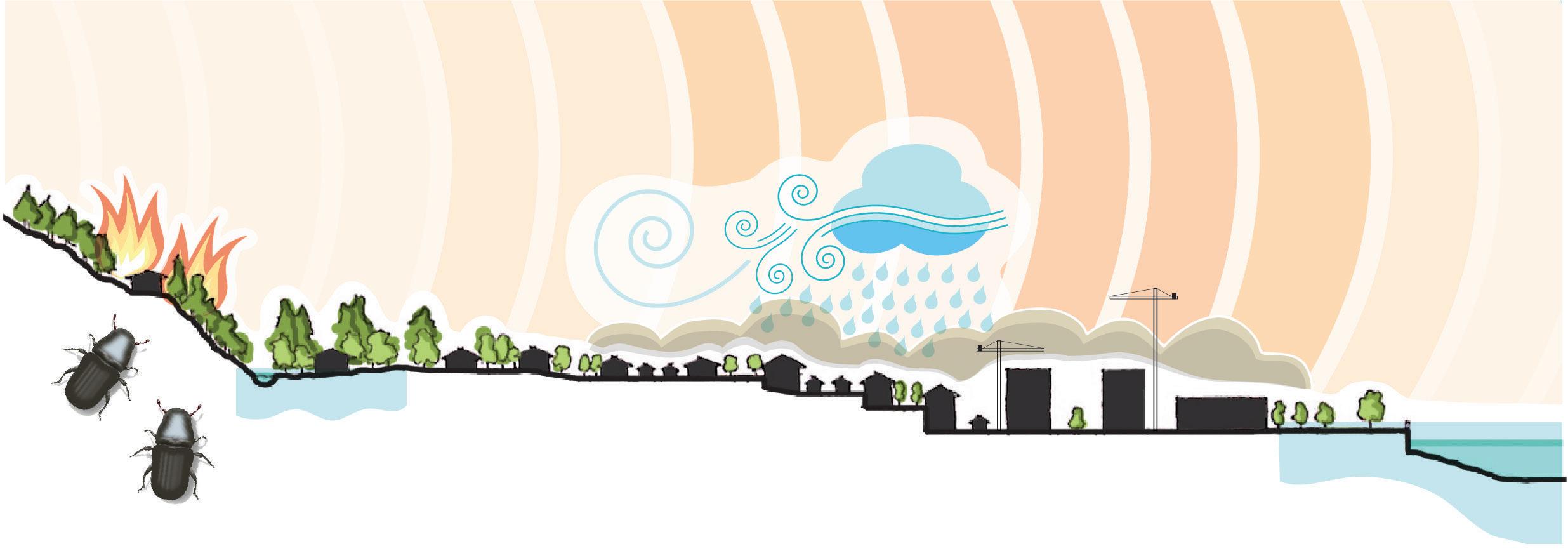
biodiversity and directly attacking trees, leading to a decline in ecosystem services. Ongoing monitoring and detection efforts can help prevent and control their impacts, while public participation in stewardship programs plays a crucial role in identification and eradication. The City has very little capacity for monitoring and response to forest health issues, relying on ad hoc observations by staff during other work
and contractors to provide advanced plant health care when warranted. i ncreasing the level of service for forest health or invasive species monitoring and control could overwhelm the department’s resources given the scale of existing challenges.
Research summary: Tree cover conserves water in a semi-arid climate
A shift to less snowpack and more rainfall, coupled with lower summer precipitation, means Penticton’s water supply will be under greater pressure by the middle of the century. 24% of domestic water use in the Okanagan is used in outdoor landscaping – a figure the City is trying to reduce through its water conservation programs.
The urban forest can help conserve water by reducing this demand. Researchers in Colorado examined city-wide water demand in Fort Collins, a mid-sized city of 170,000 people with a semi-arid climate33. The research revealed that tree cover was associated with lower water consumption. This result challenges conventional wisdom that trees elevate water demand in semi-arid climates because they are large and often require watering. i nstead, the study suggests watering trees helps reduce overall water demand, potentially because the shading and cooling benefits of trees prevent water used in landscaping from rapidly evapotranspiring through grass and other plants.
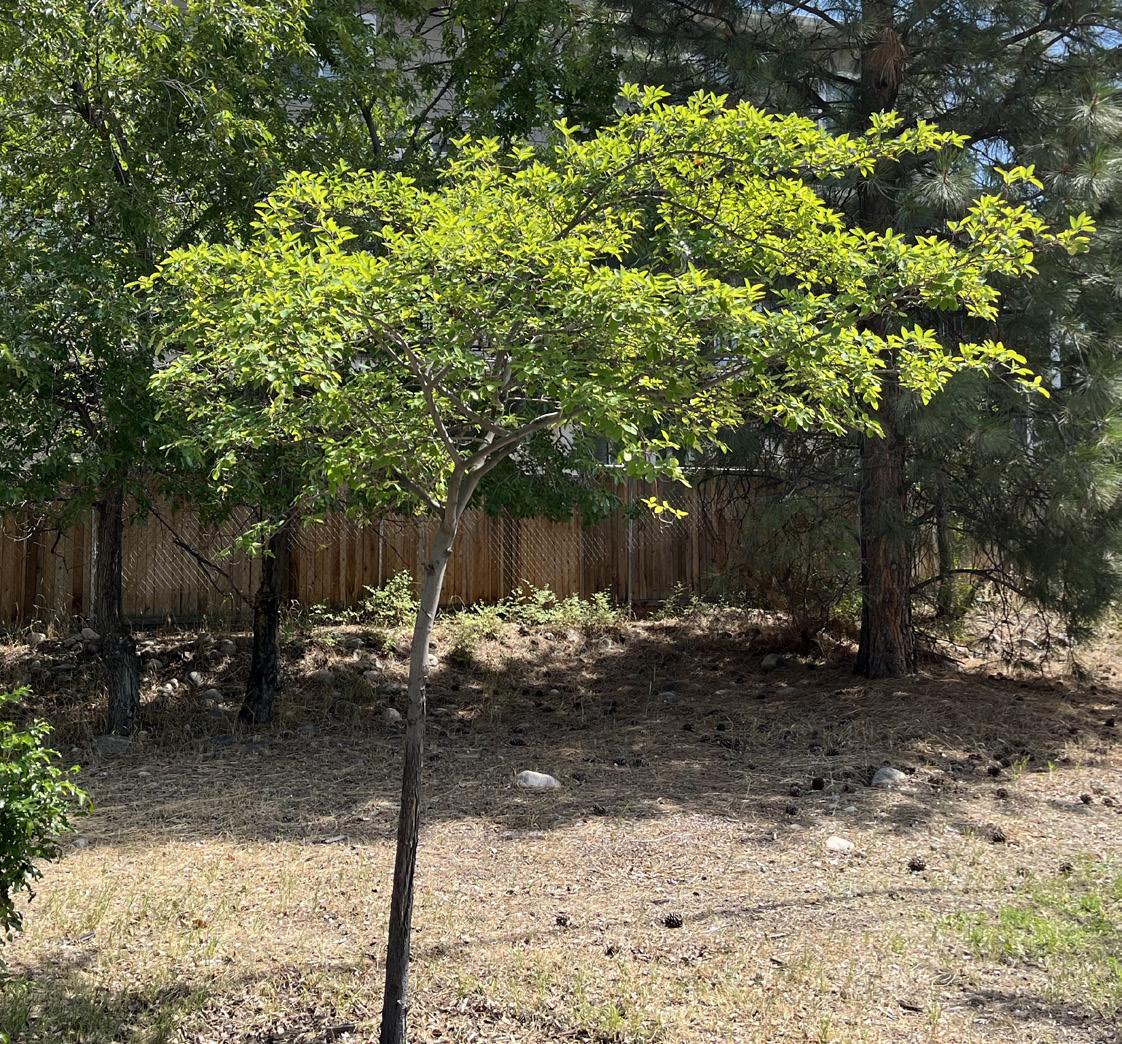
47 City of Penticton | Urban Forest Management Plan (DRAFT - JUNE 2024)
THREATS TO URBAN TREES
Agricultural pests
Penticton’s agriculture industry and urban forest overlap, particularly when it comes to pests impacting fruit trees. Damage agents that can affect both orchards and the urban forest include fireblight canker, black knot disease of cherry, wilting diseases, and introduced pests like spotted lanternfly and brown marmorated stink bug.
Forest health
Climate change or other environmental factors can benefit insect populations, turning endemic species into epidemic pests, like the mountain pine beetle. Bark beetles of pine, Douglas-fir, elm (potentially carrying Dutch Elm Disease) and maple pose threats to the city’s trees. Leaf mining insects, tent caterpillars, and Spongy Moth may also cause widespread tree damage. Some tree diseases with expanding range in the Pacific Northwest, like Sooty Bark Disease of maple, have impacts on human respiratory health. Urban deer can destroy young saplings.
Invasive species
i ntroduced species with a competitive edge can disrupt local ecosystems. Both non-native and native urban trees may be vulnerable. Pests often target specific species or types of trees. Penticton’s urban forest is particularly at risk from pests affecting maple, pine, honeylocust, ash, and elm trees, each of which constitute 5% or more of the City’s current tree inventory. Emerald ash borer, which devastates populations of North American ash (Fraxinus spp.) has recently been found in Vancouver, making introduction in the Okanagan more likely.
Urban conditions
Trees in urban areas face more extreme environmental conditions driven by the impacts of hardscaping. Hard surfaces absorb heat and raise ambient temperatures through the urban heat island effect, increasing water consumption by trees. Hard surfaces also collect, channel, and accelerate runoff from heavy rains, which can divert water away from trees and contribute to erosion or localized flooding. Building and roadway foundations compact the soil, alter the natural slope of the land, and create impermeable barriers to groundwater flow, fragmenting urban forest soils into small, isolated patches. These patches can become too dry in summer, too wet after rains, and too small to support beneficial biodiversity like fungi and soil animals, making it harder for trees to withstand increasing climate change impacts.
Vandalism and accidents
Trees are damaged by people intentionally, such as unauthorized trimming for views, or accidentally from vehicle impacts, soil compaction in the root zone, and littering.
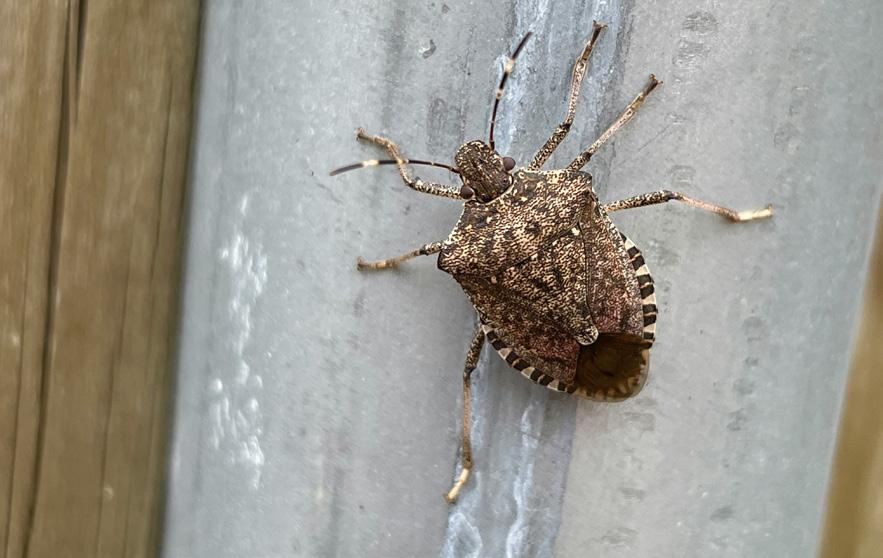


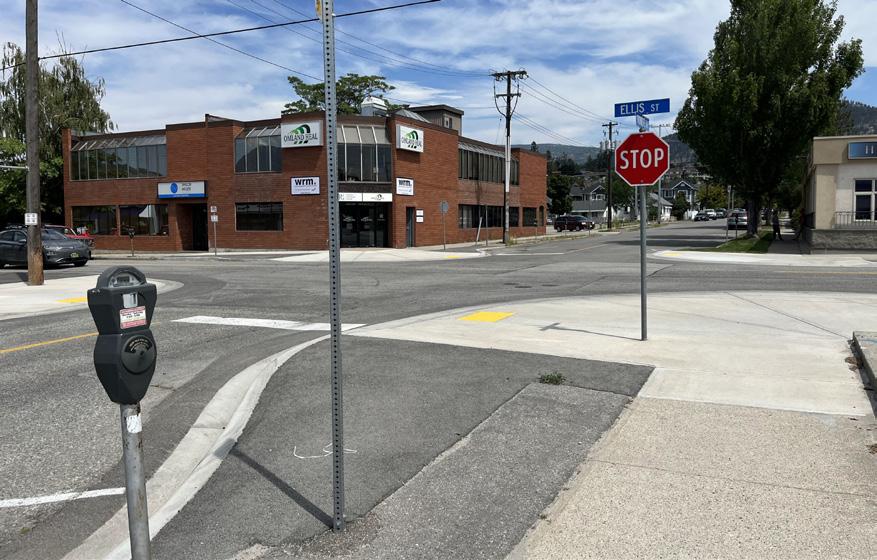

48 City of Penticton | Urban Forest Management Plan
URBAN FOREST OUTLAWS: PENTICTON’S INVASIVE TREES
Penticton’s urban forest contains several types of trees that can outcompete native plants. Many of these species were originally brought to the City to serve as shade or erosion control. Their ability to rapidly reproduce means that they have escaped their original purpose and are now found in unwanted places like natural forests and road rights-of-way. Managing invasive tree species is a significant burden on the City’s urban forest program.
Tree-of-heaven, Ailanthus altissima
Problem: This large, fast-growing tree produces copious winged seeds and can sucker from roots and stumps. i t has a high tolerance for pollution in air and soil. i t produces a chemical called ailanthone that enters the soil and is toxic to many other trees. Tree-of-heaven is the favourite food of the invasive spotted lanternfly, an important pest of crop and fruit trees, and can act as a breeding ground from which the insects spread elsewhere in the urban forest and agricultural areas.
Control: Mechanical removal often fails because of incomplete root removal, which allows sprouting. Systemic herbicide injection to kill the tree and root system may require multiple rounds for successful eradication
Siberian elm, Ulmus pumila
Problem: High seed production and germination rates make this tree an efficient colonizer of disturbed riparian areas and undeveloped property margins. This tree was introduced as an agricultural windbreak due to its ability to tolerate dry conditions and poor soils. i t can quickly shade out native understorey species and monopolize available soil moisture. i t has weak wood and is susceptible to ice and storm damage.
Control: Small seedlings can be pulled easily from wetted soil. Girdling of mature trees can be an effective control treatment, though requires care to reduce potential sprouting response. Pairing mechanical treatment with herbicide application to leaves, stumps, or girdles can be highly effective. Prescribed fire is a potential method of cultural control.
Russian olive, Elaeagnus angustifolia
Problem: Birds and wildlife help spread the seeds of this tree, allowing it to rapidly colonize new areas. Originally planted as an agricultural windbreak and for erosion control, this tree is highly effective at spreading into open grassland habitats. i t suckers from an extensive shallow root system when top-killed.
Control: Physical removal must usually follow herbicide application to cut stumps, stem injection, or basal bark application.
Black locust, Robinia pseudoacacia
Problem: With toxic seeds and a thick seedcoat, this tree’s seeds are avoided by animals and remain viable in the soil for many years. Once favourable conditions allow a tree to establish, it can sprout from the root system leading to the formation of dense colonies. This tree was sometimes planted as a source of firewood and for fenceposts or early mining construction.
Control: Applications of herbicide are typically required to control mature tree colonies. Top killing methods are ineffective without herbicide application to address root suckering.




49 City of Penticton | Urban Forest Management Plan
Tree-of-heaven, Ailanthus altissima
Siberian elm, Ulmus pumila
Russian olive, Elaeagnus angustifolia
Black locust, Robinia pseudoacacia
5.1.4 W i LDF i RE
Wildfire is the most common natural disturbance in Penticton’s forests. The landscape where the City now sits evolved in relation to frequent low-intensity fires. Fire suppression, poor forest health, and climate change are combining to increase the risk of more severe fire behavior, and population growth in the region means more people are at risk. Recognizing these risks the City has prepared a Community Wildfire Resiliency Plan to promote wildfire awareness and prevention tactics. Trees and vegetation act as the fuel for wildfires, which can sometimes put urban forestry in conflict with wildfire prevention. Balancing these priorities is important in an area called the Wildland-Urban i nterface, where natural vegetation meets the built-up areas where most people live and work.
Crucially, only severe fire should be considered a threat to the urban forest. The historic regime of low-intensity fires supported the health and longevity of mature trees by reducing competition and acting to reduce the spread of
decay insects and fungi. Prescribed fire could play this role again, and has been tested as a management technique in cities around North America, including such urban locations as High Park in inner-city Toronto. Short of burning, fuel management in the understorey of natural forests where wildfire has been suppressed can approximate some of the benefits of reintroduced prescribed fire, with relatively minor impacts on tree canopy where tree removal focuses on small trees.
Species selection can promote non-resinous deciduous trees for landscaping in interface areas. FireSmart BC prepared a landscaping guide with several plant recommendations for the area around homes and buildings in the interface. i rrigation can also play a role in maintaining a fire resilient urban forest at the edges of the community, though it may not be available during periods of extreme fire danger because of domestic watering restrictions.
Prescribed fire as a restoration and risk management tool
i n the middle of inner-city Toronto, within walking distance of the Bloor Street subway, prescribed fire is helping to bring back rare black oak woodlands and savannahs. The City of Toronto has led the restoration effort since 2000, with almost annual prescribed burns occurring in the city park’s natural areas. The program is built around defined management units that reflect forest stand boundaries – either ecological transitions or hard barriers to fire spread like roads, pathways and infrastructure. i nitiated with a goal to enhance native species and control exotic understorey plants, annual monitoring has shown significant decline of invasive plant species and a resurgence of native ecosystem components like dryland blueberry, woodland sunflower, and goldenrod.
Locally, members of the Okanagan Nation Alliance have significant experience and traditional ecological knowledge to draw on for prescribed burns. Successful prescribed burns have been carried out in SnPink’tn traditional territory at Garnet Valley to restore habitat value and reduce wildfire risk.
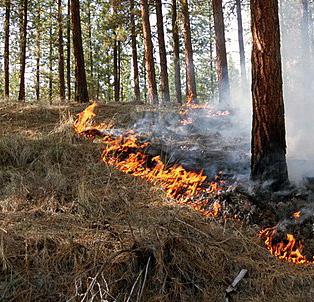
50 City of Penticton | Urban Forest Management Plan (DRAFT - JUNE 2024)
FIRESMART AND URBAN FORESTRY
Penticton’s FireSmart program helps prevent fire from crossing between wildland fuels (vegetation) and the built environment. The Okanagan is a fire-influenced landscape with wildfire being a frequent event in most natural forests historically. FireSmart programming acknowledges this reality and seeks to build a more resilient community through changes to landscaping and construction materials in higher-risk areas.
Expanding the urban forest may seem at odds with FireSmart vegetation management. Context is key for resolving tensions between policy priorities. i n high-risk areas for wildfire, “hardening” of buildings through use of non-combustible construction materials and vegetation management are important tools. The City is preparing a Wildfire Hazard Development Permit Area which can help guide landowners in higher-risk areas toward appropriate landscaping and construction on their properties. Landowners in lower-risk areas should feel confident that adding trees to their neighbourhood has a marginal impact on overall fire risk when those trees are low-flammability deciduous species.
Homeowners concerned about wildfire risk can research FireSmart BC’s landscaping guide, which describes species of trees, shrubs, groundcovers, and decorative grasses that are appropriate for different distances from the home in FireSmart’s “Priority Zone” system. i t is always a good idea to keep vegetation more than 1.5 metres away from your home, and prioritize low-flammability deciduous trees for use in landscaping close to buildings.
HOME IGNITION ZONE
51 City of Penticton | Urban Forest Management Plan
IMMEDIATE ZONE 0 m to 1.5 m INTERMEDIATE ZONE 1.5 m to 10 m EXTENDED ZONE 10 m to 30 m FireSmart, Intelli-feu and other associated Marks are trademarks of the Canadian Interagency Forest Fire Centre (CIFFC).
5.1.5 MANAGEMENT CAPAC i TY
Penticton’s urban forest management team consists of two full-time staff responsible for the care of trees and forests on all City-owned property. The current urban forestry budget is insufficient to plant replacement trees for each tree removed, or to proactively prune trees. Currently, Cityowned trees are believed to have a declining asset value because they are being removed at a greater rate than they are replaced. i n a small community, it can also be difficult to secure the training and expertise needed to carry out all parts of the urban forest program. For example, maintenance of City-owned trees around powerlines is often done by electrical workers without training in arboriculture, because the City lacks a certified utility arborist to respond to trees within the limits of approach.
Cities are increasingly including inventoried trees in their asset management systems. However, some challenges to the integration of natural assets in general include the difficulty of quantifying the value of trees and the limitations of traditional accounting frameworks for capturing natural assets that appreciate over time. There are also technical gaps in how tree assets are inventoried and tracked, with the City’s inventory lacking systematic reports on tree condition and species that could help assess value at a high level.
Asset management approaches would help to identify the life-cycle costs of maintaining urban forest assets. The City’s management budgets for trees and forests will likely need to grow over time as new trees are added to the inventory and climate change increases both demand for trees and the impacts on forest health. i mplementing a natural asset management framework would better inform service level and budget planning.
5.1.6 TREE EQU i TY
The urban forest canopy is not equitably distributed, leaving those most in need without access to its benefits. A map of the City’s urban forest canopy shows lower cover in lowerincome neighbourhoods and neighbourhoods where a high percentage of the population belongs to a visible minority. These areas also happen to be where much of the City’s future growth is planned. Building equity in the urban forest is a long-term task that will require sustained investment in new trees and planting sites in under-served areas. The City can continue tracking indicators of social vulnerability and use them to update its planting and program priorities as progress is made.

52 City of Penticton | Urban Forest Management Plan (DRAFT - JUNE 2024)
Figure 26. Tree Equity Scores (TES) show where residents face inequitable access to urban forest benefits
EVENT MANAGEMENT
Every year, the City’s parks host dozens of organized events that bring thousands of people to Penticton. While events are an integral part of the City’s tourism industry and civic identity, event operations and heavy visitation can take a toll on park trees. Cumulative stress of soil compaction and physical damage is visible on several trees in heavily used Gyro Park, for example.
City staff have designated areas in high-use parks for temporary tent and stage setup that reduce conflicts with trees. Much of the damage to root zones, however, is believed to be caused by vehicles entering the park and driving or parking in tree root zones. Loading/unloading is essential for event operations, but these activities are difficult to monitor because of their short duration and a lack of staff capacity during high-use times. The City mainly relies on good faith with event organizers and vendors to resolve tree issues, and conducts educational outreach during events to mitigate potentially damaging activities when observed.
i n the future, education and monitoring of trees in event sites can be enhanced with greater resources, which could allow the City to pursue greater enforcement of tree protection rules during events. Alternative strategies can also be considered, including the possibility of rotating the location of events to reduce cumulative effects, and investing more in soil aeration, soil amendments, and tree protection (like fencing or laydowns) in root zones identified by City arborists.

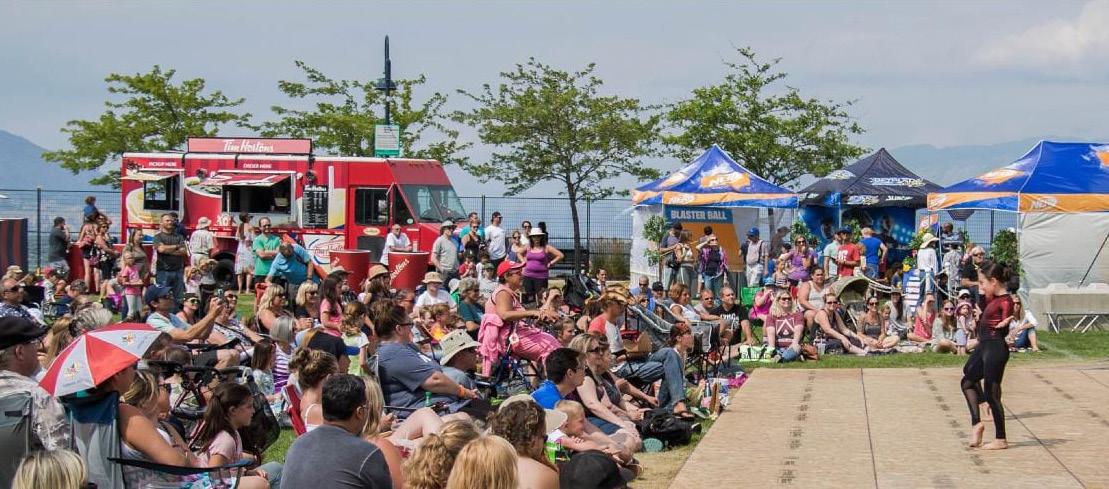
53 City of Penticton | Urban Forest Management Plan
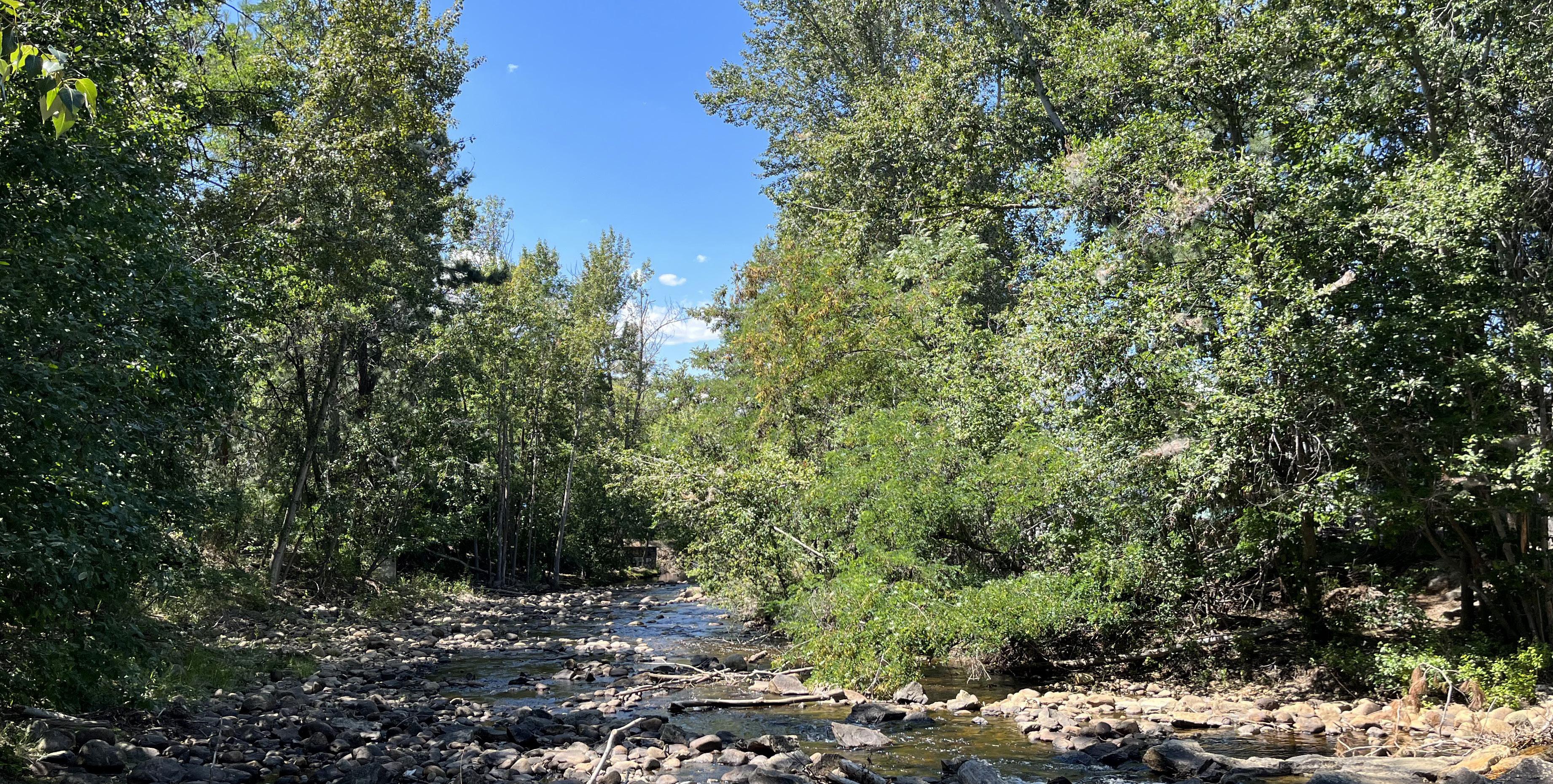
5.2 RECONCILIATION WITH INDIGENOUS PEOPLE
i n all its efforts, the City’s urban forest management must respect the value and rights placed by Syilx (Okanagan) people on the tmix w, all living things. Colonization has drastically the changed landscape. This has meant a converting native ecosystems into urban neighbourhoods and agricultural areas, leading to loss of access to cultural
resources and land-based practices. The City can work to repair relationships with i ndigenous people in the Okanagan and learn to integrate Syilx values and worldviews into its land management, including urban forestry. Partnership on urban forest projects and challenges are potential avenues for advancing these relationships.
54 City of Penticton | Urban Forest Management Plan (DRAFT - JUNE 2024)
LEARNING FROM OTHER PLACES: BIG IDEAS TO ADDRESS CHALLENGES
Preserving trees Communities around British Columbia and the world regulate trees on private property through bylaws and local ordinances. District of North Vancouver’s Tree Protection Bylaw focuses on the retention of large, mature trees as well as enhanced protection for native tree species. Township of Langley has placed a tree density requirement in its Subdivision and Development Servicing Bylaw, crediting greenfield developments that retain existing forest canopy cover.
Planting trees Planting can be a whole-community effort, supported by programs and bylaws. City of Kelowna has run its NeighbourWoods program for over a decade, providing low-cost trees to homeowners for installation in private yards and gardens.
Restoring ecosystems Restoring ecosystems unlocks biodiversity value and supports community liveability. City of Surrey’s Biodiversity Conservation Strategy maps the Green Infrastructure Network, 3,900 ha of interconnected natural areas, green corridors and open space that provide core habitats and connections between them, while supporting neighbourhood parks and natural areas provision. The Okanagan Collaborative Conservation Program has prepared a Biodiversity Conservation Strategy for the Okanagan Region, which found the much of the region’s highest conservation ranking natural areas within the South Okanagan – Similkameen.
Asset management York Region, ON, is working towards full accounting of trees and forests on corporate balance sheets. The Region is among the first communities in Canada to assess the compensatory service value of forests. Town of Gibsons is leading small communities in Canada with its natural asset management framework.
Making room Urban trees face most challenging environments in the urban forest, including limited soil volume, soil compaction, and poor drainage. The City of Campbell River integrates tree planting details that include structural soil breakouts and soil channels to connect boulevard planting pits with adjacent permeable soil on private property in new subdivisions. The City of Toronto has created standard drawings for tree planting solutions in hard boulevard surface areas, including suspended pavement systems. The City of North Vancouver’s Development Procedures Bylaw allows delegation to staff of minor development variance permits, which include reducing parking minimums to retain mature on-site trees and adequate soil volume.
Building community There are many ways to invite the participation of volunteers and build community through urban forestry. The Town of Oakville, ON, has recruited dedicated volunteers to conduct assessments of forest health for its street tree population, forming a key part of service delivery for this asset class. The District of Saanich partners with homeowners to identify new boulevard planting sites and provide care for young trees in streets through its Partnership Program.
Managing adaptively The City of Seattle is reporting annually on its Urban Forest Management Plan, monitored by a working group called the Core Team with representation from multiple City departments and select external agencies, supported by an independent Urban Forestry Commission with a role to advise government on implementation. Observations from annual progress reports are fed into operational and strategic planning.
55 City of Penticton | Urban Forest Management Plan
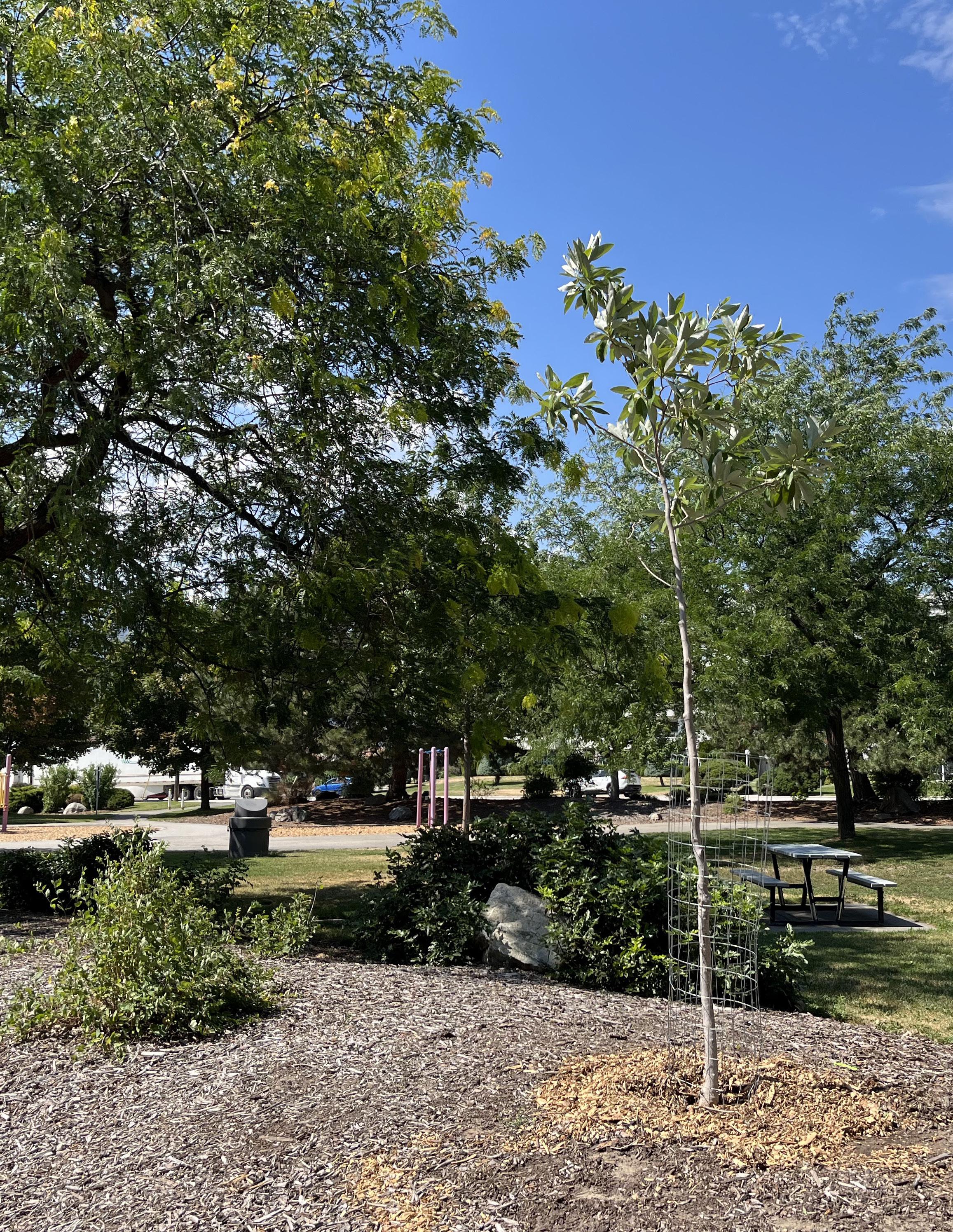
CHAPTER 6.
VISION FOR THE FUTURE
6.1 WHAT WE HEARD
Penticton’s Urban Forest Management Plan seeks to provide a community-supported vision of where management should take our urban forest over the next 20 years and beyond. The Vision is one part of the Plan’s framework for
urban forest management. The Vision leads the development of Goals and Principles, followed by Targets, Strategies, and Actions forming the remainder of the framework.
6.1.1 PHASES OF PUBL i C ENGAGEMENT
The UFMP involved two phases of public engagement. The initial phase took place between May and November 2023 with the goal of collecting the community’s input regarding a long-term strategic urban forestry vision and supporting goals for protection and management. The public was invited to provide input through the 2023 Citizen Survey, a mapping tool hosted on the Shape Your City project page, in-person information shared at neighbourhood events in September 2023, and an online open house held on October 4, 2023. Community advocates for the City’s urban forest were invited to participate in an online workshop held in June 2023. More than 2,250 people participated in the first phase. This includes 1069 voluntary survey respondents, 322 randomized survey respondents, and more than 860 visits from the project website.
The project team presented to Penticton i ndian Band leadership through the Major Projects Committee (the City’s consultative forum with PiB) in June and September 2023, to seek feedback and input on potential alignments with PiB community priorities. At the request of Penticton i ndian Band representatives, the project team also engaged directly with representatives of Sn’pink’tn Forestry LP on November 17, 2023.
Phase 2 of public engagement is currently underway and this draft report will be updated once community engagement is completed.
57 City of Penticton | Urban Forest Management Plan (DRAFT - JUNE 2024)
Background review Phase 1 Engagement Phase 2 Engagement Background review + Urban Forest Analysis UFMP Finalization UFMP Draft Report Data collection and canopy analysis April - November 2023 June 2024 July 2024 November 2023 - May 2024 March 2023 Public engagement and strategy development UFMP draft
Figure 27. Project timeline for the Urban Forest Management Plan.
6.1.2 URBAN FOREST BENEF i TS
When engagement participants think of the urban forest, they most value the environmental (pollution reduction) and climate adaptation (shade, cooling, carbon sequestration) ecosystem services it provides. People are potentially less familiar with the benefits trees provide to biodiversity or
human health and well-being. When prompted to prioritize their concern with factors challenging the urban forest, open house participants rated development and construction impacts as their most significant concern, followed by tree protection, tree planting rates and planting success.
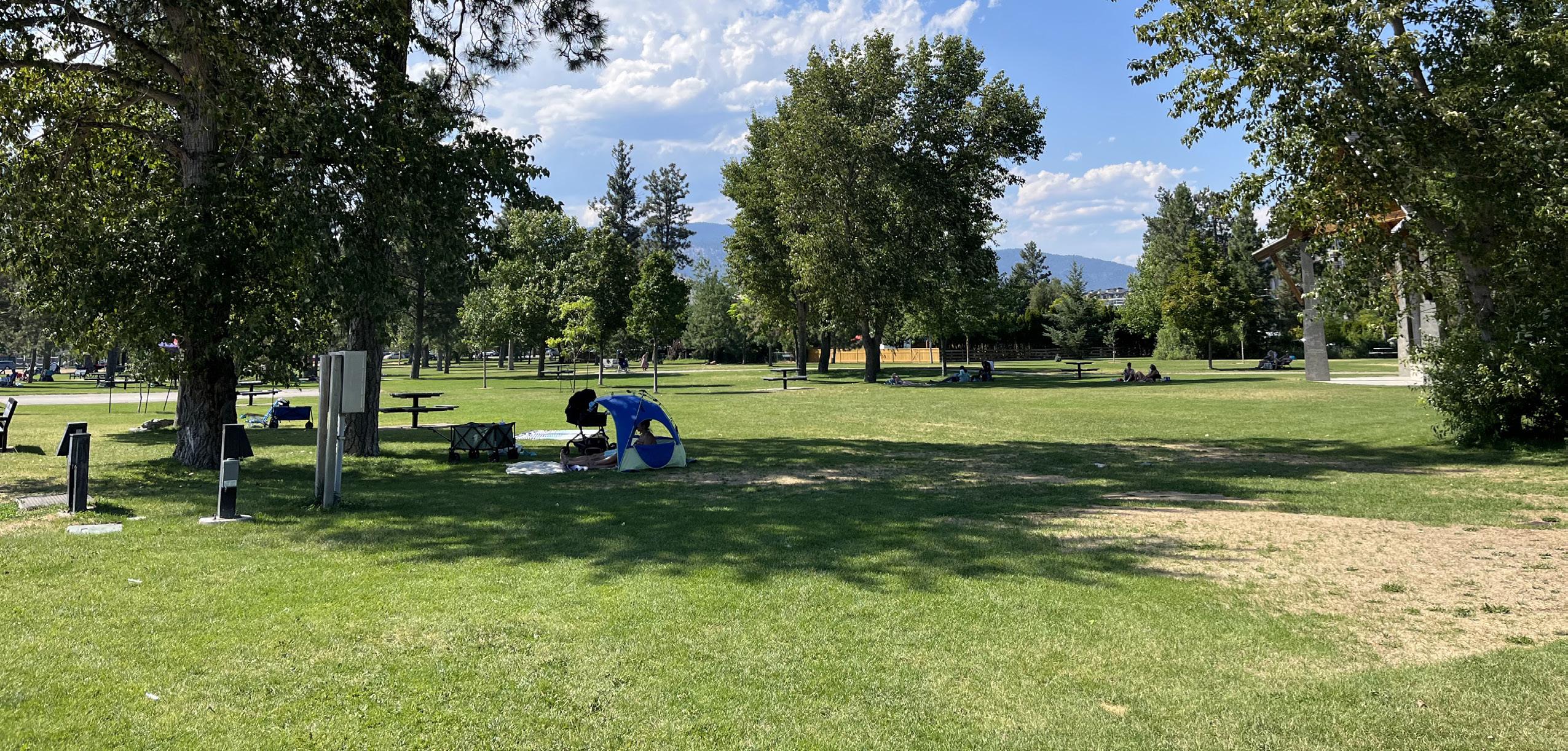
58 City of Penticton | Urban Forest Management Plan (DRAFT - JUNE 2024)
Air and water pollution removal
Habitat for animals, plants, and other life
Flood and storms bu er Human health and well-being
Climate change adaptation Intrinsic, intangible, and cultural values
Figure 28. Urban forest benefits that residents said they appreciate.
6.1.3 SPEC i AL PLACES AND PLACES NEED i NG HELP
Visitors to Shape Your City Penticton had the opportunity to contribute to a community map of “special” places in the urban forest and places that “need help”. Participants identified 420 locations in total, including 188 special places and 232 that need help. Special places in Penticton’s urban forest include the waterfront parks at Okanagan and Skaha Lakes, natural forests threatened by development in the northeast sector, natural areas around Penticton Creek, and older residential neighbourhoods with large mature
trees. Places needing help echoed these areas, reflecting recognition by participants that there is always potential for improvement. Overall, places needing help were much more likely to be urban in character than Penticton’s special places, with more representation of commercial and industrial areas, as well as downtown Penticton and adjacent residential areas with little tree canopy.

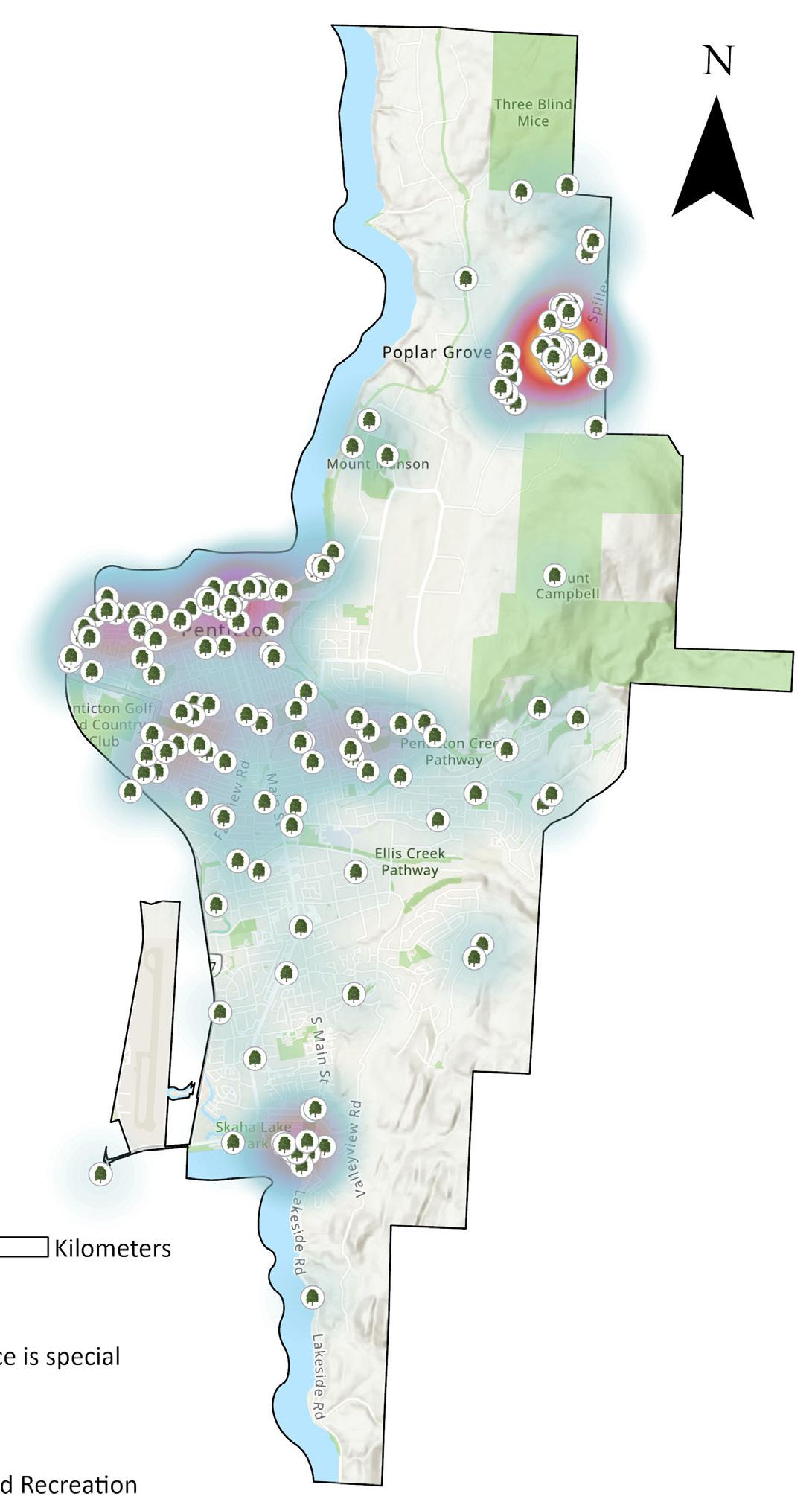


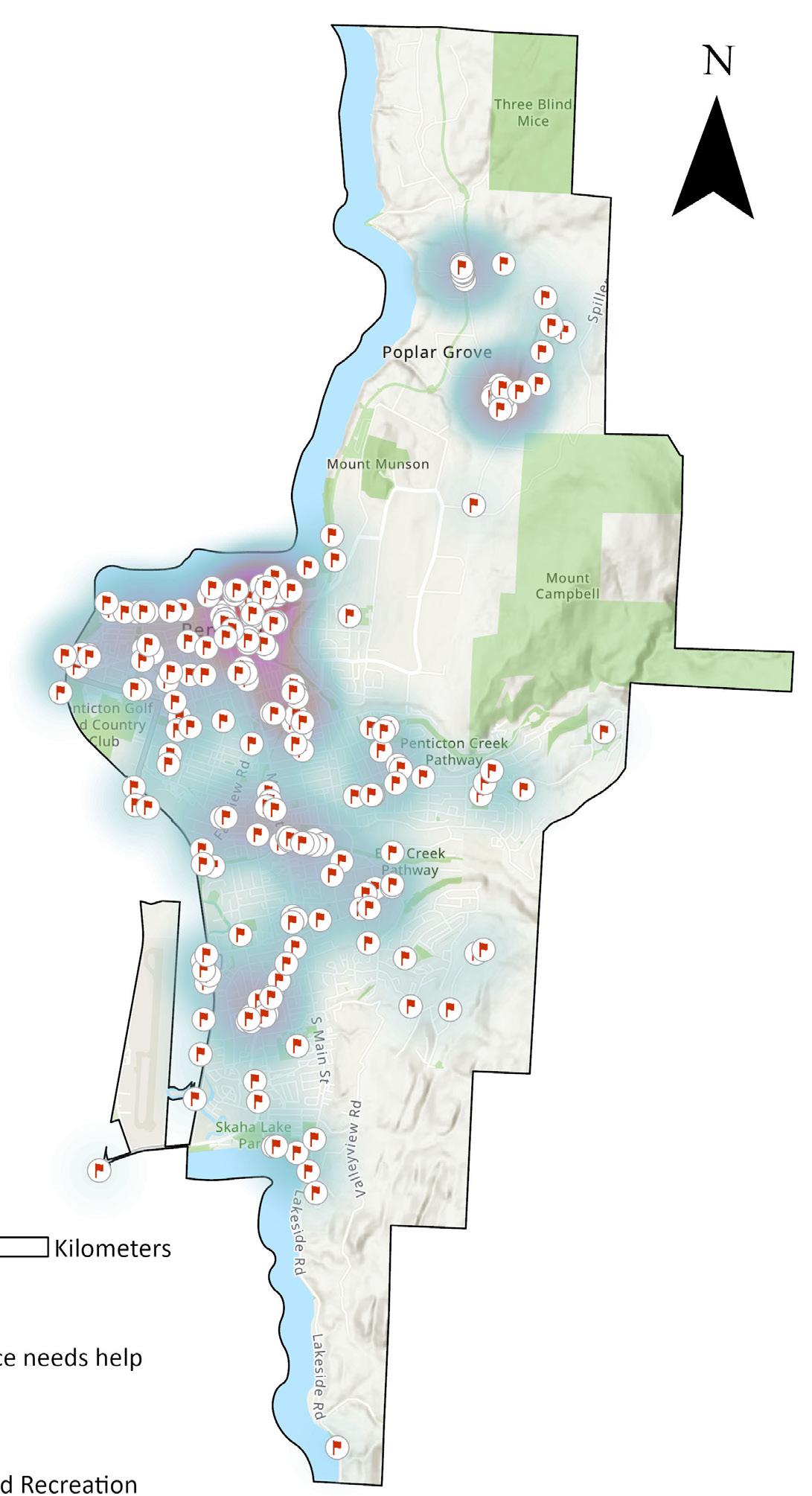
Figure 29. Results of the mapping tool on Shape Your City, showing places in the urban forest that respondents consider “special” and places that “need help”.
59 City of Penticton | Urban Forest Management Plan (DRAFT - JUNE 2024)
6.1.4 TREE PROTECT i ON AND PR i OR i T i Z i NG URBAN FORESTRY
Across all engagement opportunities, support for urban forest management and concern for trees was widespread. There is strong support in the community for elevating urban forest management as a civic priority and acting to arrest and reverse the loss of urban forest canopy. Just over 45% of Citizen Survey respondents rated the protection of “high-value” trees on private property as a high priority or essential, compared to only 23% who rate it as low or not a priority. Results were consistent across both the voluntary and random (intercept) samples used by the Citizen Survey. 80% of Citizen Survey respondents in the random sample assessed tree protection for high-value trees on private property to have at least “medium priority”.
Online open house participants unanimously recommended the City to pursue a higher (>17%) City-wide tree canopy over the next 20 years, even if that would be difficult or expensive to achieve. Similarly, when asking about their vision for Penticton’s urban forest, there was a consensus among participants for the need for more trees and more tree canopy, especially in urban areas like streets, urban parks, and residential neighbourhoods.
Question:
To what extent do you think the City should prioritize the protection of high-value trees (i.e. mature and non-invasive species) on private property?
Responses:
60 City of Penticton | Urban Forest Management Plan (DRAFT - JUNE 2024)
Voluntary Sample n=833 Random Sample n=254 9.1% 10.6% 33.1% 28.3% 18.9% 11.3% 11.8% 30.6% 28.7% 17.6%
Figure 30. Citizen Survey respondents’ views on tree protection on private property.
11 9
Essential High priority Medium priority Low priority Not a priority
IN THEIR OWN WORDS: ENGAGEMENT PARTICIPANTS ON PENTICTON’S URBAN FOREST
Respondents to the Citizen Survey (voluntary and random samples) contributed a diversity of ideas about how Penticton’s urban forest should be managed. While many respondents were concerned by the potential cost and regulatory changes needed to support urban forestry, many also highlighted the value of urban forest benefits in the City and desired additional tree planting in beaches, parks, neighbourhoods, and streets. The selection of comments below have been lightly edited for clarity:
>> You need a strategic plan to make tree planning effective (e.g. right tree species in right areas).
>> It’s hot here and [trees] serve many purposes beyond providing shade. They keep our soil strong and prevent erosion of heavy rainwater and flooding.
>> Every tree planted needs to be maintained which costs the City money!
>> Trees must be planted where they can be maintained. If residents are forced to water and care for them, many will go neglected or vandalized.
>> Shade for Skaha beach would be lovely. The weeping willows are missed.
>> If [urban forestry] is a priority what services would the City be willing to reduce/eliminate to fund it?
>> There should be more courtyards and greenspaces inside each development.
>> Focus on not removing trees from natural areas; leave them in their natural state and replace trees where development has destroyed habitat.
>> Trees are a tough one; it will be years before the true benefit is realized. Plant as many as possible: we will never have too many trees!
61 City of Penticton | Urban Forest Management Plan
6.2 VISION STATEMENT
The Vision is intended to be a community-supported statement that represents the overall direction for the UFMP and Penticton’s urban forest management. The Vision is informed by input from the community, city staff, and partners while grounded in the current condition of the urban forest and the City’s urban forest management program. The Urban Forest Management Plan seeks to bring the City’s urban forest toward the proposed Vision over the next 20 years.
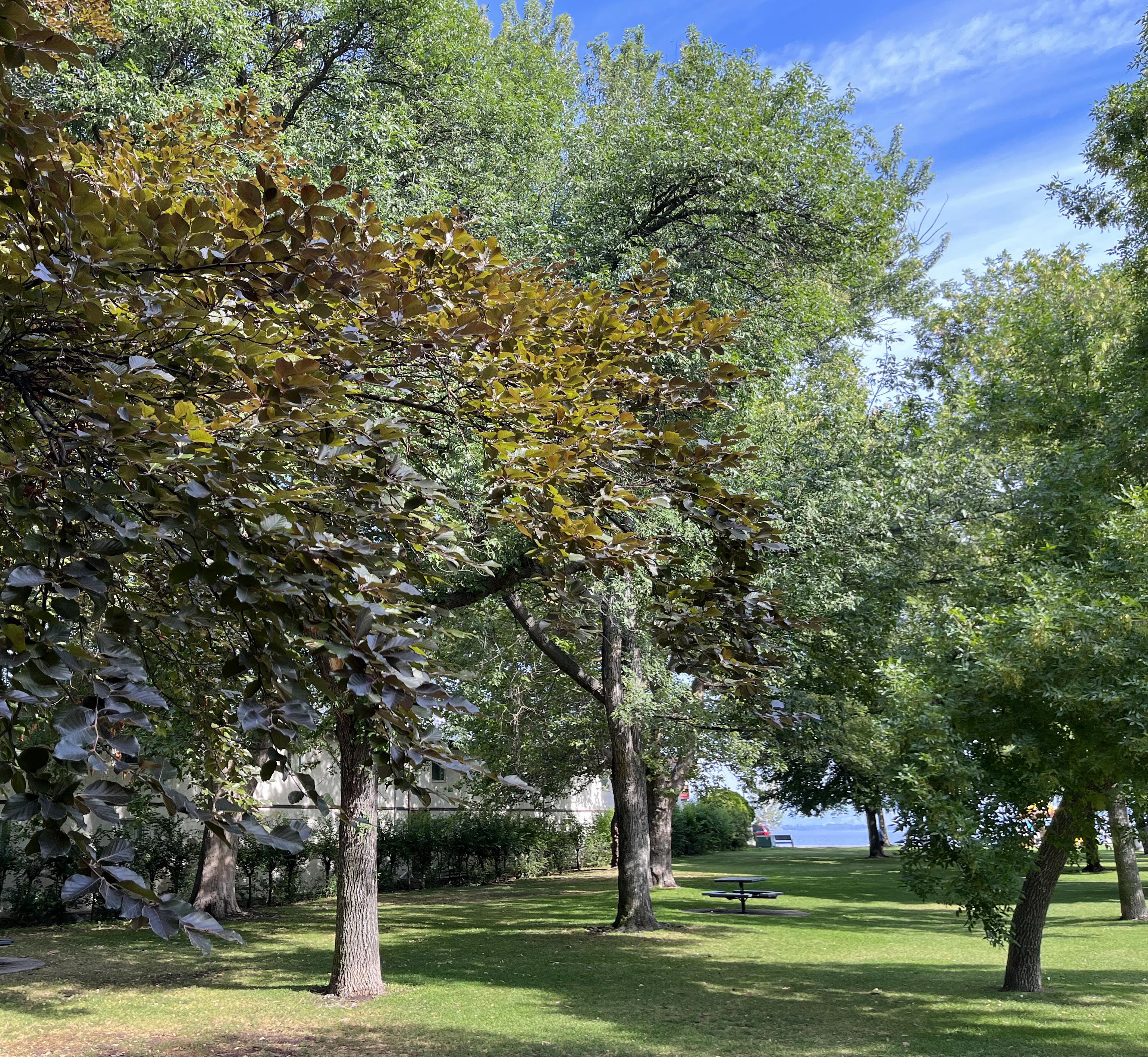
Our urban forest vision is to keep our community healthy, beautiful, and green. Our urban forest is growing because of the care we give and the value we place on it. Our actions today are building a resilient future for the urban forest that we can be proud of across cultures and generations.
62 City of Penticton | Urban Forest Management Plan (DRAFT - JUNE 2024)
6.3 SCENARIO PLANNING
6.3.1 SETT i NG A CANOPY COVER TARGET
Tree canopy cover is a common metric that municipalities use to understand the extent of their urban forest and track canopy changes over time. Many municipalities establish a specific target to attain their desired level of canopy cover within a defined timeframe. The canopy target connects the vision to a measurable outcome and helps to drive the implementation of Urban Forest Management Plans.
Approaches to setting canopy targets have evolved over the past two decades, reflecting a growing understanding of the complexities of urban forest management and consideration of other uncertain factors that will have an impact on canopy, such as climate change and population changes. To set a feasible and reasonable canopy target, best practices now suggest that municipalities consider their current canopy cover, development patterns and density, population changes, land use, and tree regulations. To set Penticton’s canopy cover target, the project team:
• Measured current canopy cover across all land uses
• identified where and how much development and other land use changes would be expected to occur and estimated how these changes would impact canopy
• Forecasted canopy cover city-wide as well as across all OCP land use designations based on the following factors:
• Tree planting program
• Tree retention efforts enabled by tree regulations (existing and recommended)
• Anticipated growth of existing trees
• Anticipated loss due to development and other factors (e.g. natural causes)
Four scenarios were developed to show how canopy cover could change in Penticton over the next 20 years:
Scenario 1 Status Quo | Canopy cover decreases to 16% by 2045
This scenario assumes no changes in development policy, resulting in a decreasing canopy, particularly in urban residential areas. On public property, forest health issues and wildfires are estimated to cause approximately 10 hectares of canopy loss in the next 20 years. Combined canopy loss in the City is expected to reach 34 ha over 20 years, of which only 12 ha is expected to be replaced at current planting rates. Canopy cover in urban areas could decline from 12% to 11% by 2045.
Scenario 2 No Net Loss | Canopy cover remains at 17% by 2045
i n this scenario, the City introduces a new City Tree Policy and other policy updates applying to public property. These changes will reduce tree loss on public property and return the City to no less than 1:1 replacement of removed trees on City property within urban areas, reducing loss on public property by 2 ha. i n addition to replacement planting, a total of 325 trees per year will need to be planted to offset losses from private property. 125 of these new trees will need to be caliper-sized planting stock intended for urban parks and streetscapes, while 200 can be smaller seedlings in natural restoration areas. Additionally, the City shifts toward proactive street and park tree maintenance, with a small amount of new resources for natural forests management. Canopy cover in urban areas is held at 12% by 2045.
Scenario 3 Urban Forest Expansion | Canopy cover increases to 18% by 2045
Scenario 3 builds on improved urban forest management for public property by working directly with landowners to preserve or increase tree canopy on private property. Scenario 3 presumes that a new Tree Bylaw is developed to increase tree protection throughout the City, with provisions for tree replacement applying on public and private property. The City introduces new planting programs through a public tree sale and community partnerships, aiming to install 275 trees per year on non-City property, while new programs for planting more trees in streets and parks deliver 175 caliper-sized trees and 300 smaller seedlings in natural restoration areas. Canopy cover in urban areas is increased from 12% to 13% by 2045.
63 City of Penticton | Urban Forest Management Plan (DRAFT - JUNE 2024)
Scenario 4 Green Future | Canopy cover increases to 18% by 2045, with 25% canopy cover in urban areas by 2085
Additional changes to tree planting requirements, protection, and urban design could further lift the urban forest towards an aspirational target of 25% in urban areas toward the end of the century. This would be accomplished by fully incorporating trees into land use and development regulations with strong tree protections in place throughout the City. Setting urban forest targets by zoning or land use, backed up by landscaping requirements in City bylaws, would be essential to achieving this level of canopy cover on top of new programs to improve planting rates on public property. Planting rates on public property of caliper-sized trees equals 175 trees per year while additional focus on natural restoration increases the rate to 400 trees planted per year in natural areas.
SCENARIO 1
SCENARIO 2 SCENARIO 3 SCENARIO 4
~34 ha ~12 ha canopy removed from single and multi-family residential, agriculture, and natural forests due to development, forest health issues and wild re
~trees removed faster than replacement
canopy replaced with new tree planting primarily in
~at least 1:1 tree replacement on City property
~125 new trees per year in urban parks and streets
~200 new trees per year in restoration areas
~enhanced tree protection on City property
~28 ha ~50 ha canopy removed from single and multi-family residential, agriculture, and natural forests due to development, forest health issues and wild re
canopy replaced with gains from Scenario 2 along with bylaw-supported tree retention on private property and additional resources for public planting
~at least 1:1 tree replacement and tree protection City-wide ~275 new trees per year planted on private property
~175 new trees per year in urban parks and streets
~300 new trees per year in restoration areas
~28 ha ~58 ha canopy removed from single and multi-family residential, agriculture, and natural forests due to development, forest health issues and wild re
canopy replaced with gains from Scenario 3 along with land-use based tree “targets” set during development and additional resources for public planting
25% in urban areas (2085)
~at least 1:1 tree replacement and tree protection City-wide ~ tree density targets for new development by land use ~175 new trees per year in urban parks and streets ~400 new trees per year in restoration areas
Figure 31. Scenario summary used to inform target and action plan setting for the Urban Forest Management Plan.
Recommendation:
Based on the urban forest vision, community and partner feedback, and the canopy scenario/’modelling outcomes, the UFMP recommends a target of 18% city-wide canopy cover by 2045 and a long-term target of 25% canopy cover within urban land uses, consistent with Scenario 4: Green Future. While the long-term target is considered aspirational and is unlikely to be fully realized within the planning horizon, the 18% target is achievable within the twenty year plan horizon based on the strategies and actions outlined in the UFMP.
64 City of Penticton | Urban Forest Management Plan (DRAFT - JUNE 2024)
13% in urban areas (2045) 12% in urban areas (2045) 11% in urban areas (2045)
16% (2045) 17% (2045) 18% (2045) 18% (2045)
status quo -1% decline
canopy replaced no net loss 0% small increase
~34
canopy
re
parks
streets expansion +1% increase
~32 ha
ha
removed from single and multi-family residential, agriculture, and natural forests due to development, forest health issues and wild
and
green future
+1% increase
PRINCIPLES FOR URBAN FOREST MANAGEMENT
Penticton’s urban forest management program should adhere to the following principles that summarize best management practices and respond to Penticton’s ecological and cultural context. Action Plan language in Chapter 7 has been developed with these principles in mind:
Prepare for climate change and mitigate impacts
Climate change is affecting the urban forest and will continue to do so. Shifting climate will increase the demand for urban forest management services like watering, pruning, and hazard tree removal. To prevent the worst impacts, the City should refocus on preventive maintenance and setting trees up for success with high quality planting sites.
Promote equity and diversity
Research shows that the effects of low greenness in cities are disproportionately felt by people who may be socially vulnerable, such as seniors, children, people with low income, or i ndigenous people and ethnic minorities. Penticton’s urban forest can become an expression of the community’s diversity and efforts to enhance neighbourhood canopy cover should take community needs into account.
Keep the right tree in the right place
Large, mature trees provide a relatively high share of the City’s urban forest benefits because of their welldeveloped canopy. Wherever possible, mature trees in healthy condition should be retained to reduce the need to compensate loss with new tree planting. Species’ habits and potential mature size should always be factored into decision-making to avoid future conflicts with infrastructure or land use.
Value the urban forest in decision-making processes
While it can be difficult to correctly value urban forest ecosystem services individually, there are several means of estimating tree value for consideration during the planning of developments and construction on public and private property. Adopting a method of accounting for tree value can support clear design instructions and help decision makers evaluate the opportunity costs of tree removal.
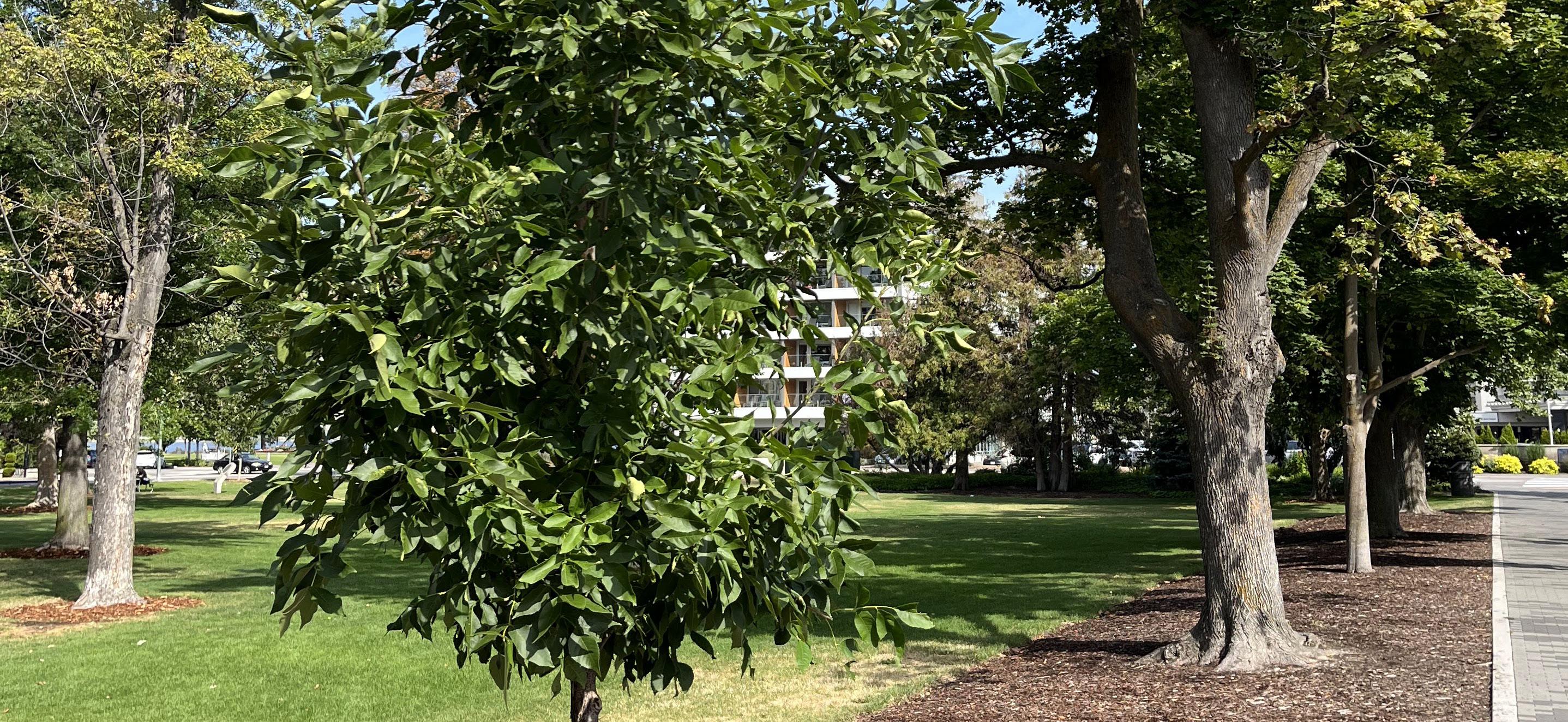
65 City of Penticton | Urban Forest Management Plan
1 2 3 4

Maintain trees as healthy, functioning natural assets
Although asset management is not the only perspective through which trees in the urban forest should be viewed, it can help staff define service levels for “classes” of urban forest assets that enable scheduling and budgeting to shift from reactive to proactive maintenance. i ncreasing preventive maintenance is an important component of securing ecosystem service delivery.
Monitor, learn and innovate as part of every-day management
The urban forest is constantly changing. While the Urban Forest Management Plan presents the best information available currently on trees and forests in Penticton, change will require updates to the plan on a cyclical basis. To support adaptive management, monitoring capacity is urgently needed to support better asset management and develop the City’s capacity to manage issues in natural forests.
Involve the community to build awareness and capacity
Some readers of the Urban Forest Management Plan may be hearing about how the City manages trees for the first time, while other readers will be more familiar and may have engaged in the preparation of the plan. Community awareness of urban forestry will need to be increased to support growing the urban forest in the City, which requires developing additional tree protections on private property. Community members also contribute valuable effort to the City’s current efforts to monitor the tree inventory and participate in tree planting, restoration, and advocacy activities.
Recognize Syilx worldview and promote respect for trees in the community
Penticton i ndian Band representatives have shared with the City that there is innate value in trees that comes from their status as our relations in tmix w. The City respects this perspective and acknowledges that the western framework for asset management can be at odds with it. There are opportunities to reflect Syilx land management principles and traditional ecological knowledge in urban forest management that will be explored through the parties’ continued relationship-building. A first step to acknowledging the value placed by i ndigenous Syilx people on the community’s urban forest is promoting their perspectives on an equal footing with western ones.
66 City of Penticton | Urban Forest Management Plan
5 6 7 8

CHAPTER 7. ACTION PLAN
7.1 GOALS AND STRATEGIES FOR PENTICTON’S URBAN FOREST
Goals are high-level descriptions of outcomes sought by the Urban Forest Management Plan. Four goals will guide the City’s work towards achieving the urban forest vision. Strategies are groups of interrelated actions designed to work towards a goal. 13 strategies are proposed by the Urban Forest Management Plan.
Goal 1: Plan, protect, and plant to expand the urban forest.
Strategy 1: Update bylaws, policies and plans to promote urban forest retention and expansion.
Strategy 2: Develop a new Tree Protection Bylaw to apply throughout the City
Strategy 3: Plant trees with a focus on equity
Strategy 4: Restore forested natural areas to connect habitats and promote biodiversity
Strategy 5: Enhance stock selection and adapt planting for the future climate.
Goal 2: Manage for tree health and longevity.
Strategy 6: Establish service levels for tree assets.
Strategy 7: Extend documentation of operational procedures to promote good asset management.
Strategy 8: Secure resources and build capacity needed to implement.
Goal 3: Enhance partnerships and public outreach to increase awareness and capacity for urban forest management.
Strategy 9: Align priorities within the organization to facilitate tree retention and service delivery.
Strategy 10: Explore partnerships with the community to enhance urban forest management and build awareness.
Strategy 11: Engage Syilx/Okanagan communities, Penticton i ndian Band, and urban i ndigenous peoples to share knowledge and invite collaboration.
Goal 4: Monitor progress and adapt management to changing circumstances.
Strategy 12: Monitor and report on change to promote adaptive management and increase transparency.
Strategy 13: Test new ideas and technologies that can help adapt the urban forest to an uncertain future.
68 City of Penticton | Urban Forest Management Plan (DRAFT - JUNE 2024)

7.2 IMPLEMENTATION TABLE
The implementation table provides action language for each Strategy and Goal, totalling 92 actions for consideration. The implementation table provides the following context for each action:
Pathway
100 The action is recommended for achieving Scenario 2 (no net loss)
100 The action is recommended for achieving Scenario 3 (expansion)
100 The action is recommended for achieving Scenario 4 (green future) (100) A modified target within the action applies to this scenario
Responsibility Parks The department(s) leading implementation for the action
Parks Key department(s) supporting implementation for the action
Cost ($) The action will reallocate existing staff time or involves cost recovery
$ The action will incur a one-time cost of <$10,000
$$ The action will incur a one-time cost of $10,000 to $50,000
$$$ The action will incur a one-time cost of $50,000 to $100,000
$$$$ The action will incur ongoing costs above current or a one-time cost exceeding $100,000
Priority A The action should be implemented within 3 years
B The action should be implemented within 5 years
C The action should be implemented within 10 years
69 City of Penticton | Urban Forest Management Plan (DRAFT - JUNE 2024)
Goal 1: Plan, protect, and plant to expand the urban forest
Strategy 1. Update bylaws, policies and plans to promote urban forest retention and expansion
Action 1 Secure Council endorsement of the Urban Forest Management Plan including a city-wide canopy cover target of 18% by 2043, and a longterm target of 25% canopy cover for urban areas.
Action 2 When next updating the Official Community Plan, consider incorporating targets for urban forest canopy cover city-wide and in urban areas and minimum canopy cover targets for OCP land use designations, including:
• 30% canopy cover in Low Density Residential land uses.
• 20% canopy cover in High Density Residential, i nstitutional and Civic land uses.
• 15% canopy cover in Commercial, Downtown Mixed Use, and Mixed Use land uses.
• 10% canopy cover in i ndustrial land uses.
Action 3 Explore policy options to enable financial incentives for properties that meet canopy cover targets, including DCC waivers, density bonuses, and stormwater utility fee credits.
Action 4 When next updating the OCP, consider establishing policy to protect, restore and connect forest corridors, building on the conceptual “Forest Corridors” map in the UFMP.
Action 5 Consider amending landscaping standards in the Zoning Bylaw to:
• Establish minimum tree density requirements by generalized land use:
• 15 trees per hectare in industrial zones.
• 25 trees per hectare in commercial, mixed use, institutional and high-density residential zones.
• 50 trees per hectare in low density residential zones.
• For properties requiring a development permit, require the submission of a Landscape Plan that demonstrates achievement of minimum tree density
• Establish a system of counting trees towards the tree minimum that accounts for size at maturity based on the City’s Tree List:
• “Large” species count as 2 trees.
• “Medium” species count as 1 tree.
• “Small” species count as 0.5 trees.
• Establish a minimum permeable planting area required on each lot by generalized land use, starting from an absolute minimum plantable area of 30m2 per lot and ensuring that permeable planting areas are consolidated to support adequate soil volume for trees.
• Require irrigation be provided for consolidated permeable planting sites.
• Require any parking lot with 6 stalls or more to incorporate 1 tree per 6 stalls, planted in a suitable permeable planting area.
• Establish minimum soil volumes by mature tree size of:
• 30m3 per large tree, or 25m3 per large tree where multiple trees share a volume.
• 20m3 per medium tree, or 18m3 per medium tree where multiple trees share a volume.
• 15m3 per small tree, or 12m3 per small tree where multiple trees share a volume.
70 City of Penticton | Urban Forest Management Plan Action Pathway Responsibility Cost Priority
100 Parks Planning ($) A
100 Planning Development Services, Parks ($) A
100 Planning Development Services, Engineering, Legal, Parks ($) B
100 100 Planning Parks ($) A
100 Planning Development Services, Legal, Parks $$$$ A
Goal 1: Plan, protect, and plant to expand the urban forest
Action 6 Amend the City’s Building Bylaw to require site plans to indicate the surveyed location of all protected trees on the property plus all trees on neighbouring or City property that could be impacted by construction, and allow an Arborist Inspector to fulfill the role of a building official for the purposes of executing bylaw requirements related to trees on private property.
Action 7 Consider amending Development Permit Area guidelines within the Official Community Plan to promote tree retention and planting as an outcome of site design, including acceptable design alternatives to achieve minimum soil volumes and pervious areas.
Action 8 When next amending the City's Delegation Bylaw, consider defining "Minor Development Variance Permits" that can be delegated to staff when Significant trees are being retained, such as changes to setbacks, an increase in building height or reduced parking.
Action 9 Consider amending the Subdivision and Development Bylaw to:
• Update the reference to a Preferred Tree List for the City.
• Establish average spacing and minimum soil volumes for each tree size class as follows:
• Small trees: 8 m spacing, 15 m3 soil volume per tree.
• Medium trees: 10 m spacing, 20 m3 soil volume per tree.
• Large trees: 12 or 15 m spacing, 30 m3 soil volume per tree.
• Develop new standard drawings for infiltration tree pits and planting beds, root trenches, and suspended pavement systems to support roots below hardscape.
• Align the minimum clearance from service infrastructure for newly planted trees with clearances in the City Tree Policy.
• Allow for reduced spacing of trees in specific situations where higher density of canopy is desirable from an urban design perspective, guided by neighbourhood plans or development permit area guidelines.
• Establish minimum boulevard widths to support tree health of:
• 1.5 m width for small trees.
• 1.8 m width for medium trees.
• 2.0 m width for large trees.
• Extend the maintenance period for new street trees from one to five years and clarify that maintenance begins at tree planting.
• Update the security value for new street trees to reflect the City's cost to acquire, install, and maintain an equivalent tree for a period of not less than five years, including the costs of watering/irrigation.
• Allow the Director of Development and Engineering Services to vary these standards on the advice of the Parks Department to require irrigation be installed with separate metering and accommodate flexible design solutions such as suspended pavement systems, infiltration tree pits, and other green infrastructure installations.
Action 10 Amend the Land Acquisition Policy to:
• Add reforestation/afforestation potential as features for acquisition.
• Add proximity to designated Forest Corridors as a land assessment criterion.
• Add the Urban Forest Reserve Fund as a funding source, only for acquisitions related to reforestation/afforestation.
71 City of Penticton | Urban Forest Management Plan Action Pathway Responsibility Cost Priority
100 100 Building Development Services, Legal, Parks $$$$ B
100 100 100 Planning Engineering, Legal, Parks ($) A
100 100 100 Development Services Legal, Parks, Planning ($) A
100 100 100 Development Services Engineering Legal, Parks, Planning $$$$ A
100 100 Legal Parks, Planning ($) A
Goal 1: Plan, protect, and plant to expand the urban forest
Action 11 Update the Climate Action Plan to integrate natural asset values for climate change mitigation and adaptation, including carbon sequestration by the urban forest, the benefits of shade and evapotranspirative cooling, and potentially positive influence on landscape irrigation requirements. Replace references to Appendix G (Urban Tree Canopy Recommendations) with appropriate references to the UFMP.
Action 12 Make the following updates to the Preferred Tree List:
• Maintain the distinction of small, medium, and large trees while adding a suitability checklist for boulevard, park, hardscape, and other planting locations.
• Reflect current climate adaptation considerations and knowledge of local arborists.
• Ensure all trees on the list are cold-hardy to at least USDA Zone 7a. Drought and heat tolerance are important attributes for all of Penticton's tree species.
• Adopt tree diversity targets to guide species selection for new tree planting of no more than 30% of any family, 20% of any genus, and 10% of any species, excluding planting palettes for restoration of forested natural areas where diversity targets cannot be met by native species.
• Update indications of over-represented trees in the tree inventory to include maple.
Action 13 Consolidate guidance for retention and removal decisions, risk mitigation thresholds, protection standards, and compensation procedures to be followed during capital and development works involving City-owned trees into a new City Tree Policy.
Action 14 Amend the Fees and Charges Bylaw to reflect an updated cost for boulevard tree planting that reflects the City's cost to acquire, install, and maintain a tree for period of not less than five years, including the costs of watering/irrigation.
Strategy 2. Develop a new Tree Protection Bylaw to apply throughout the City
Action 15 Develop a Tree Protection Bylaw to offer protection to a subset of trees throughout the City (including on private property), considering the need to preserve large, mature trees as well as trees planted as conditions of a development permit (e.g. under zoning requirements).
72 City of Penticton | Urban Forest Management Plan Action Pathway Responsibility Cost Priority
100 Sustainability Parks, Planning $$$ B
100 100 100 Parks $ A
100 100 100 Parks ($) A
100 100 100 Parks Legal ($) A
100 100 Parks Building, Communications and Engagement, Development Services, Legal, Planning $$$$ A
Action 16 Ensure the Tree Protection Bylaw considers the following issues:
Goal 1: Plan, protect, and plant to expand the urban forest
• The definition of a protected tree, which should include replacement trees, trees planted as a condition of an approved development permit, any tree in an environmental development permit area, any tree on City property, any Significant Tree, and a subset of all trees on private property based on a minimum size threshold to be informed by public engagement.
• The definition of regulated tree-damaging activities, which should refer to iSA Best Management Practices in defining exemptions for responsible tree maintenance.
• When a permit will be required, including exemptions for tree-damaging activities undertaken by the City’s agents and potential exemptions to address hazardous trees, invasive tree species, or trees considered a wildfire hazard when identified by a qualified professional.
• The standards for tree protection that are required, which should include the definition of a tree’s critical root zone and how it is determined, with a default CRZ of 10x diameter at 1.4 m above grade, as well as requirements for tree protection fencing standard, arborist reporting, and inspection related to permit issuance.
• When replacement tree planting will be required and at what ratio, as well as provisions enabling cash-in-lieu as a last resort. Replacement ratios on private property should be no less than 1 tree planted for each tree removed (1:1). Replacement ratios on public property should be no less than 2 trees planted for each tree removed (2:1), when removal of the City tree is requested by a third party. The cash-in-lieu rate should be equal to the City’s cost to acquire, install and maintain the replacement tree for a period of not less than 5 years, including the costs of watering/irrigation.
• The establishment of securities and a warranty period for retained trees, replacement trees, and trees planted as a condition of a development permit. i n general, securities should reflect the City’s cost to acquire, install, and maintain an equivalent number of trees for a period of not less than 5 years, including the costs of watering/irrigation.
• Reference to an updated Preferred Tree List maintained by the Parks Department and a requirement that the largest class of tree suited to the planting site be selected for replacement planting.
• i nspection procedures for the release of securities and allowing the City to deduct assessed penalties from securities or transfer unclaimed securities to an Urban Forest Reserve Fund.
• Penalties enabled by the Offence Act and Municipal Ticketing i nformation Bylaw of up to $50,000 per offence and up to $1000 per infraction, for example, defining the unauthorized removal of a Significant Tree as an offence with a penalty equal to the appraised value of the tree using an industry-standard appraisal method acceptable to the City, up to a maximum of $50,000.
• Penalties may include requiring special replacement tree planting.
Action 17 As a provision of the Tree Protection Bylaw, establish the protection of Significant Trees from the City’s Significant Tree list and adopt the following definition of a Significant Tree:
• Any tree having at least one single stem having a diameter of 70 cm or more, measured at 1.4 m above grade.
• Any tree listed in the Significant Tree list.
• Any significant tree identified in consultation with the PiB.
• Notwithstanding the other criteria, no tree considered an invasive tree species by the City of Penticton should be considered a Significant Tree.
73 City of Penticton | Urban Forest Management Plan Action Pathway Responsibility Cost Priority
100 100 Parks Building, Communications and Engagement, Development Services, Legal, Planning ($) A
100 100 Parks Building, Communications and Engagement, Development Services, Legal, Planning, Major Projects Committee ($) A
Goal 1: Plan, protect, and plant to expand the urban forest
Action 18 If a Tree Protection Bylaw is not adopted by Council, amend applicable recommendations for protection, planting/cash-in-lieu, Significant trees, inspection/reporting, and updated securities costs into the existing Municipal Properties Tree Bylaw, and amend the Development Procedures Bylaw and Subdivision and Development Bylaw to incorporate off-site works, such as boulevard, tree, and landscaping work, as part of inspections, making such inspections the responsibility of an Arborist Inspector within the staff of the Parks Department.
Action 19 Plan a 10-year urban tree planting program to prioritize areas for planting on public land where neighbourhood tree equity is low and existing City-owned trees have declining service value, supported by an inventory of ‘vacant’ boulevard planting sites that considers conflicts with utilities and planned capital works. Preparations for the program should seek to:
• i nventory ‘vacant’ boulevard planting sites in a GiS database that includes information on conflicts with utilities, planned works, and current planting suitability by tree size (informed by minimum soil volumes and boulevard widths in recommended by the UFMP).
• Note special locations where opportunities exist to remove or shift parking or other paved surfaces in City-owned rights-ofway because of low traffic volumes or low parking demand that allow greater consolidated soil volumes on public property for boulevard tree planting, with attention to locations where improvements for tree planting could complement planned capital works.
• Note potential for soil bridging between boulevards and adjacent private property, or areas where suspended pavement systems may otherwise be suitable to produce sufficient soil volume for the planting of a large tree.
• Update the City’s tree inventory with attention to poor condition and dead/dying trees that are suitable for replacement now or in the near future.
• identify additional park or open space locations where landscape tree planting is suitable, considering land use conflicts in parks and the need to avoid impacts to sports fields and other event venues.
• identify infrastructure and future capital or development works that could impact the timing and implementation of specific planting sites.
• i nventory equipment regularly available for planting and assess the need for an improved scheduling system or purchase or lease of machinery to ease capacity constraints at critical times of the year, like the spring and fall.
• Establish a program target for new tree planting on public land of 175 (125) caliper-sized trees per year, or 1750 (1250) trees by 2035.
Action 20 Develop a capital program for streetscape retrofits within the 10-year urban tree planting program to fund tree planting in low-equity blocks and fund it to permit the planting of at least 25 trees per year until 2035.
Action 21 Develop a capital program for Partnership Tree Planting within the 10-year urban tree planting program, wherein residents can formally request a tree be planted in the boulevard in front of their home with input on species selection from the Preferred Tree List, planting undertaken by the City, and shared responsibility for watering during establishment. Fund the program to permit the planting of at least 25 trees per year until 2035.
74 City of Penticton | Urban Forest Management Plan Action Pathway Responsibility Cost Priority
100 Parks Legal $$$$ A
Strategy 3. Plant trees with a focus on equity
(100) 100 100 Parks i nformation Technology, Public Works $$$$ C
100 100 Parks Engineering, Public Works $$$$ C
100 100 Parks, Communications and Engagement Engineering, Public Works ($) C
Goal 1: Plan, protect, and plant to expand the urban forest
Action 22 Develop a capital program within the 10-year urban tree planting program to fund the remaining 125 trees per year towards the allprogram target, allocating some of the approved budget to the trial of new species or cultivars believed suitable for Penticton’s future climate and forest health, which will support the City to update its Preferred Tree List from time-to-time.
23 Develop design guidance documents to support tree planting and low impact development in Downtown, low density and high density residential, industrial, and commercial areas. Preparation of the guidance documents should explore incentives to encourage private landscaping to exceed required tree planting minimums, or to provide other forms of greening in addition to trees, such as:
• Supporting low impact development with clear rules for density bonusing or other mechanisms based on an assigned-points system for trees or other green infrastructure.
• Developing a tiered landscape standards program to incentivize higher performance, with additional incentives proportionate to the level of greening or tree planting achieved.
• Providing standard drawings that demonstrate how tree planting requirements can be achieved on standard lot sizes.
24 Invite community feedback on the urban tree planting program by appointing a contact at the City in charge of responding to public questions and concerns.
Strategy 4. Restore forested natural areas to connect habitats and improve biodiversity
Action 25 Complementing the 10-year urban tree planting program, plan a 10-year restoration program for forested natural areas to prioritize areas for reforestation/afforestation on public property where neighbourhood tree equity is low and there are known issues with forest health, wildfire risk, species invasion, and illicit use or vandalism. Planning the program should consider the following:
• A tree planting (plug or pail) target of 400 (300) trees per year in natural areas until 2035, or 4000 (3000) trees by 2035.
• Prioritizing restoration of sites within the Forest Corridors mapped by the UFMP.
• Within Forest Corridors, prioritize sites where natural forest cover has declining service value because of forest health concerns.
• Develop criteria for when the City will target species conversion of invasive tree species in natural areas, which could result in loss of canopy, such as high risk to species of conservation concern (provincial or federal listing), co-benefits like mitigating impacts from illicit camping or reduction of wildfire risk, or identification of high priority sites in partnership with Penticton i ndian Band.
• identify future afforestation/reforestation sites that can help connect Forest Corridors, increasing their habitat, biodiversity and ecosystem value.
Action 26 Work with Penticton Indian Band to source native plant stock for restoration planting from the PIB's plant nursery and diversify the genetic sources of seedlings with plants further south in Okanagan traditional territory to assist migration of climate-adaptive traits like greater heat and drought tolerance.
Action 27 Consider information from the South Okanagan Similkameen Region Biodiversity Conservation Analysis on biodiversity hotspots and key habitat connections when planning future restoration efforts and future Forest Corridors.
75 City of Penticton | Urban Forest Management Plan Action Pathway Responsibility Cost Priority
100 100 100 Parks Engineering, Public Works ($) C Action
100 100 Planning Development Services Engineering Parks $$ B Action
100 100 100 Parks, Communications and Engagement ($) C
(100) 100 Parks Major Projects Committee (PiB Liaison) $$$$ C
100 100 100 Parks Major Projects Committee (PiB Liaison) ($) A
100 100 100 Parks ($) A
Goal 1: Plan, protect, and plant to expand the urban forest
28 Develop an Integrated Pest Management Policy that details the City's response procedures for major forest health issues, including thresholds for monitoring and response, and includes detail on methods of control preferred for natural areas by Penticton Indian Band.
Strategy 5. Enhance stock selection and adapt planning for future climate
Action
29 Explore alternative procurement processes for tree stock or regional buying groups, that would enable the City to influence the species, genetic material, and stock quality so that there is greater access to and consistency of tree stock that is well adapted to future climate.
30 Investigate creating a formal partnership with a local nursery to advance the species diversity of non-native caliper trees and support higher rates of tree planting, including potential agreements to supply a public tree sale.
Action
31 Trial the use of alternative, innovative, and emerging practices to enhance forests such as soil aeration, copse planting, coarse woody debris placement for soil shading and moisture retention, soil amendments like biochar, and the establishment of densely planted "mini forests" to accelerate stand development.
32 Ensure any new installations of adaptive green infrastructure (like soil cells, pervious pavements, and bio-infiltration structures) on public property are inventoried and uploaded into the City's GIS systems so that they can be included in the asset management program. Below ground installations should always be installed with a permanent marker in a visible above-ground location.
33 Trial new irrigation systems on a selection of plantings on public property to encourage continuous improvement, supported by public realm design standards that refer to irrigation and supportive technologies like bio-infiltration pits, permeable surface materials and greywater recycling.
Action
34 Reflect FireSmart design principles in Landscape Plan review and development permit guidelines in the Wildland-Urban Interface, acknowledging that low flammability, low maintenance vegetation should be prioritized within 10 metres of any building face, accepting that this may limit the use of native landscaping immediately next to homes.
76 City of Penticton | Urban Forest Management Plan Action Pathway Responsibility Cost Priority
Action
100 100 100 Parks Major Projects Committee (PiB Liaison) $$ A
100 100 100 Parks Finance ($) B Action
100 100 100 Parks Legal ($) B
100 100 100 Parks $$$ B Action
100 100 100 Parks i nformation Technology Public Works $$ A Action
100 100 100 Parks Engineering, Planning, Public Works $$ B
100 100 Parks Development Services, Fire, Planning ($) A
Strategy 6. Establish service levels for tree assets
Action 35 Update the City’s Tree Inventory with consideration for:
Action
Action
Goal 2: Manage for tree health and longevity
Goal 1: Plan, protect, and plant to expand the urban forest
• Allowing records to be quickly identified by the entering department.
• A system for indicating trees that are growing within the limits of approach of above ground electrical conduits.
• Systematic recording of tree condition using dead/dying, poor, fair, good, and excellent condition ratings.
• Systematic recording of risk assessment results using TRAQ methodology.
• Populating the genus and species of all trees on City property and all Significant Trees.
• Populating the maintenance frequency to reflect current service levels for each asset class on City property.
• Recording the date of the last update for each record and by whom.
• Quality control procedures to ensure data accuracy and completeness, such as the deployment of domains for class attributes like location and species name.
• Setting a goal to capture all landscaped park and boulevard trees on public property, as well as replacement trees, trees required as a condition of development permit, and Significant Trees on public or private property.
• Procuring an iT solution that allows real-time updates and direct input by Parks staff to transition to a “live” inventory from a static one.
36 Create a new inventory of forested natural areas to record species/ecosystem information, disturbance severity, forest health and condition, maintenance, and inspection information and set a target to update this inventory at least once every five years.
37 Identify the following classes of trees in the City's asset management policies and program:
• Boulevard/street trees
• Park/landscaping trees (Class A parks)
• Park/landscaping trees (Class B and C parks) and other urban trees on public property
• Forested natural areas (stands)
38 Shift to proactive maintenance of Boulevard/Street trees and Park/Landscaping trees (Class A parks) on an 8-year block pruning cycle. Shift to proactive maintenance of other urban trees on a 12-year pruning cycle. Retain reactive management to address issues in forested natural areas and elsewhere as hazards arise.
39 Develop a tree risk management policy to establish inspection guidelines, standards of assessment, and thresholds for mitigation based on the results of the assessment standard which correspond to each asset class, reflecting the following service level targets:
• Annual Level 1 (walk-through) assessment: Boulevard/street trees, Park/landscaping trees (Class A) (other urban trees on public property and trailside as reported to the City).
• Level 2 (visual) assessment or Level 3 (detailed) assessment. As required to determine whether a specific tree meets thresholds for risk mitigation, when there is a compelling competing interest in tree retention (i.e. large trees, wildlife trees, etc).
• identify TRAQ as the default methodology for risk assessment of urban trees.
Action 40 Establish supplemental watering as a core service provided for the urban forest and increase budgets available to ensure all new boulevard/ street trees and park/landscaping trees are fitted with drip irrigation.
77 City of Penticton | Urban Forest Management Plan Action Pathway Responsibility Cost Priority
100 100 100 Energy, Parks i nformation Technology $$$$ A
Action
100 100 100 Parks i nformation Technology $$$ B
100 100 100 Parks ($) A
100 100 100 Parks $$$$ A Action
100 100 100 Parks Legal $$ A
100 100 100 Parks Development Services $$$$ A
Goal 1: Plan, protect, and plant to expand the urban forest
41 Transition maintenance of trees within the limits of approach of City-owned electrical infrastructure from (non-arborist) workers in the Electrical Department to a trained Certified Utility Arborist within the Parks Department.
Action
42 Identify life expectancies for urban tree asset classes to inform life-cycle costing and replacement planning, and engage a plant health care approach when inventoried assets are observed to have recoverable defects, such as soil compaction, wilting, or other issues, considering the ratio of the current tree age (or approximate) to proposed life expectancy as a prioritization framework for recommending additional care.
44 Update the Storm Callout procedures to include a decision-making framework for resource allocation that prioritizes safety followed by preserving life-cycle asset value.
Action
45 Create a new Operations Procedure for Tree Planting and Young Tree Care to refer to ISA Best Management Practices for tree planting and document the City's commitment to:
• Selecting appropriate species for the planting site based on diversity, maintenance, and size criteria as well as potential utility conflicts.
• i nstalling new urban trees with drip irrigation.
• Providing supplemental watering for no fewer than five years after planting where drip irrigation cannot be installed.
• Structurally pruning all new planted trees as required.
• Mulching where appropriate to conserve water and promote healthy soil structure.
Action 46 Compile procedures, technical details, and workflow descriptions for urban forest management activities into an Operational Guidance Document that addresses the day-to-day needs of urban forest management, defines levels of service for each urban forest asset class and program activity, and can act as a training and quality control reference for City staff.
Prepare a new utilization policy for waste wood that defines the best utilization for classes of debris generated by urban forest operations, considering in particular where there may be opportunities for cooperating with Penticton Indian Band or organizations in the Penticton community to find the highest and best purpose.
Conduct an integrated staffing review between the Parks, Bylaw/Enforcement, Building, Public Works, Development Services, and Planning departments in concert with new mandates (such as a new Tree Protection Bylaw) to examine where additional staff may be required to operate new permitting and enforcement, landscape plan review, interdepartmental liaising and project meetings, dedicated community outreach, tree inspections, and other program needs.
78 City of Penticton | Urban Forest Management Plan Action Pathway Responsibility Cost Priority
Action
100 100 100 Energy, Parks $$$$ A
100 100 100 Parks Public Works, i nformation Technology ($) A
Action
ISA Best
Practices and TCIA updated pruning standards for tree
100 100 100 Parks $ A
Strategy 7. Extend documentation of operational procedures to promote good asset management
43 Update the Operations Procedure for Tree Pruning to refer to
Management
care.
Action
100 100 100 Parks $ A
100 100 100 Parks $$$$ A
100 100 100 Parks $ A Action
100 100 100 Parks Sustainability, Major Projects Committee $ B Strategy
Secure
implement Action 48 Develop an operational budget impact value for each new tree added to the inventory to account for increasing maintenance costs. 100 100 100 Parks ($) A Action 49
100 100 Parks CAO, Bylaw, Building, Development Services, Planning, Public Works ($) A
47
8.
resources and build capacity needed to
Goal 2: Manage for tree health and longevity
Action
Action
Action
Action
Action
Goal 1: Plan, protect, and plant to expand the urban forest
Goal 2: Manage for tree health and longevity
50 Consider creating a new dedicated role in the Parks Department for a professional Arborist Inspector who is primarily responsible for administering tree protection requirements, including providing advice as required to Bylaw and Building departments, and who may also assist other urban forest management needs from time to time.
51 Consider creating a new dedicated role in the Parks Department for a professional Certified Utility Arborist who can also assist implementation of interrelated higher service levels and support existing staff to train into this role if desired.
52 Consider creating a new dedicated role in the Parks Department for a Natural Areas Technician primarily responsible for implementing urban forestry programs related to natural areas, invasive species management, program outreach with Penticton Indian Band, and other related roles.
53 Establish a new Urban Forest Reserve Fund to advance tree planting, reforestation, and afforestation projects, to be funded by cash-inlieu contributions enabled by a new Tree Protection Bylaw. The purpose of the Urban Forest Reserve Fund should consider including the purchase and installation of new trees on public property, purchasing property with high reforestation or afforestation potential, and potentially could include providing grants to private landowners to support tree planting on private property or care and maintenance of Significant Trees on private property.
54 Create a new capital budget allocation for 175 (125) new caliper trees and 400 (200-300) new plug/pot seedlings every year until 2035.
Action 55 Access employment funding, such as the Green Jobs program and Canada Summer Jobs wage subsidies, to employ students, youth, and early career professionals to enhance community outreach capacity, support inventory updates, and complete other tasks as desired.
Action 56 Pursue external funding sources for capital budgets such as Growing Canada’s Community Canopies or other grant programs as they become available, cooperating with neighbouring municipalities and Penticton Indian Band where appropriate to leverage joint funding.
Action 57 Consider new financial tools to fund urban forest management, such as introducing a stormwater utility tax on impervious area, new development cost charges, permit and inspection fees, special levies, cash-in-lieu, or general property taxes to meet implementation needs identified by the Financial Framework supporting the UFMP.
Goal 3: Enhance partnerships and public outreach to increase awareness and capacity for urban forest management
58 Establish an interdepartmental working group chaired by Parks to collaborate on implementing the UFMP, meeting quarterly to start. The working group can be a forum for issues encountered implementing the City Tree Policy and serve as a report out on initiatives scheduled by Parks for the urban forest program in a given quarter.
Action 59 Work towards clear rules for interdepartmental referrals involving trees, including building inspections, and aiming to have Parks Department informed of all capital works with a value of $50,000 or more during pre-design stages so that input supporting planting program targets can be incorporated.
60 Offer staff education, stewardship, and wellness opportunities to encourage connections to the urban forest, such as team-building tree planting days or nature walks.
79 City of Penticton | Urban Forest Management Plan Action Pathway Responsibility Cost Priority
100 100 Parks $$$$ B
100 100 100 Parks $$$$ B
100 100 Parks $$$$ B
100 100 100 Finance Development Services, Parks $ A
(100 100) 100 Parks ($) A
100 100 100 Parks ($) A
100 100 100 Parks ($) A
100 100 100 Parks Development Services, Engineering, Finance, Planning ($) B
Strategy 9. Align priorities within the organization to facilitate tree retention and service delivery Action
100 100 100 Parks All departments ($) A
100 100 100 Parks All departments ($) A Action
100 100 100 Parks All departments ($) A
Goal 1: Plan, protect, and plant to expand the urban forest
Goal 3: Enhance partnerships and public outreach to increase awareness and capacity for urban forest management
Action 61 Develop a standard reporting protocol whenever proposed capital works will result in tree removal or planting site elimination so that losses to the urban forest caused by the City's competing interests can be reflected in annual reporting.
62 Seek Tree Cities of the World status to reflect Penticton's renewed commitment to urban forest management and consider pursuing Sustainable Forest Institute certification through the Urban and Community Forestry Sustainability Standard in the future.
10. Explore partnerships with the community to enhance urban forest management
Prepare a communications and engagement plan to guide ongoing stewardship programming and community tree outreach.
64 Engage with School District 67 to promote youth learning and engagement opportunities and identify champion teachers and classrooms for future tree planting and/or natural restoration events.
65 Explore a regional business licensing program with nearby municipalities to ensure arborists and tree care companies have appropriate certifications and training in local protection standards, permitting requirements, and best practices for tree care and retention. Explore supporting extension and training for contractors in Penticton to improve performance to standards.
66 Engage with developers to promote proper planting practice and maintenance during warranty periods, and to gain information about appropriate and feasible incentives for tree retention on private property.
67 Develop a community tree sale program to incentivize tree planting on private property, wherein residents can purchase a tree from the City at the wholesale nursery cost and be provided with extension information about planting practices, young tree care and maintenance, siting, and other issues by staff arborists. Such a program in Penticton should aim to plant 100 trees per year by its fifth year.
68 Work with the Ministry of Transportation to replace trees with declining service value in the Highway 97 corridor and improve planting practices.
69 Partner with Interior Health and BC Family Doctors to explore opportunities to develop local trails and parks for forest therapy or "nature prescription" programs.
Action 70 Develop a new handout guide for event organizers using City parks and facilities on common tree damaging activities and how to avoid them to be posted on the City's website and provided to organizers as part of their event agreements.
71 Establish a Urban Forest Monitor program for the purpose of:
• identifying and locating Penticton's Significant Trees.
• Providing primary monitoring of common forest health conditions and invasive plant species in Penticton's parks and natural areas.
• Reporting to the Parks Department on maintenance issues and potential planting sites in parks.
• Attending community events as goodwill ambassadors to share information about tree protection and report potentially damaging activities to City officers.
80 City of Penticton | Urban Forest Management Plan Action Pathway Responsibility Cost Priority
100 100 100 Parks $ A Action
100 100 100 Parks $ B Strategy
Action
100 100 100 Parks, Communications and Engagement $ A Action
100 100 100 Parks ($) A Action
63
100 100 100 Parks Legal ($) B Action
100 100 100 Parks, Communications and Engagement, Development Services $$ A Action
100 100 100 Parks, Communications and Engagement ($) A Action
100 100 100 Engineering Parks ($) B Action
100 100 100 Parks Recreation $ B
100 100 100 Parks Recreation $$ A Action
100 100 100 Parks Communications and Engagement, Recreation $$$$ A
Goal 1: Plan, protect, and plant to expand the urban forest
72 Offer annual educational opportunities and outreach to the general public, such as talks and walks hosted in partnership with the Penticton Museum, community groups focused on urban forest management, or the Penticton Indian Band, focused on building awareness of Penticton's urban forest and tree heritage, at which Parks Department representatives can also provide soft extension services for proper tree planting, care, and other urban forest issues.
Action 73 Update the City's website and other media properties to include information about the urban forest and UFMP implementation.
communities, and urban i ndigenous people to share knowledge and invite collaboration
74 Continue to share and develop urban forest management as a topic for government to government consultation with
Band.
75 Explore links between the urban forest program and cultural resource use, such as by using "waste" wood to provide access to desired wood and plant fibre, or encouraging joint resource management in forested natural areas.
Action 76 Seek opportunities to represent Syilx worldviews on trees and forests, which can be in conflict with an urban forest management framework, equally with the City's management framework during public engagement and in-situ installations, like information boards in parks.
77 Invite Penticton Indian Band, Syilx, and urban indigenous resource management in natural areas by coordinating with elders to authorize cultural/medicine plant collection in natural areas, which may require amendments to the Park Regulation Bylaw or other Bylaws.
Action 78 Examine mutually beneficial relationships with Sn'pink'tn Forestry LP, such as developing the Penticton Indian Band plant nursery as a source for City-led tree planting and natural restoration projects or involving Sn'pink'tn Forestry LP in invasive species control.
79 Work with elders to identify areas where there are heightened risks of archaeological disturbance through tree planting, and develop a protocol for handling any cultural artifact finding that may occur during tree planting.
80 Share knowledge regarding the City's urban forest program through an annual progress report to the Major Projects Committee.
81 City of Penticton | Urban Forest Management Plan Action Pathway Responsibility Cost Priority
Action
100 100 100 Parks Communications and Engagement, Recreation $$ A
100 100 100 Parks Communications and Engagement ($) A
Penticton Indian
100 100 100 Parks Major Projects Committee ($) A
Strategy 11. Engage Penticton i ndian Band, Syilx/Okanagan
Action
Action
100 100 100 Parks Major Projects Committee ($) B
100 100 100 Parks Major Projects Committee $$ A
100 100 100 Parks Major Projects Committee $$ A
100 100 100 Parks Major Projects Committee $$$ B
100 100 100 Parks Major Projects Committee $$ A
100 100 100 Parks Major Projects Committee ($) A
Action
Action
Action
Goal 3: Enhance partnerships and public outreach to increase awareness and capacity for urban forest management
Goal 4: Monitor progress and adapt management to changing circumstances
Goal 1: Plan, protect, and plant to expand the urban forest
Strategy 12. Monitor and report on change to promote adaptive management and increase transparency
Action 81 Develop an annual urban forest report card to track key metrics related to the City's urban forest program, such as:
• Tree planting rates
• Tree removal rates
• Service level and achievement rate
• Service request volumes
• Species and age diversity in the tree inventory
• Hectares of natural area restored
• City-wide and urban canopy cover or canopy cover by land use
• Valuation of trees slated for removal and valuation of urban forest ecosystem services
• Tree donations/sponsorships
• Percent of trees represented in City's asset management system
• Number or extent of supporting green infrastructure installations (i.e. soil cells, soil volume installed, etc.)
Action 82 Develop a monitoring program for forest health issues in partnership with community Urban Forest Monitors. City staff should lead the tracking of:
• Tree mortality rates (new plantings)
• General tree mortality and causes
• Hazard trees
• Water use and irrigation demand
• Tree planting totals
Monitoring should be based on service level targets established by asset class. Staff should be encouraged to note incidental forest health or mortality issues when travelling around the City to attend site visits. An Urban Forest Monitors program can help fill gaps in the City's capacity to monitor by training dedicated volunteers to observe common forest health issues or remark on other maintenance issues.
Action 83 Track tree planting and mortality rates on private property through new programs such as the community tree sale and/or partnership tree program.
Action 84 Establish soil moisture sensors in high priority locations where symptoms of drought have been observed, as well as in several "reference" locations where tree canopy appears healthy.
Action 85 Liaise with the Canadian Food Inspection Agency annually to understand emergent pests and pathogens and incorporate updates as required into a new Integrated Pest Management Policy.
Action 86 Review and update the UFMP every five years.
Action 87 Reassess canopy cover at least once every five years using LiDAR or other accurate methods as technology advances and incorporate new information into updates to the UFMP.
82 City of Penticton | Urban Forest Management Plan Action Pathway Responsibility Cost Priority
100 100 100 Parks i nformation Technology $$ A
100 100 100 Parks Communications and Engagement, Recreation $$ A
100 100 Parks ($) A
100 100 100 Parks $$ C
100 100 100 Parks ($) B
100 100 100 Parks $$ B
100 100 100 Parks $$ B
Goal 4: Monitor progress and adapt management to changing circumstances
Goal 1: Plan, protect, and plant to expand the urban forest
Strategy 13. Test new ideas and technologies that can help adapt the urban forest to an uncertain future
Action 88 Trial technologies for passive water infiltration into areas with trees on public property, such as curb cuts, bio-infiltration tree pits, biodegradable “tree cocoons” that retain water, trench drains, and perforated pipe distribution, monitoring outcomes to revise future deployments.
89 Trial planting smaller stock in boulevards outside of high traffic areas and compare maintenance cost and establishment success relative to larger planting stock.
90 Partnering with the RDOS, Penticton Indian Band, the Province, and the Pacific Forestry Centre as necessary, develop planting trials for native species seedstock originating from locations suitable for Climate-Based Seed Transfer; novel disease and pest-resistant cultivars of urban trees; and species with low invasive potential adapted to warmer, drier climate conditions for planting in urban settings.
91 Explore partnering with Okanagan College or other institutions of higher learning to open opportunities for applied internships or student research projects to support stewardship and monitoring, including:
• Tracking tree planting and survival.
• Creating and updating inventories.
• Maintaining and monitoring natural restoration sites.
• Supporting stewardship programming and community outreach.
Action 92 Consider using City-owned land in areas most affected by the urban heat island to test mini-forests using the Miyawaki method, and based on this experience, consider expanding the program through partnerships with landowners in industrial/commercial areas.
83 City of Penticton | Urban Forest Management Plan Action Pathway Responsibility Cost Priority
100 100 100 Parks, Engineering, Public Works Development Services $$$ C Action
100 Parks $$ C Action
100 100 100 Parks $$ B Action
100 100 100 Parks $$ B
100 100 100 Parks $$ B
7.3 MONITORING
The Urban Forest Management Plan has been created as Penticton’s urban forest continues to change. Building capacity for monitoring is considered within the i mplementation Table. This section of the Action Plan considers performance measures that can be tracked by urban forest managers to assess progress towards the Vision Statement and the recommended target of increasing City-wide canopy cover by 1% in 20 years while building towards 25% canopy cover in urban areas by 2085. Where applicable, the monitoring table provides streamed targets reflecting the different outcomes and emphasis of scenarios 2 (no net loss) 100, 3 (expansion) 100, and 4 (green future) 100
Performance Measure Target
Goal 1. Plan, protect, and plant to expand the urban forest.
City-wide canopy cover 18% by 2045 100 100 (1-point increase over 2020) 17% in 2045 100
Canopy cover across all urban land uses
25% average by 2085 100 (13-point increase over 2020)
Tree Equity Score >75 in all census dissemination areas (Lowest score in 2020: 52)
Tree replacement requirement
New tree planting in urban parks and streets (caliper sized)
New tree planting in natural areas (smaller sizes)
Species suitability (urban trees)
Species diversity (urban trees)
At least 1:1 on City property 100 At least 1:1 city-wide 100 100
175 trees per year (average) 100 100 125 trees per year (average) 100
400 trees per year (average) 100
300 trees per year (average) 100
200 trees per year (average) 100
100% of planted non-native trees are drought/heat tolerant or have drip irrigation installed.
Plant no more than 10% of a single species in any year, nor 20% or more of any single genus (inapplicable in natural forests)
Canopy area of natural forests >500 ha in 2045 (Current canopy area: 518 ha)
Forest Corridors No elective tree removal (i.e. hazards, invasives, forest health/wildfire management removals only)
Goal 2. Manage for tree health and longevity.
Service levels 8-year block pruning cycle (Boulevard/Street trees and Class A Park trees)
12-year block pruning cycle (other urban inventoried trees)
i nventory Complete inventory of street/plaza trees and landscaped park trees on City property
Frequency and method of measurement
Every 5 years, LiDAR remeasurement (or future improved method)
Every 5 years, LiDAR remeasurement (or better technology)
Every 5 years, with canopy analysis
Annually, program records
Annually, program records
Annually, program records
Annually, planting records
Annually, planting records
Every 5 years, with canopy analysis
Annually, program records
Annually, by work plans
Annually, by tree inventory records
84 City of Penticton | Urban Forest Management Plan (DRAFT - JUNE 2024)
Performance Measure Target
Young tree mortality
Urban tree life expectancy
Operating budget
<1% annual mortality of young planted trees
i nventoried tree asset life expectancy is increasing (declining rate of mortality year-over-year among inventoried trees with goal of achieving 1.3% to 1% mortality – 75 to 100-year average life expectancy)
Operating budget allocation per new inventoried tree and hectare of natural forest area on city property no less than pro-rated unit cost for UFMP service levels.
Frequency and method of measurement
Annually, site visits
Annually, by tree inventory and removal records
Annually, through budgeting process
Goal 3. Enhance partnerships and public outreach to increase awareness and capacity for urban forest management.
Third party recognition Achieve Tree Cities of the World Status
Community satisfaction >50% awareness of UF service levels, and >80% satisfaction among those aware
Public tree sale Sell 100 trees per year (average) by 2030
Annually, by application
Annually, through Citizen Survey
Annually, by program records
Goal 4. Monitor progress and adapt management to changing circumstances.
Reporting Report annually on urban forest management outcomes
Community monitoring Events held seasonally
Annually
Annually, program records

85 City of Penticton | Urban Forest Management Plan (DRAFT - JUNE 2024)
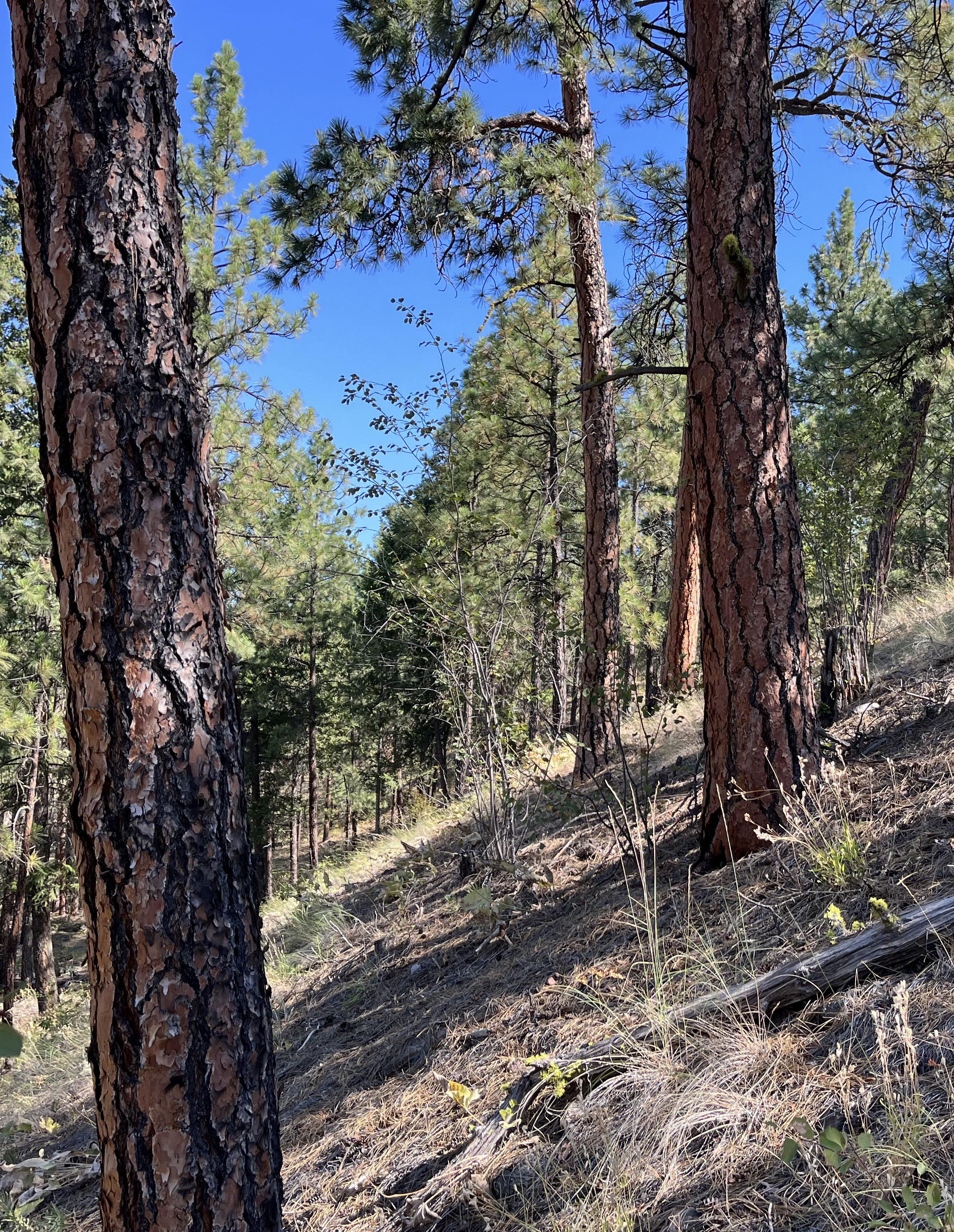
REFERENCES
1 The Corporation of the City of Penticton. Official Community Plan Bylaw No. 2019-08. OCP 2045. Policy statement 4.4.2.5, p. 4-76.
2 i-Tree Cooperative. 2021. i-Tree Canopy Version 7.1. [software]. https://canopy.itreetools.org/
3 Akbari, H., D. Kurn, et al. 1997. Peak power and cooling energy savings of shade trees. Energy and Buildings 25:139–148.
4 Kurn, D., S. Bretz, B. Huang, and H. Akbari. 1994. The Potential for Reducing Urban Air Temperatures and Energy Consumption through Vegetative Cooling (PDF) (31 pp, 1.76MB). ACEEE Summer Study on Energy Efficiency in Buildings, American Council for an Energy Efficient Economy. Pacific Grove, California.
5 BC Coroners Service. 2022 (June 7). Extreme Heat and Human Mortality: A Review of Heat-Related Deaths in B.C. in Summer 2021. Report to the Chief Coroner of British Columbia. https://www2.gov.bc.ca/assets/gov/ birth-adoption-death-marriage-and-divorce/deaths/ coroners-service/death-review-panel/extreme_heat_ death_review_panel_report.pdf
6 Sarkar, Chinmoy; Chris Webster; Matthew Pryor; Dorothy Tang; Scott Melbourne; Xiaohu Zhang; Lie Jianzheng. (2015). Exploring Associations between Urban Green, Street Design and Walking: Results from the Greater London Boroughs. Landscape and Urban Planning. 143 (November 2015): 112-125.
7 Takano, Nakamura, and Watanabe, “Urban Residential Environments and Senior Citizens’ Longevity in Megacity Areas: The i mportance of Walkable Green Spaces.”
8 Chi, Dengkai; Raf Aerts; An Van Nieuwenhuyse; Mariska Bauwelink; Claire Demoury; Michelle Plusquin; Tim S Nawrot; Lidia Casas; Ben Somers. (2022). Residential Exposure to Urban Trees and Medication Sales for Mood Disorders and Cardiovascular Disease in Brussels, Belgium. Environmental Health Perspectives. 130(5):57003.
9 Chi et al., “Residential Exposure to Urban Trees and Medication Sales for Mood Disorders and Cardiovascular Disease in Brussels, Belgium.”
10 Nasmith, H. (1962). Late Glacial History and Surficial Deposits of the Okanagan Valley, British Columbia. Bulletin No. 46: Department of Mines and Petroleum Resources. Queen’s Printer: Victoria, BC. 46 pp.
11 Alley, N.F. (1976). The palynology and palaeoclimatic significance of a dated core of Holocene peat, Okanagan Valley, southern British Columbia. Canadian Journal of Earth Sciences, 13(8): 1131-1144.
12 Environment Canada. [n.d.] Penticton A. Canadian Climate Normals 1981-2010. Retrieved November 20, 2023.
13 Regional District North Okanagan, Regional District of Central Okanagan, Regional District OkanaganSimilkameen, and Pinna Sustainability. (2020). Climate Projections for the Okanagan Region (February 2020). Pacific Climate i mpacts Consortium, University of Victoria: Victoria, BC. 61 pp.
14 Domke, G.M., C.J. Fettig, A.S. Marsh, M. Baumflek, W.A. Gould, J.E. Halofsky, L.A. Joyce, S.D. LeDuc, D.H. Levinson, J.S. Littell, C.F. Miniat, M.H. Mockrin, D.L. Peterson, J. Prestemon, B.M. Sleeter, and C. Swanston. (2023). Ch. 7. Forests. i n: Fifth National Climate Assessment. Crimmins, A.R., C.W. Avery, D.R. Easterling, K.E. Kunkel, B.C. Stewart, and T.K. Maycock, Eds. U.S. Global Change Research Program, Washington, DC, USA.
15 Condon, Laura E., Adam L. Atchey & Reed M. Maxwell. (2020). Evapotranspiration depletes groundwater under warming over the contiguous United States. Nature Communications 11, 873 (2020).
16 Marc-André Parisien, Quinn E. Barber, Mathieu L. Bourbonnais, Lori D. Daniels, Mike D. Flannigan, Rober W. Gray, Kira M. Hoffman, Piyush Jain, Scott L. Stephens, Steve W. Taylor & Ellen Whitman. (2023). Abrupt, climate-induced increase in wildfires in British Columbia since the mid-2000s. Communications Earth & Environment 4, 309 (2023).
17 Santamour, Frank S., Jr. (1990). Trees for urban planting: Diversity, uniformity, and common sense. Proceedings of the 7th Conference of the Metropolitan Tree i mprovement Alliance. 7:57-65.
18 Nesbitt L, Meitner MJ, Girling C, Sheppard SRJ, Lu Y. (2019). Who has access to urban vegetation? A spatial analysis of distributional green equity in 10 US cities. Landscape and Urban Planning. 2019 Jan.;, 181:51–79.
19 King KL, Johnson S, Kheirbek i, Lu JWT, Matte T. (2014). Differences in magnitude and spatial distribution of urban forest pollution deposition rates, air pollution emissions, and ambient neighborhood air quality in New York City. Landscape and Urban Planning. 2014 Aug.;128:14–22.
20 Nyelele C, Kroll CN. (2020). The equity of urban forest ecosystem services and benefits in the Bronx, NY. Urban Forestry & Urban Greening. 2020 Aug;53:126723.
21 Garrison JD. (2018). Environmental Justice in Theory and Practice: Measuring the Equity Outcomes of Los Angeles and New York’s “Million Trees” Campaigns. Journal of Planning Education and Research. 2018 May
87 City of Penticton | Urban Forest Management Plan (DRAFT - JUNE 2024)
22 American Forests. (2021). Tree Equity Score Methodology [Website]. American Forests. [cited 2023 Nov 27]. Available from: https://treeequityscore.org/
23 Leff, Michael. (2016). The Sustainable Urban Forest Guide: A Step-by-Step Approach. Davey i nstitute / USDA Forest Service, USFS Philadelphia Field Station. 102 pp.
24 Landry, Shawn; Ruiliang Pu. (2020). The impact of land development regulation on residential tree cover: An empirical evaluation using high-resolution iKONOS imagery. Landscape and Urban Planning, 94(2): 94-104.
25 Clark, Chris; Camilo Ordóñez, Stephen J. Livesley. (2020). Private tree removal, public loss: Valuing and enforcing existing tree protection mechanisms is the key to retaining urban trees on private land. Landscape and Urban Planning, 203 (November 2020): 103899.
26 Hauer, Richard J; Andrew K. Koeser; Stephani Parbs; Jim Kringer; Randy Krouse; Ken Ottman; Robert W. Miller; David Sivyer; Nilesh Timilsina; Les P. Werner. (2020). Long-term effects and development of a tree preservation program on tree condition, survival, and growth. Landscape and Urban Planning. 193 (January 2020): 103670.
27 Mahony, Colin R.; Will H. Mackenzie; Sally N. Aitken. (2018). Novel climates: Trajectories of climate change beyond the boundaries of British Columbia’s forest management knowledge system. Forest Ecology and Management 410, February 2018: 35-47.
28 Davis, Kimberley T.; Solomon Z. Dobrowski; Philip E. Higuera; Zachary A. Holden; Thomas T. Veblen; Monica T. Rother; Sean A. Parks; Anna Sala; and Marco P. Maneta. (2019). Wildfires and climate change push low-elevation forests across a critical climate threshold for tree regeneration. Biological Sciences 116(13): 6193-6198.
29 Phillips DH, Burdekin DA. 1982. Diseases of Bark and Trunk – Sooty bark disease caused by Cryptostroma corticale. i n: Diseases of Forest and Ornamental Trees, pp. 254–256. Houndmills, Basingstoke, Hampshire: The Macmillan Press Ltd.
30 Williams, A. Park; Craig D. Allen; Constance i. Millar; Thomas W. Swetnam; Joel Michaelsen; Christopher J. Still; and Steven W. Leavitt. (2010). Forest responses to increasing aridity and warmth in the southwestern United States. Biological Sciences 107 (50): 2128921294.
31 Nowak, David J., Eric. J. Greenfield. (2020). “The increase of impervious cover and decrease of tree cover within urban areas globally (2012-2017)”. Urban Forestry and Urban Greening 49 (2020): 126638.
32 Geiger, Jim. (2004). The Large Tree Argument: The Case for Large Trees vs. Small Trees. Western Arborist, 30 (1): 14-15. https://www.fs.usda.gov/psw/topics/urban_ forestry/products/cufr476_large_tree_argument.pdf
33 Rasmussen, Shaundra, Travis Warziniack, Abbye Neel, Jarlath O’Neil-Dunne, and Melissa McHale. (2021). When Small is Not Beautiful: The Unexpected i mpacts of Trees and Parcel Size on Metered Water-Use in a Semi-Arid City. Remote Sensing, 13, 998.
88 City of Penticton | Urban Forest Management Plan (DRAFT - JUNE 2024)
16;0739456X1877207.






































 Figure 10. Penticton’s conceptual forest corridors.
Figure 10. Penticton’s conceptual forest corridors.
























































